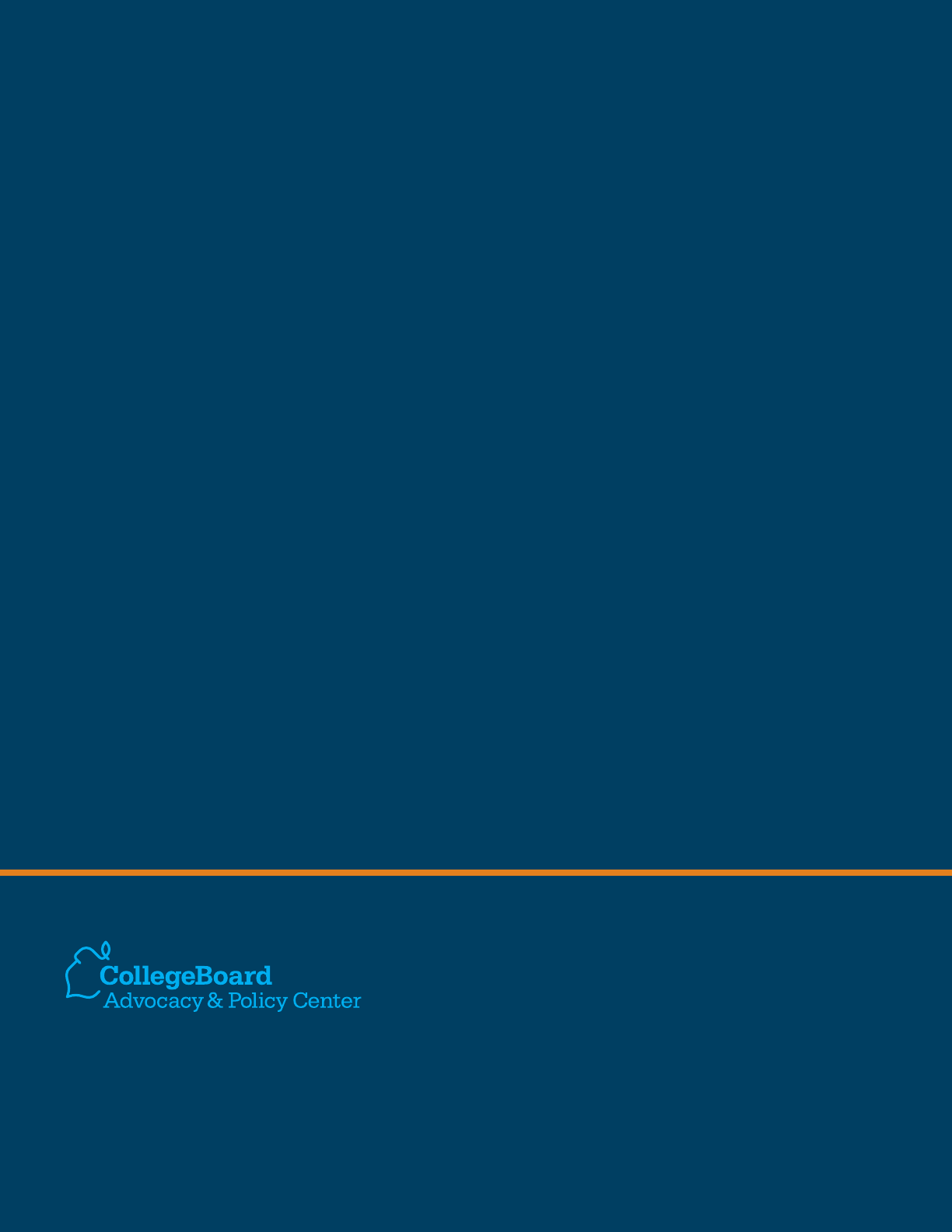
Public
Four-Year
Private
Nonprot
Four-Year
Private
Nonprot
Two-Year
Public
Two-Year
For-Prot
Two-Year
For-Prot
Four-Year
Trends in Higher Education Series
Trends in
College Pricing
2012

© 2012 The College Board. College Board, Advanced Placement Program, SAT and the acorn logo are registered trademarks of the
College Board. All other products and services may be trademarks of their respective owners. Visit the College Board on the Web:
www.collegeboard.org.
About the College Board
The College Board is a mission-driven not-for-prot organization that connects
students to college success and opportunity. Founded in 1900, the College
Board was created to expand access to higher education. Today, the membership
association is made up of over 6,000 of the world’s leading educational institutions
and is dedicated to promoting excellence and equity in education. Each year, the
College Board helps more than seven million students prepare for a successful
transition to college through programs and services in college readiness and
college success — including the SAT
®
and the Advanced Placement Program
®
.
Theorganization also serves the education community through research and
advocacy on behalf of students, educators and schools. For further information, visit
www.collegeboard.org.
College Board Advocacy & Policy Center
The College Board Advocacy & Policy Center was established to help transform
education in America. Guided by the College Board’s principles of excellence and
equity in education, we work to ensure that students from all backgrounds have the
opportunity to succeed in college and beyond. We make critical connections between
policy, research and real-world practice to develop innovative solutions to the most
pressing challenges in education today.
advocacy.collegeboard.org
See the Trends in Higher Education website at trends.collegeboard.org for
more data.
In addition to the gures and tables in this report, more information and data
can be found on the Trends website.
The online icon at the bottom of each page indicates additional gures and
tables that can be accessed by going to the website.

TRENDS IN HIGHER EDUCATION SERIES TRENDS IN COLLEGE PRICING 2012 3
Highlights
Widespread concern about the high and rising price of college
makes timely data on tuition increases in historical context
particularly important. The increase in average published tuition
and fees at public four-year colleges and universities for the
2012-13 academic year is smaller than it has been in recent
years — and below the average growth rate for the decade
from 2002-03 to 2012-13.
But the news about what students actually pay is less
encouraging. From 2008-09 to 2010-11, grant aid and tax
benets increased rapidly enough to cause the average net
prices to decline, even in the face of tuition increases. Through
unusually large increases in Pell Grants, grants for veterans, and
federal tax credits, the federal government increased its role in
nancing higher education, relieving the burden on students.
In contrast, the average net price paid by full-time students
enrolled in public four-year colleges increased measurably in
2012-13 for the third consecutive year. Average net price also
increased for public two-year and private nonprot four-year
students in 2011-12 and 2012-13, after three years of decline.
PUBLISHED TUITION AND FEE AND
ROOM AND BOARD CHARGES
Average published tuition and fees for in‑state
students at public four‑year colleges and
universities increased from $8,256 in 2011‑12
to $8,655 in 2012‑13. The 4.8% ($399) increase
in tuition and fees was accompanied by a
$325(3.7%) increase in room and board charges
for students living on campus. At $9,205, room
and board charges account for more than half of
the total charges for these students.
•Average published tuition and fees for out-of-state students at
public four-year institutions rose by $883 (4.2%), from $20,823 in
2011-12 to $21,706 in 2012-13. Average total charges are $30,911.
•Average published tuition and fees at private nonprot
four-year institutions rose by $1,173 (4.2%), from $27,883 to
$29,056 in 2012-13. Average total charges are $39,518.
•Average published tuition and fees at public two-year colleges
increased by $172 (5.8%), from $2,959 in 2011-12 to $3,131 in
2012-13.
•Estimated average tuition and fees for full-time students in the
for-prot sector increased by about $435 (3.0%), from $14,737
in 2011-12 to $15,172 in 2012-13.
•Published prices at public four-year institutions rose more
rapidly between 2002-03 and 2012-13 than over either of
the two preceding decades, but the average annual rate
of increase in ination-adjusted tuition and fees at private
nonprot four-year institutions declined from 4.6% from
1982-83 to 1992-93, to 3.0% from 1992-93 to 2002-03, and
to2.4% over the most recent decade.
•About two-thirds of full-time students pay for college with the
assistance of grant aid, and some of the remaining one-third
receive federal tax credits and deductions to help cover expenses.
VARIATION IN TUITION AND FEES
Half of all full‑time students at public and private
nonprot four‑year colleges attend institutions
charging tuition and fees of $10,282 or less; half
attend institutions with higher published prices.
•Thirteen percent of full-time students at public four-year
colleges and universities attend institutions that increased
their published prices by 9% or more in 2012-13; 24% attend
institutions that increased their prices by less than 3%.
•In the private nonprot four-year sector, 72% of full-time
students attend institutions that increased their tuition and
fees by between 3% and 6% in 2012-13; about 19% attend
institutions that increased their prices by less than 3%, while
about 2% faced increases of 9% or more.
•The average published tuition and fee price for undergraduates
enrolled at public master’s universities is 80% of the price at
public doctoral universities — $7,606 versus $9,539.
•The average published tuition and fee price for undergraduates
enrolled at private nonprot master’s universities is 73% of the
price at private doctoral universities — $25,997 versus $35,660.
Geographical differences: by region
•In 2012-13, average published tuition and fees for in-state
students at public four-year colleges range from $7,621 in the
South to $11,019 in New England.
•Average published tuition and fees for public two-year colleges
range from $2,241 in the West to $4,619 in New England.
•The percentage increase in public four-year tuition and fees over
the decade beginning in 2002-03 was over twice as large in the
West as in New England, but the average published price in the
West in 2012-13 is $2,289 lower than the price in New England.
•The largest percentage increase in public two-year college
tuition and fees over the decade beginning in 2002-03 was
82% in the West, which still has a lower published price than
any other region in 2012-13.
Geographical differences: by state
•In 2012-13, the highest published tuition and fee prices in both
public four-year and public two-year institutions are in New
Hampshire and Vermont. Tuition and fees average $14,576 and
$6,752 for public four-year and public two-year institutions,
respectively, in New Hampshire and $13,582 and $6,790 in
Vermont.
•The lowest published tuition and fee prices for public four-year
institutions are $4,278 in Wyoming and $5,595 in Utah.

4 TRENDS IN COLLEGE PRICING 2012 trends.collegeboard.org
•The lowest published tuition and fee prices for public two-year
colleges in 2012-13 are $1,418 in California and $1,537 in New
Mexico.
•In 2012-13, published tuition and fees for in-state students
at agship universities range from $4,278 in Wyoming and
$5,985 in Montana to $16,422 at the University of New
Hampshire and $17,266 at Penn State. In four states, the
agship price declined in constant dollars in 2012-13. The
largest increase was 13% in Washington.
•From 2007-08 to 2012-13, percentage increases in ination-
adjusted public four-year tuition and fees ranged from 2% in
Maryland and 3% in Ohio to 72% in California and 78% in Arizona.
Prices in Maryland and Ohio remain above the national average.
•From 2007-08 to 2012-13, percentage changes in ination-
adjusted public two-year tuition and fees ranged from a
decline of 3% in Maine and an increase of 1% in Montana to
increases of 49% in Virginia and 104% in California — which
still has the lowest prices in the country.
WHAT STUDENTS ACTUALLY PAY
In 2012‑13, full‑time undergraduates at public
four‑year institutions receive an estimated
average of $5,750 in grant aid from all sources and
federal tax benets to help them pay the average
$8,665 published tuition and fees. The students
pay an average net price of just over $2,900.
•Full-time undergraduates at private nonprot four-year institutions
receive an estimated average of $15,680 in grant aid from all sources
and federal tax benets to help them pay the average $29,056
published tuition and fees. The average net price is about $13,380.
•Full-time students at public two-year colleges receive an estimated
average of $4,350 in grant aid from all sources and federal tax
benets to help them pay the average $3,131 published tuition
and fees, as well as some of their other expenses.
•Average net tuition and fees paid by full-time students
enrolled in public two-year and in private nonprot four-year
institutions are lower in ination-adjusted dollars in 2012-13
than they were in 2007-08.
•About $1,410 of the $1,850 increase in average published
tuition and fees at public four-year colleges between 2007-08
and 2012-13 was covered by increases in grant aid and tax
benets, and the student share increased by about $440.
INSTITUTIONAL FINANCES
State appropriations per full‑time equivalent
(FTE) student declined by 10% in 2011‑12,
leaving this source of funding 25% below its level
ve years earlier, after adjusting for ination.
•Total state appropriations to public institutions declined by 3%
in constant dollars in 2010-11 and by another 11% in 2011-12.
•In 2009‐10, education (instruction and student services) and
related expenditures per FTE student ranged from $7,650 at
public two‐year colleges to $37,860 at private doctoral universities,
where about one‐third of all students are graduate students.
•At public two‐year colleges, education and related
expenditures declined from $8,640 per FTE student (in 2010
dollars) to $7,650 between 1999-2000 and 2009-10.
•In all sectors other than private doctoral universities, net
tuition and fee revenue grew more rapidly than education
and related expenditures between 1999‐2000 and 2009‐10.
The subsidies per full‐time equivalent (FTE) student — the
difference between education expenditures and net tuition
revenue — declined. In 2009‐10, average subsidies per FTE
student ranged from $980 at private master’s universities to
$17,260 at private doctoral universities.
•In both public and private colleges and universities, the
percentage of employees who were instructional staff members
was slightly higher in 2011 than in 1976, 1999, and 2009.
ENROLLMENT PATTERNS
Over the decade from 1999‑2000 to 2009‑10, the
percentage of all associate degrees awarded by
for‑prot institutions increased from 12% to 19%.
The percentage of all bachelor’s degrees awarded
by this sector increased from 2% to 6%, and its
percentage of all graduate degrees awarded
increased from 2% to 9%.
•In the decade from fall 2000 to fall 2010, the number of
full-time undergraduate students increased by 44%, from 7.9
million to 11.4 million. The number of part-time undergraduate
students increased by 27%, from 5.2 million to 6.6 million.
•In fall 2010, 13% of all FTE enrollment in degree-granting
public institutions was in California colleges and universities.
California, Texas, Florida, and New York enrolled one-third of all
FTE students attending public institutions in the U.S.
COLLEGE AFFORDABILITY
Over the entire income distribution in the United
States, real average family incomes in 2011 were
lower than they were a decade earlier. The largest
declines were for the families in the lowest 20%
of the population.
•Average income declined for all income groups every year from
2007 to 2010. It fell again in 2011 — by 1% to 2% — for each of
the four lower income groups, but increased by 3% for the 20%
of families with the highest incomes and by 7% for the top 5%.
•In 2011, the $100,096 median income for families headed by
a four-year college graduate was more than twice the median
income for families headed by a high school graduate.
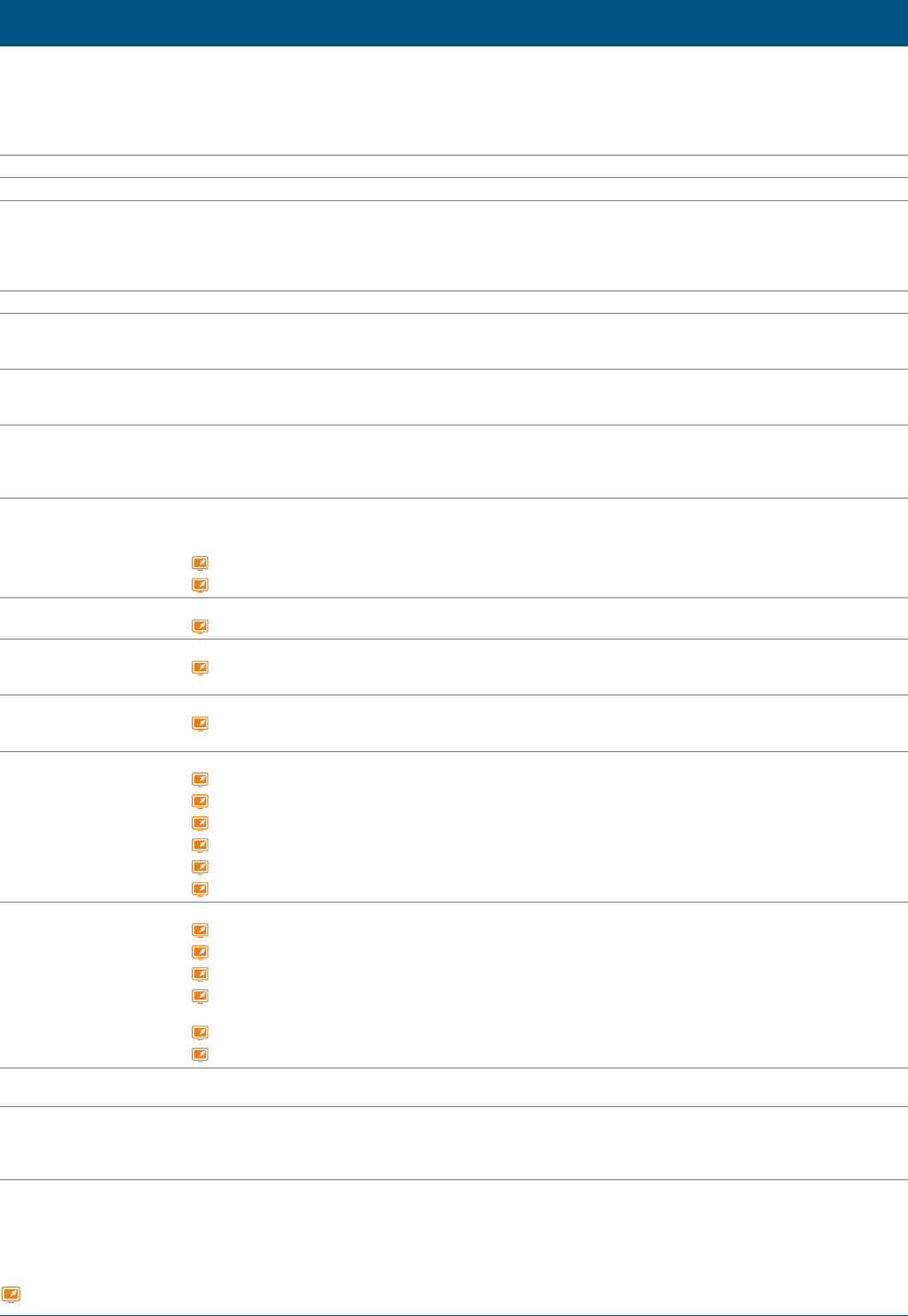
TRENDS IN HIGHER EDUCATION SERIES TRENDS IN COLLEGE PRICING 2012 5
Contents
3
Highlights
7
Introduction
10
Published
Tuition and Fee
and Room and
Board Charges,
2012‑13
TABLE 1A Average Published Undergraduate Charges by Sector, 2012‑13
TABLE 1B Average Published Undergraduate Charges by Carnegie Classication, 2012‑13
11
Student Budgets
FIGURE 1 Average Estimated Undergraduate Budgets, 2012‑13
12
Variation in
Published Tuition
and Fees, 2012‑13
FIGURE 2 Distribution of Students by Tuition and Fees
13
Variation in
Tuition and Fee
Increases, 2012‑13
FIGURE 3 Distribution of Students by Increases in Tuition and Fees
14
Tuition and Fee
and Room and
Board Charges
over Time
FIGURE 4 Average Rates of Growth of Tuition and Fees over Time
FIGURE 5 Published Tuition and Fees Relative to 1982‑83 by Sector
15
Tuition and Fee
and Room and
Board Charges
over Time
TABLE 2A Tuition and Fee and Room and Board Charges over Time, 1972‑73 through 2012‑13,
Selected Years
TABLE 2B Tuition and Fee and Room and Board Charges over Time, 2002‑03 through 2012‑13
TABLE 2 Tuition and Fee and Room and Board Charges over Time
TABLE 3 Tuition and Fee and Room and Board Charges over Time (Unweighted)
16
Regional Variation
in Charges
FIGURE 6 Average Published Prices by Region, 2002‑03 and 2012‑13
TABLE 4 Tuition and Fees by Region over Time
17
Tuition and Fees
by State: Public
Institutions
FIGURE 7 In‑State Tuition and Fees by State and Sector, 2012‑13 and 5‑Year Percentage Change
TABLE 5 Tuition and Fees by State and Sector over Time
18
Tuition and Fees
by State: Flagship
Universities
FIGURE 8 In‑State Tuition and Fees at Flagship Universities, 2012‑13 and 5‑Year Percentage Change
TABLE 6 Tuition and Fees at Flagship Universities over Time
19
Average Net
Price — Public
Institutions
FIGURE 9 Average Net Price for Full‑Time Students over Time — Public Institutions
TABLE 7 Average Net Price for Full‑Time Students over Time — Public Institutions
FIGURE 2011_8A Net Prices by Selectivity: Public Four‑Year Sector, 2007‑08
FIGURE 2011_8B Net Prices by Attendance Status: Public Two‑Year Sector, 2007‑08
FIGURE 2010_8A Net Prices by Income and State Residency: Public Four‑Year Sector, 2007‑08
FIGURE 2010_8B Net Prices by Income: Public Two‑Year Sector, 2007‑08
FIGURE 2009_8 Net Prices by Income over Time: Public Sector
20
Average Net
Price — Private
Institutions
FIGURE 10 Average Net Price for Full‑Time Students over Time — Private Institutions
TABLE 8 Average Net Price for Full‑Time Students over Time — Private Institutions
FIGURE 2011_9A Net Prices by Selectivity: Private Nonprot Four‑Year Sector, 2007‑08
FIGURE 2011_9B Net Prices by Attendance Status: For‑Prot Sector, 2007‑08
FIGURE 2010_9A Net Prices by Income and Level of Published Tuition and Fees: Private Nonprot Four‑Year
Sector, 2007‑08
FIGURE 2010_9B Net Prices by Income: For‑Prot Sector, 2007‑08
FIGURE 2009_9 Net Prices by Income over Time: Private Sector
21
Net Price
FIGURE 11A Sources of Gross Tuition Revenue per FTE Student over Time — Public Institutions
FIGURE 11B Sources of Gross Tuition Revenue per FTE Student over Time — Private Institutions
22
Institutional
Revenues
— Public
Appropriations
FIGURE 12A Annual Percentage Changes in State Appropriations and Public Four‑Year Prices over Time
FIGURE 12B Total and Per FTE Student State Appropriations and Public Enrollment over Time
Figures and tables that are available online only at trends.collegeboard.org.
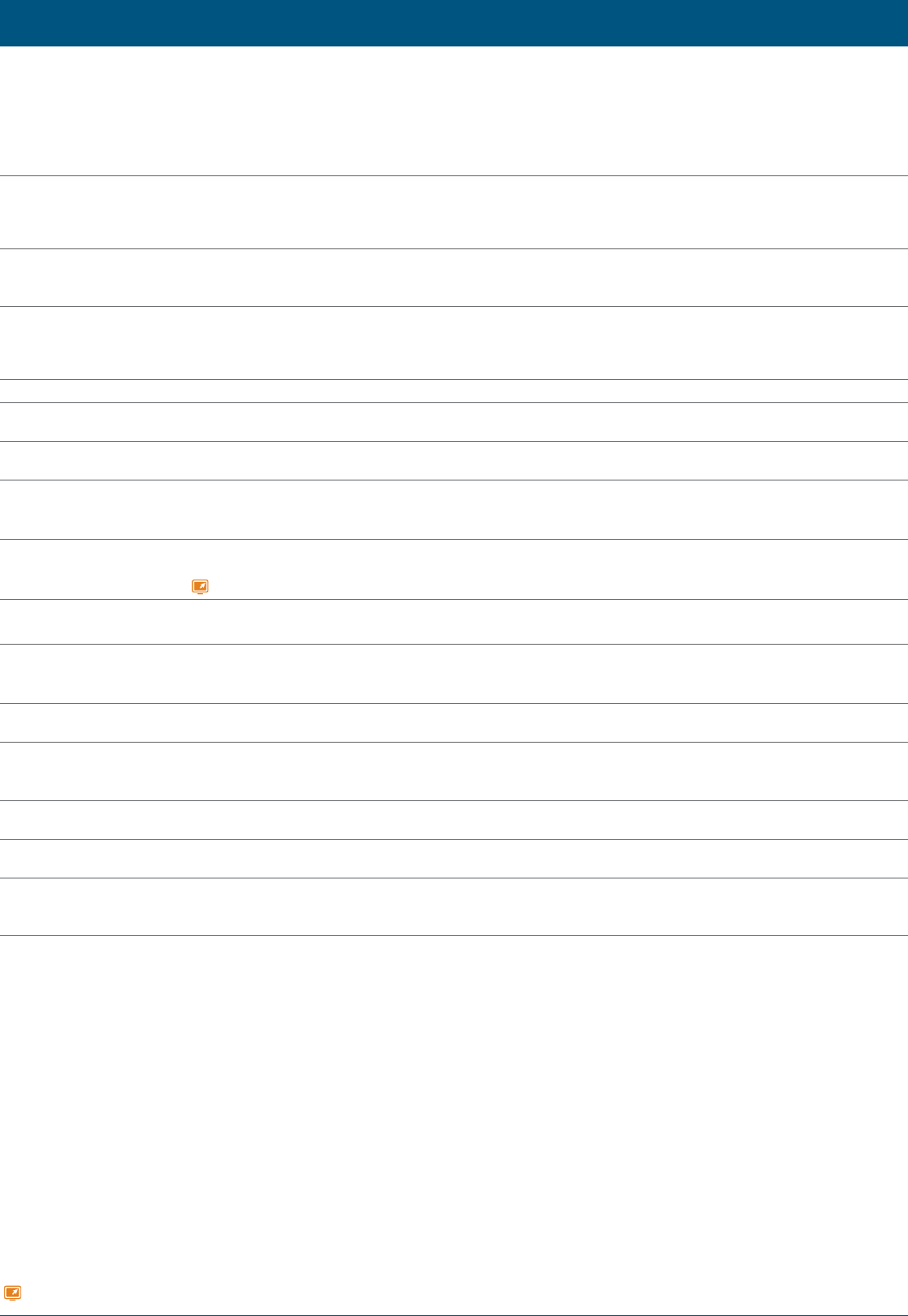
6 TRENDS IN COLLEGE PRICING 2012 trends.collegeboard.org
Contents — Continued
23
Institutional
Revenues
— Public
Appropriations
FIGURE 13A State Appropriations per $1,000 in Personal Income over Time
FIGURE 13B State Appropriations per $1,000 in Personal Income by State, 2011‑12 and 5‑Year
Percentage Change
24
Institutional
Revenues
FIGURE 14A Revenue Sources at Public Institutions over Time
FIGURE 14B Revenue Sources at Private Institutions over Time
FIGURE 14C Revenues from Private Gifts, Investment Returns, and Endowment Income
25
Institutional
Revenues and
Expenditures
FIGURE 15A Net Tuition Revenues, Subsidies, and Education Expenditures per FTE Student over Time
at Public Institutions
FIGURE 15B Net Tuition Revenues, Subsidies, and Education Expenditures per FTE Student over Time
at Private Nonprot Institutions
26
Endowments
FIGURE 16 Endowment Assets per FTE Student, 2010‑11
27
Endowments
FIGURE 17A Changes in Private Sector Endowment Assets over Time
FIGURE 17B Endowment Spending Rates over Time
28
Family Income
FIGURE 18A Changes in Family Income over Time
FIGURE 18B Family Income by Selected Characteristics, 2011
29
Enrollment
Patterns over
Time
FIGURE 19 Enrollment by Attendance Status over Time
30
Enrollment and
Degrees Granted
FIGURE 20 Degrees Granted by Sector over Time
FIGURE 21 Distribution of Full‑Time Undergraduates and of All Undergraduates by Sector, Fall 2010
FIGURE 2010_20B Online Course Participation over Time
31
Enrollment by
State
FIGURE 22A FTE Enrollment at Public Institutions by State, Fall 2010
FIGURE 22B Percentage of All Public FTE Enrollment in Two‑Year Colleges, Fall 2010
32
Changes in
Enrollment by
State
FIGURE 23 Percentage Increases in Total Public FTE Enrollment by State
33
Migration
FIGURE 24A Percentage of U.S. First‑Year Students Who Were State Residents, Fall 2000 to Fall 2010
FIGURE 24B Percentage of First‑Year Students Who Were State Residents, by State, Fall 2010
34
Selectivity and
Completion
FIGURE 25A Distribution of Four‑Year Institutions by Acceptance Rate, Fall 2010
FIGURE 25B Distribution of FTE Undergraduates at Four‑Year Institutions by Acceptance Rate, Fall 2010
FIGURE 25C Graduation Rate by Acceptance Rate, Fall 2010
35
Faculty and Staff
FIGURE 26A FTE Staff per 100 FTE Students over Time
FIGURE 26B Composition of FTE Staff over Time
36
Faculty and Staff
FIGURE 27A Changes in Faculty Compensation and in Tuition and Fees over Time
FIGURE 27B Percentage of Instructional Faculty Employed Full‑Time over Time
37
Notes and
Sources
TABLE A1A Institutions Included in Table 1A Analysis
TABLE A1B Institutions Included in Table 1B Analysis
TABLE A2 Consumer Price Index
Figures and tables that are available online only at trends.collegeboard.org.

TRENDS IN HIGHER EDUCATION SERIES TRENDS IN COLLEGE PRICING 2012 7
Introduction
As we report on another year of increases in the published
tuition and fee prices of colleges and universities around the
country, it is important to step back to gain some historical
perspective on these prices and the forces driving them.
The majority of students enroll in public colleges and
universities, and it is the prices of these institutions that are of
greatest concern from a public policy perspective. The public
four-year sector accounts for 36% of all (and 44% of full-time)
undergraduate students, and the public two-year sector accounts
for 40% of all (and 26% of full-time) undergraduate students.
Prices at public two-year colleges remain relatively low. In
2012-13, the national average of $3,131 tuition and fees for a
full-time student at a public two-year college is just 36% of the
average published tuition and fees at public four-year institutions.
Moreover, on average, two-year public college students receive
enough nancial aid to cover their tuition payments — with
some funds left over to apply to other expenses. Low tuition
is vital in this sector, which is the gateway to postsecondary
education for many low-income and rst-generation students
who have very limited resources and little or no familiarity
with higher education systems and processes. Many students
enroll in public two-year colleges with inadequate academic
preparation for college-level work, and low prices make their
postsecondary undertakings less risky.
The 4.8% increase in the published price of tuition and fees
at public four-year colleges and universities this year is the
smallest since 2000-01 — and the smallest in ination-adjusted
dollars since 2008-09 (when ination was particularly high). It
is smaller than the 5.8% increase for public two-year colleges,
but higher than the 4.2% increase at private nonprot four-year
colleges and universities. However, the growth in published
prices at public four-year institutions has been higher over the
past decade (averaging 5.2% per year beyond ination) than
over either of the two preceding decades. Published prices
have risen more rapidly in this sector than in the other sectors
over both the past ve years and the past 10 years. The average
tuition and fee price at public four-year colleges was $5,213
(in2012 dollars) in 2002-03 and is $8,655 today.
PAST AND FUTURE
It would likely be wrong to assume that price increases will
keep accelerating. After a 9.3% real increase in 2009-10, the
growth rate has declined in each successive year. Similarly,
large increases from 2002-03 through 2004-05 were followed by
more moderate growth in prices. The same pattern occurred in
1990-91 through 1993-94 and before that, 1982-83 and 1983-84.
As Figure 12A shows, state appropriations for public higher
education are cyclical, and tuition prices show similar cycles.
As Figures 9 and 10 show, the difference between published
tuition and fee prices and the average net prices that students
pay has grown over time as nancial aid programs have come
to play a larger role. In particular, from 2008-09 to 2010-11,
the federal government markedly increased its funding for
students, causing average net prices for students to fall in
years when tuition was rising rapidly. But that trend will not
continue. Concern over federal budget decits is growing, and
while support for existing levels of student aid is strong, it is
difcult to imagine continued growth in student aid programs
that would compensate for future tuition increases to any
signicant extent.
College enrollments have grown rapidly in recent years. In
the decade from 2001-02 to 2011-12, the number of full-time
undergraduate students increased by 37%, from 8.6 million to
11.8 million. The number of part-time undergraduate students
increased by 24%, from 5.5 million to 6.8 million. This growth
is partly a result of the weak labor market that has made school
a more appealing alternative and partly a result of the growing
gap between the earnings of workers who have college
degrees and those who do not.
Although the trend in rapid enrollment growth has already
tapered off, it was met by a signicant decline in per-student
funding. If we are to meet the needs of our citizens and our
economy for increased postsecondary attainment, state
budgets will have to give a higher priority to education in the
coming years.
We must also pursue innovative ways of increasing efciency
on college campuses and providing quality education to large
numbers of students. Efforts are well under way to develop
lower-cost methods of delivering college courses. It is too early
to say whether or not these efforts will revolutionize higher
education, or which segments of our diverse and multipurpose
postsecondary education system will be most affected.
It is revenue shortages rather than expenditure growth that
have driven the recent rapid rises in public college prices.
Nonetheless, for the millions of Americans dependent on
colleges and universities to improve their prospects for fullling
and secure lives, cost reductions that are reected in slower
growth in prices are critical.
The data provided in Trends in College Pricing can inform
policymakers, researchers, and others in their analyses of these
issues. The companion publication, Trends in Student Aid,
contains detailed information about the nancial aid that helps
students and families pay these prices. The Trends website
(trends.collegeboard.org) makes data easily available for
reference and downloading.

8 TRENDS IN COLLEGE PRICING 2012 trends.collegeboard.org
PUBLISHED PRICES
The published prices on which Trends in College Pricing is
based come from data reported by institutions on the College
Board’s Annual Survey of Colleges. This survey, which is
distributed to nearly 4,000 postsecondary institutions across
the country, collects a wealth of data on enrollment, admission,
degrees and majors, tuition, nancial aid, and other aspects of
undergraduate education.
The prices reported here are averages for one year of full-time
undergraduate enrollment. About 36% of all undergraduates
and 60% of those attending public two-year colleges are
enrolled part-time. Because of the variety of enrollment and
pricing patterns, it is not possible to provide estimates of the
charges facing these students that would be as accurate as the
information we provide about full-time students.
The prices included in Trends in College Pricing represent best
estimates of average prices for all full-time undergraduate
students. However, a growing number of institutions charge
different prices for different years of study and/or for different
academic majors. We are able to incorporate differences in
prices by year of study reported to us by individual institutions,
but not differences by programs. Another complexity that has
developed in recent years is that more and more two-year
colleges are offering a small number of four-year degrees or
providing course work that leads to four-year degrees awarded
on other campuses. While we make every effort to adjust our
methodology to accommodate these changes, it is impossible
to draw precise lines between sectors and to develop exact
measures in all cases.
Trends in College Pricing 2012 presents detailed pricing data
for public two-year and four-year and private nonprot four-year
institutions for the 2012-13 academic year. While we provide
an estimate of the average charges at for-prot institutions,
because of the relatively small sample of those institutions from
which we are able to collect data, it is important to interpret that
information with caution.
Finally, when interpreting college prices, it is important to
remember that Trends in College Pricing reports on the price of
one year of college. Many students require more than two years
of study to earn an associate degree or more than four years of
study to earn a bachelor’s degree. It is critical to consider the
total price for all years of study when thinking about what is
required to pay for college. There is considerable variation across
sectors as well as among institutions within sectors in both
average time to degree and overall graduation rates.
TUITION AND FEES VERSUS TOTAL
CHARGES
Some of the graphs in this report focus only on tuition and
fees, but we also report room and board charges for residential
students, living costs for commuter students, and other
components of student budgets. Whether students live on or off
campus, they all must pay for housing and food, buy books and
supplies, and cover transportation and other basic living costs.
Room and board and other living costs are not really part of
the cost of attending college. These are expenses people
face whether or not they are in school. The largest real cost
many students face is forgone earnings. It is very difcult to
succeed in college while working full-time. However, the cost of
students’ time is difcult to measure, and we make no attempt
to do so in this report. Because students tend to think of living
expenses as part of the cost of going to college, and because
they must come up with the funds to cover these outlays, it is
useful to use these expenses as a proxy for forgone earnings.
The cost of living poses a signicant hurdle for many students.
Even those who receive grant aid sufcient to cover tuition and
fee charges may struggle to cover living expenses. It is not so
much the prices charged by institutions, but the very real costs
students incur by devoting their time to school and forgoing the
income needed to support themselves and their families while
in school that create the burden for these students.
NET PRICES: WHAT STUDENTS
ACTUALLY PAY
Although it is generally the published prices that make
headlines, it is the net prices paid by individual students that
matter most for college access and affordability. We estimate
that in 2012-13, while the average published tuition and fee price
at public four-year institutions is $8,655, the average net price
is just over $2,900. Grants and tax credits and deductions cover
the remainder for the average full-time student. Over the past
ve years, the average published price has increased by 27% in
real terms, while the average net price has increased by 18%.
The denition of “net price” we use is the average price paid
by all full-time students — including those who do and do
not receive student aid — after subtracting grant aid from all
sources in addition to federal tax credits and deductions. Data
on prices from the Annual Survey of Colleges and on student
aid from Trends in Student Aid allow us to generate new,
updated estimates for average net prices by sector each year.
Only data from the National Postsecondary Student Aid Study

TRENDS IN HIGHER EDUCATION SERIES TRENDS IN COLLEGE PRICING 2012 9
allow us to estimate net prices for students at different income
levels enrolled in different types of institutions, and no data are
available from this source to update the 2007-08 information
published in earlier editions of Trends. We have, however,
included information on net tuition payments by students at
different types of institutions, based on data from the Delta
Cost Project. These net prices cannot easily be compared to our
annual net price calculations because they cover payments by
all students — full-time and part-time, in-state and out-of-state,
graduate and undergraduate. But they provide an important
additional perspective on the portion of gross tuition revenue
paid by students and the portion being covered by institutional
grant aid (discounts), and federal and state grant aid.
HOW COLLEGE PRICES ARE CHANGING
The data in this report conrm the widespread perception that
published college prices are rising more rapidly than the prices
of other goods and services. This is not a new phenomenon, but
one that has persisted over the decades documented here. Only
about one-third of full-time students pay the full published tuition
price with no grant assistance, but the prices these students
pay have increased very rapidly. In addition, the nontuition
expenses associated with going to college continue to rise, and
grant aid is rarely sufcient to meet those costs.
Another very signicant issue is that, as documented in Figure
18A, incomes have declined over the past decade for families at
all levels of the income distribution. In addition, families have not
been able to plan for the uctuations in the value of the assets
they have saved to pay for college. Rising tuition levels cause
even more problems because of the economic environment in
which they are occurring.
Neither changes in average published prices nor changes in
average net prices necessarily describe the circumstances facing
individual students. There is considerable variation in prices
across sectors and across states and regions as well as among
institutions within these categories. College students in the
United States have a wide variety of educational institutions from
which to choose, and these come with many different price tags.
Moreover, different students may pay different prices at the same
institution. One of the problems many students face is how to
make sense of all the options and complex pricing structures.
Annual percentage increases in tuition and fees consistently
receive most of the attention, but the actual price level and
dollar increases in the price level matter most to students and
families. Small percentage increases at colleges and universities
with high tuition and fee levels may translate into large dollar
increases. At lower-priced institutions, larger percentage
increases have less impact on affordability.
Rapidly rising postsecondary enrollments indicate that students
are nding ways to nance their education and are largely
explained by the understanding that more education generally
leads to higher earnings throughout life. Nonetheless, the
reality is that more students and families are struggling to pay
for higher education, both during the college years and in the
following years when education loans must be repaid.
THE CONSUMER PRICE INDEX
We provide much of our data in constant dollars, adjusting
values for changes in the Consumer Price Index (CPI). We use
the change in the CPI from July 2011 to July 2012 to compare
the price level for academic year 2012-13 to earlier prices. A
decline in the CPI of 2.1% from 2008-09 to 2009-10 followed
an increase of 5.6% in the preceding year. The CPI increased by
1.2% in 2010-11, by 3.6% between July 2010 and July 2011, and
by 1.4% from July 2011 to July 2012.
A NOTE ON TRENDS DATA
While the information reported here provides a best
approximation of trends in college charges over time, we caution
readers about placing too much reliance on either precise dollar
amounts or precise annual percentage changes. Each year we
revise the average prices calculated the previous year to account
for corrected data we receive from institutions and to provide
an enrollment-weighted average based on the most recent
available data on the number of full-time students attending
each institution. If, over time, increasing numbers of students
were to enroll in the lower-priced institutions within a sector, our
measure of the average price increase would be lower than if
enrollment were stable. Details relating to our methodology and
to other technical issues and data reliability can be found at the
end of the report, in the Notes and Sources section.
The tables supporting all of the graphs in the Trends
publications, PDF versions of the publications, PowerPoint
les containing individual slides for all of the graphs, and other
detailed data on student aid and college pricing are available on
our website at trends.collegeboard.org. Please feel free to cite
or reproduce the data in Trends for noncommercial purposes
with proper attribution.
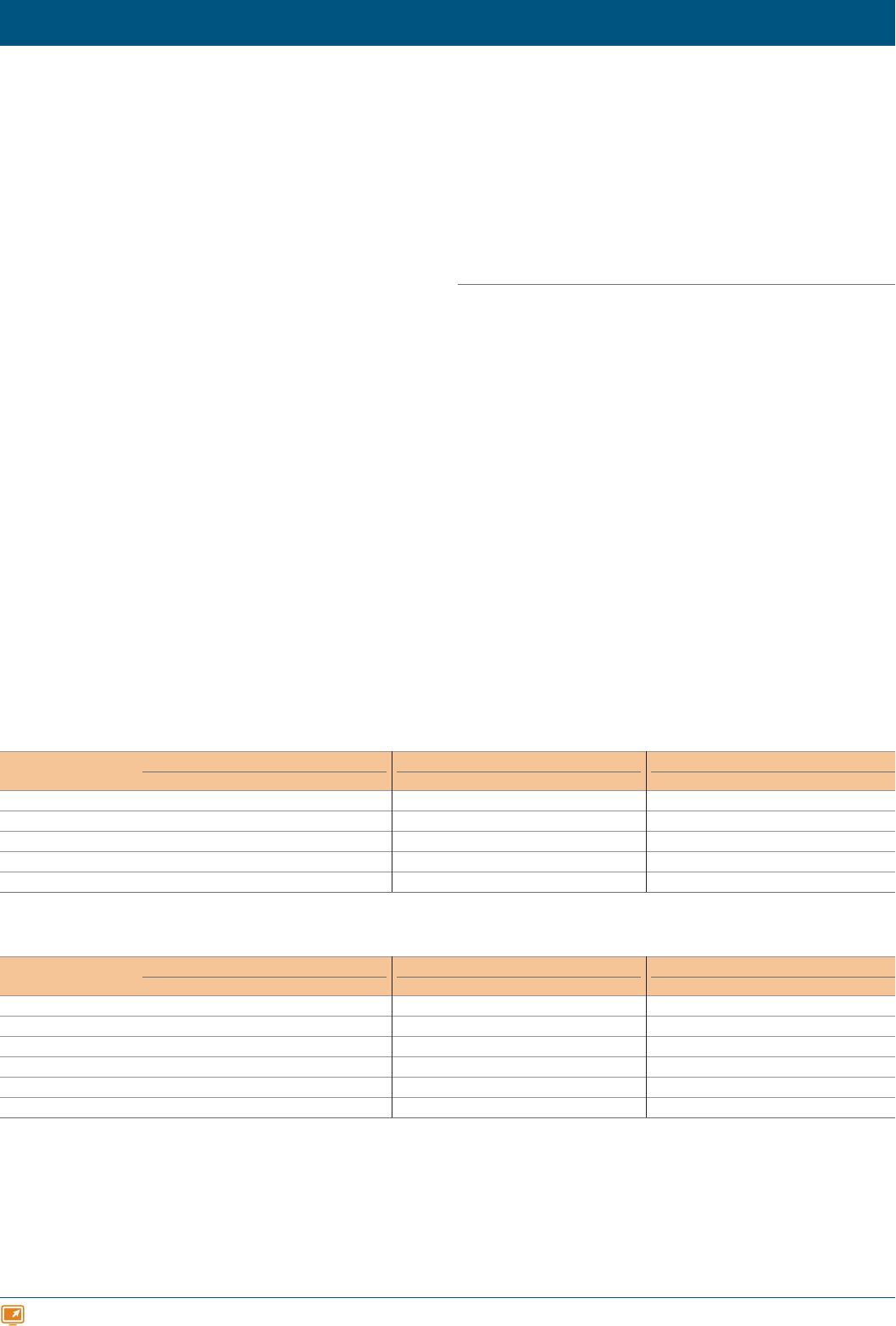
10 TRENDS IN COLLEGE PRICING 2012 trends.collegeboard.org
Published Tuition and Fee and Room and
Board Charges, 2012-13
Average published tuition and fees for in‑state students at public four‑year colleges and universities
increased from $8,256 in 2011‑12 to $8,655 in 2012‑13. The 4.8% increase in tuition and fees followed
increases of 8.4% in 2011‑12 and 8.0% in 2010‑11.
•In 2012-13, the percentage increase in published prices for
out-of-state students was 4.2%, smaller than that for state
residents at public four-year institutions. Still, the dollar gap in
the two prices increased from $12,567 to $13,051.
•The $172 increase in average published tuition and fees for
full-time students at public two-year colleges reected a 5.8%
increase from $2,959 in 2011-12 to $3,131 in 2012-13.
•The $1,173 increase in average published tuition and fees for full-
time students at private nonprot four-year institutions reected
a 4.2% increase from $27,883 in 2011-12 to $29,056 in 2012-13.
•Data on charges at for-prot institutions are incomplete, but
tuition and fees in this sector rose by an estimated 3.0%, from
$14,737 in 2011-12 to $15,172 in 2012-13.
•The average published tuition and fee price for full-time in-state
undergraduates at public master’s universities is 80% of the
price at public doctoral universities — $7,606 versus $9,539.
•The average published tuition and fee price for full-time
undergraduates at private nonprot master’s universities is
73% of the price at private nonprot doctoral universities —
$25,997 versus $35,660.
ALSO IMPORTANT:
•About 13% of full-time public four-year undergraduate students study
out of state, but many states have reciprocity agreements with
neighboring states that allow students to pay less than the published
prices for nonresident students.
•About two-thirds of undergraduate students enrolled full-time receive
grants that reduce the actual price of college. In addition, many states
and institutions grant tuition waivers to groups such as veterans,
teachers, or dependents of employees. See Figures 9 and 10 for
estimates of net prices paid by students and Trends in Student Aid
2012 for details about student aid.
•The total price of a college education depends on how long a student
is enrolled before completing a degree. Many students spend more
than four years earning a bachelor’s degree. Average time to degree is
longer in public than in private nonprot colleges.
•In fall 2011, 60% of students at public two-year colleges were enrolled
part-time, as were 23% of undergraduates at public four-year, 17% at
private nonprot four-year, and 24% at for-prot institutions. (National
Center for Education Statistics [NCES], unpublished IPEDS data)
TABLE 1A Average Published Charges for Full-Time Undergraduates by Type and Control of Institution, 2012-13 (Enrollment-Weighted)
Tuition and Fees Room and Board Total Charges
Sector 2012-13 2011-12 $ Change % Change 2012-13 2011-12 $ Change % Change 2012-13 2011-12 $ Change % Change
Public Two-Year In-State $3,131 $2,959 $172 5.8% $7,419 $7,332 $87 1.2% $10,550 $10,291 $259 2.5%
Public Four-Year In-State $8,655 $8,256 $399 4.8% $9,205 $8,880 $325 3.7% $17,860 $17,136 $724 4.2%
Public Four-Year Out-of-State $21,706 $20,823 $883 4.2% $9,205 $8,880 $325 3.7% $30,911 $29,703 $1,208 4.1%
Private Nonprot Four-Year $29,056 $27,883 $1,173 4.2% $10,462 $10,088 $374 3.7% $39,518 $37,971 $1,547 4.1%
For-Prot $15,172 $14,737 $435 3.0% — — — — — — — —
— Sample too small to provide meaningful information.
TABLE 1B Average Published Charges for Full-Time Undergraduates by Carnegie Classication, 2012-13 (Enrollment-Weighted)
Tuition and Fees Room and Board Total Charges
Carnegie Classication 2012-13 2011-12 $ Change % Change 2012-13 2011-12 $ Change % Change 2012-13 2011-12 $ Change % Change
Public Doctoral In-State $9,539 $9,126 $413 4.5% $9,643 $9,314 $329 3.5% $19,182 $18,440 $742 4.0%
Public Master’s In-State $7,606 $7,207 $399 5.5% $8,511 $8,195 $316 3.9% $16,117 $15,402 $715 4.6%
Public Bachelor’s In-State $6,718 $6,433 $285 4.4% $8,736 $8,385 $351 4.2% $15,454 $14,818 $636 4.3%
Private Doctoral $35,660 $34,230 $1,430 4.2% $12,187 $11,763 $424 3.6% $47,847 $45,993 $1,854 4.0%
Private Master’s $25,997 $24,903 $1,094 4.4% $10,104 $9,738 $366 3.8% $36,101 $34,641 $1,460 4.2%
Private Bachelor’s $27,482 $26,427 $1,055 4.0% $9,494 $9,150 $344 3.8% $36,976 $35,577 $1,399 3.9%
NOTE: Prices reported for 2011-12 have been revised and may differ from those reported in Trends in College Pricing 2011. See Notes and Sources on p. 37 for
denitions of the institutional categories in Table 1B. Public two-year room and board charges are based on commuter housing and food costs. Tuition and fee
gures for the for-prot sector should be interpreted with caution because of the low response rate.
SOURCE: The College Board, Annual Survey of Colleges.
Enrollment-weighted tuition and fees weight the price charged by each institution by the number of full-time students enrolled in fall 2011.
Public four-year in-state charges are weighted by total fall 2011 full-time enrollment in each institution, including both in-state students and
out-of-state students. Out-of-state tuition and fees are computed by adding the average in-state price to the out-of-state premium weighted
by the number of full-time out-of-state students enrolled at each institution. Room and board charges are weighted by the number of
students residing on campus for four-year institutions and by the number of commuter students for public two-year institutions.
For detailed data behind the graphs and additional information, please visit: trends.collegeboard.org.
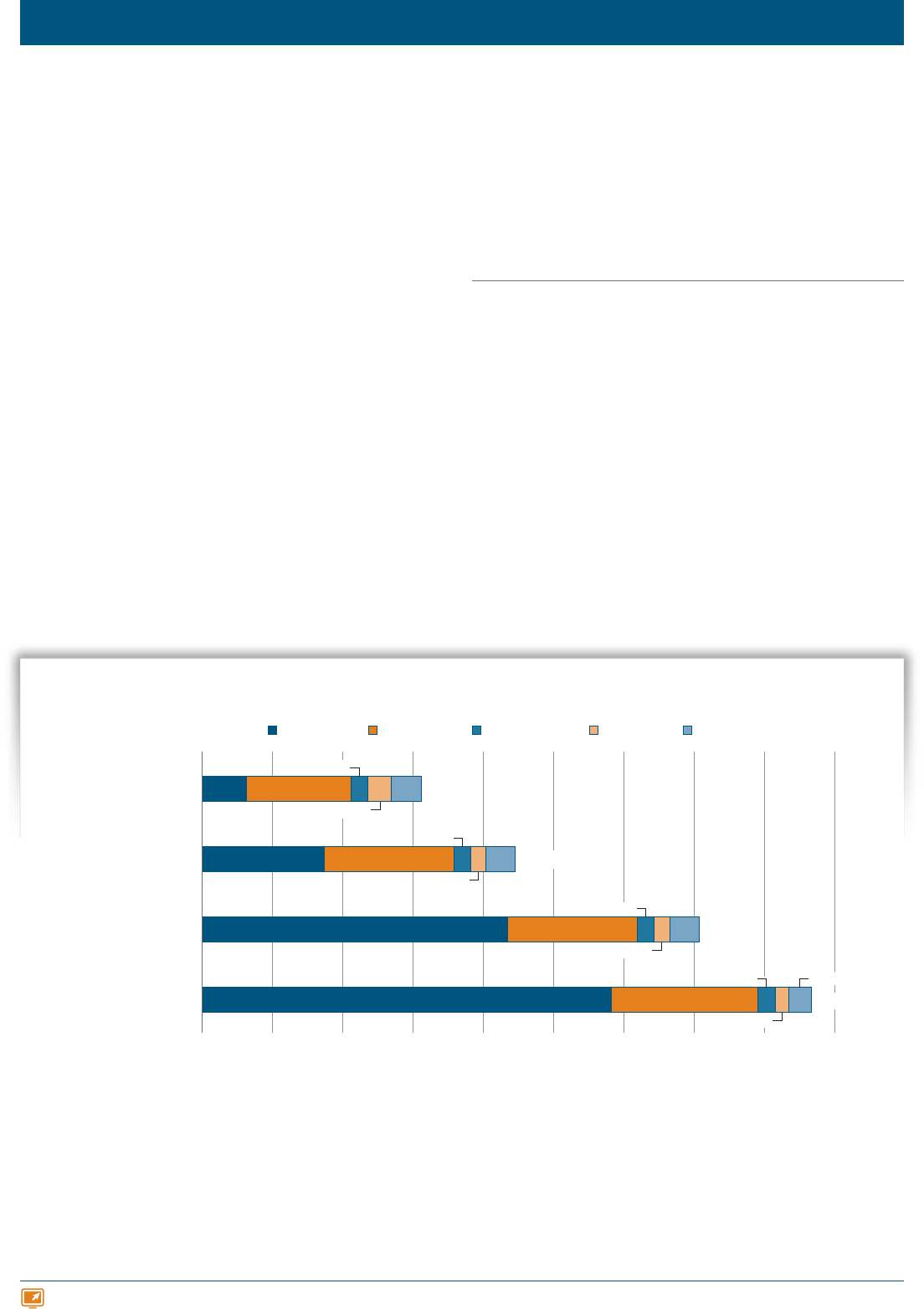
TRENDS IN STUDENT AID 2010 11TRENDS IN HIGHER EDUCATION SERIES TRENDS IN COLLEGE PRICING 2012 11
For detailed data behind the graphs and additional information, please visit: trends.collegeboard.org.
Student Budgets
FIGURE 1 Average Estimated Full-Time Undergraduate Budgets, 2012-13 (Enrollment-Weighted)
NOTE: Expense categories are based on institutional budgets for students as reported by colleges and universities in the Annual Survey of Colleges. They do
not necessarily reect actual student expenditures.
SOURCE: The College Board, Annual Survey of Colleges.
Tuition and fees constitute about 39% of the total budget for in‑state students living on campus at
public four‑year colleges and universities, and about 20% of the budget for public two‑year college
students who pay for off‑campus housing.
•Student budgets are constructed by institutional nancial aid
ofces. These budgets form the basis for determining the total
cost of attendance, which can affect the nancial aid for which
students are eligible.
•Tuition and fees differ more across sectors than room and board
and other components of student budgets. As a result, while
the average published tuition and fee price at public four-year
colleges is 2.8 times as high as the price at two-year public
colleges, the total student budget is only 1.4 times as high.
•The average published tuition and fee price at public four-year
colleges is about 30% of the average at private nonprot
four-year institutions, but the average student budget is
51%as high.
ALSO IMPORTANT:
•According to the National Association of College Stores,
expenditures on textbooks are declining as students
increasingly rely on textbook rentals, used books, and digital
resources. (www.nacs.org/advocacynewsmedia/pressreleases/
studentspendingontextbookscontinuestodecline.aspx)
$0 $5,000 $10,000 $15,000 $20,000 $25,000 $30,000 $35,000
$40,000
$45,000
Other ExpensesTransportationBooks and SuppliesRoom and BoardTuition and Fees
Private Nonprot Four-Year
On-Campus
Public Four-Year
Out-of-State On-Campus
Public Four-Year
In-State On-Campus
Public Two-Year
Commuter
Undergraduate Budget
$29,056
$21,706
$8,655
$3,131
$10,462
$9,205
$9,205
$7,419
$1,244
$1,200
$1,200
$1,229
$957
$1,110
$1,110
$1,648
$1,570
$2,091
$2,091
$2,157
$22,261
$15,584
$35,312
$43,289
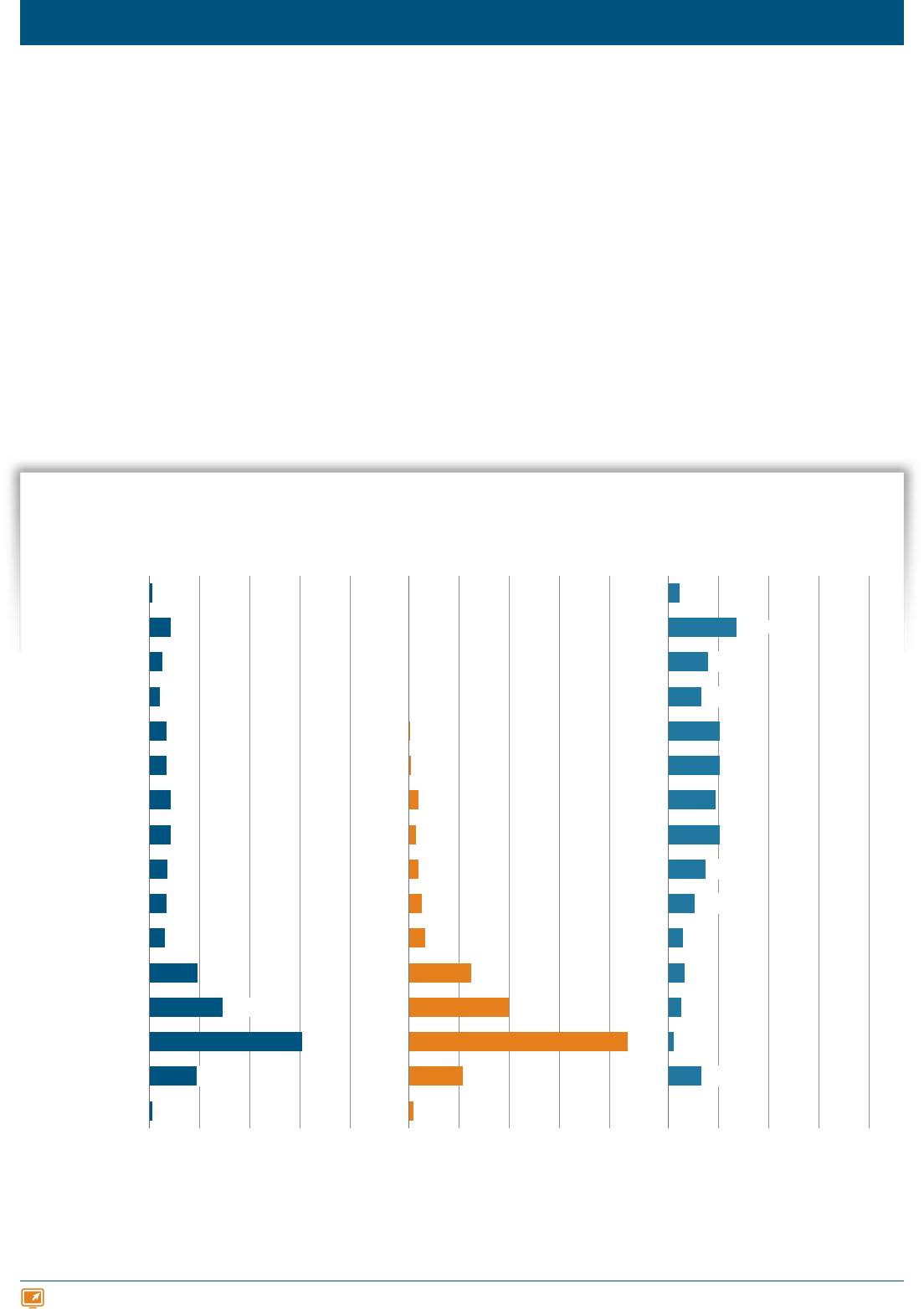
12 TRENDS IN COLLEGE PRICING 2012 trends.collegeboard.org
For detailed data behind the graphs and additional information, please visit: trends.collegeboard.org.
Variation in Published Tuition and Fees, 2012-13
Half of all full‑time undergraduates at public and private nonprot four‑year colleges and universities
attend institutions charging tuition and fees of $10,282 or less, and half attend institutions with
published tuition and fees of $10,282 or more.
•The median full-time public four-year
undergraduate, including both in-state
and out-of-state students, is enrolled
at an institution with published tuition
and fees of $8,672, while the median
full-time undergraduate in the private
nonprot four-year sector faces
published charges of $30,200.
•One-quarter of full-time undergraduates
enrolled in private nonprot four-year
institutions attend institutions with
published tuition and fees of $22,390
orlower, and 25% of the students in
this sector face published prices of
$38,450 or more.
•About 12% of full-time undergraduates
at public four-year colleges and
universities are enrolled in institutions
charging less than $6,000. About 7%
of undergraduates at private nonprot
four-year colleges and universities are
enrolled in institutions in this price range.
FIGURE 2 Distribution of Full-Time Undergraduates at Four-Year Institutions by Published Tuition and Fees, 2012-13
NOTE: For out-of-state students enrolled in public four-year colleges, the nonresident premium has been added to in-state tuition and fees. Some out-of-state
students actually pay lower prices because of reciprocity agreements, which allow students from neighboring states to pay less than the full out-of-state price.
The distribution of students across institutions is based on the latest available enrollment data, which are for fall 2011. Percentages may not sum to 100 because
of rounding.
SOURCE: The College Board, Annual Survey of Colleges.
Percentage of Full-Time Undergraduates
Public and Private Nonprot Four-Year Combined Public Four-Year Private Nonprot Four-Year
Tuition and Fees
0% 10% 20% 30% 40%0% 10% 20% 30% 40%0% 10% 20% 30% 40%
(Median = $10,282) (Median = $8,672) (Median = $30,200)
Under $3,000
$3,000 to $5,999
$6,000 to $8,999
$9,000 to $11,999
$12,000 to $14,999
$15,000 to $17,999
$18,000 to $20,999
$21,000 to $23,999
$24,000 to $26,999
$27,000 to $29,999
$30,000 to $32,999
$33,000 to $35,999
$36,000 to $38,999
$39,000 to $41,999
$42,000 to $44,999
$45,000 and over
0.6%
9.5%
30.4%
14.6%
9.6%
3.2%
3.5%
3.6%
4.2%
4.3%
3.5%
3.4%
2.2%
2.6%
4.3%
0.7%
0.9%
10.7%
43.6%
19.9%
12.4%
3.3%
2.7%
1.9%
1.5%
2.0%
0.5%
0.3%
0.2%
0.2%
0.0%
0.0%
0.0%
6.6%
1.1%
2.7%
3.2%
3.0%
5.2%
7.4%
10.3%
9.4%
10.3%
10.3%
6.6%
8.0%
13.6%
2.2%
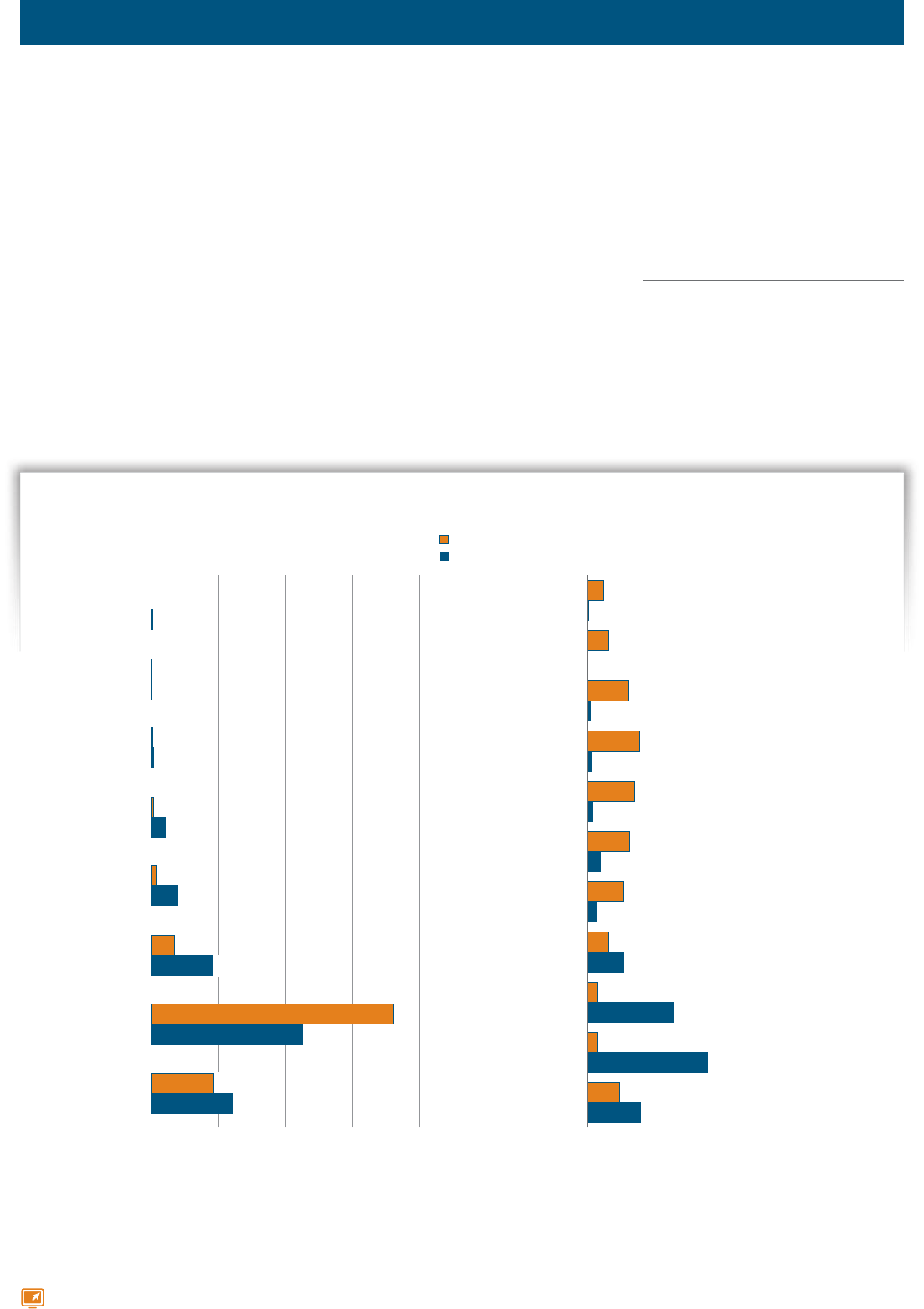
TRENDS IN HIGHER EDUCATION SERIES TRENDS IN COLLEGE PRICING 2012 13
For detailed data behind the graphs and additional information, please visit: trends.collegeboard.org.
Variation in Tuition and Fee Increases, 2012-13
FIGURE 3 Distribution of Full-Time Undergraduates at Public and Private Nonprot Four-Year Institutions by Percentage
and Dollar Increase in Published Tuition and Fees, 2012-13
NOTE: For out-of-state students enrolled in public four-year colleges, the nonresident premium has been added to in-state tuition and fees. Some out-of-state
students actually pay lower prices because of reciprocity agreements, which allow students from neighboring states to pay less than the full out-of-state price.
The distribution of students across institutions is based on the latest available enrollment data, which are for fall 2011. Percentages may not sum to 100 because
of rounding.
SOURCE: The College Board, Annual Survey of Colleges.
0% 20% 40% 60% 80%
Under $200
$200 to $399
$400 to $599
$600 to $799
$800 to $999
$1,000 to $1,199
$1,200 to $1,399
$1,400 to $1,599
$1,600 to $1,799
$1,800 to $1,999
$2,000 or more
0% 20% 40% 60% 80%
Public Four-Year
Private Nonprot Four-Year
Under 3%
3% to 5.9%
6% to 8.9%
9% to 11.9%
12% to 14.9%
15% to 17.9%
18% to 20.9%
21% or more
Percentage of Full-Time Undergraduates
Percentage Increase Dollar Increase
Amounts
Percentage
24%
45%
18%
8%
4%
1%
<1%
<1%
19%
72%
7%
1%
1%
<1%
<1%
<1%
16%
36%
26%
11%
3%
4%
2%
1%
1%
<1%
<1%
10%
3%
3%
7%
11%
13%
14%
16%
12%
7%
5%
Although the average increase in tuition and fees at public four‑year colleges in 2012‑13 is 4.8% for
in‑state undergraduates and 4.2% for out‑of‑state undergraduates, 13% of full‑time undergraduates at
public four‑year colleges and universities attend institutions that increased their published prices by
9% or more, and 24% attend institutions that increased their prices by less than 3%.
•The average increase in tuition and fees
at private nonprot four-year colleges and
universities in 2012-13 is 4.2%, and 72%
of the full-time undergraduates in this
sector attend institutions that increased
their charges by between 3% and 6%.
About 19% of undergraduates in this
sector attend institutions that increased
their prices by less than 3%, while about
2% faced increases of 9% or more.
•The median 2012-13 dollar increase in
published tuition and fees for public four-
year college undergraduates is $384. The
median dollar increase for private nonprot
four-year college undergraduates is $1,231.
ALSO IMPORTANT:
•Increases in published prices do not
necessarily correspond to increases in
the amounts students pay. The amounts
students pay also depend on the amount
of grant aid they receive.
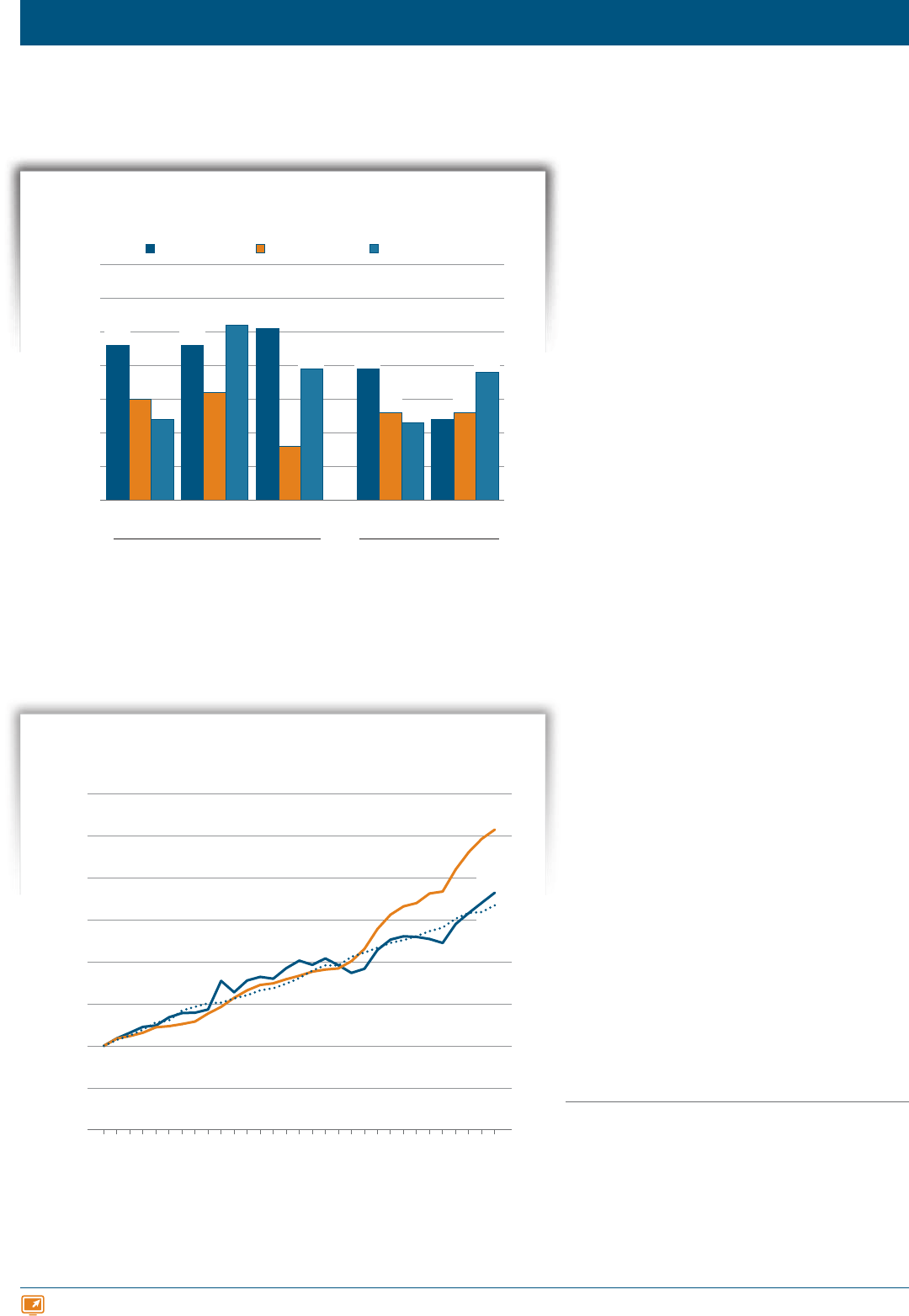
14 TRENDS IN COLLEGE PRICING 2012 trends.collegeboard.org
For detailed data behind the graphs and additional information, please visit: trends.collegeboard.org.
Tuition and Fee and Room and Board Charges
over Time
The 4.8% one‑year increase in average
published tuition and fees for in‑state
students at public four‑year institutions
in 2012‑13 was 3.4% after adjusting for
ination — less than the 5.2% average
annual real increase over the decade
from 2002‑03 to 2012‑13.
•Published prices (both tuition and fees and room
and board) at public four-year institutions rose
more rapidly between 2002-03 and 2012-13 than
over either of the two preceding decades.
•The average annual rate of increase in ination-
adjusted tuition and fees at private nonprot four-
year colleges and universities declined from 4.6%
from 1982-83 to 1992-93 to 3.0% from 1992-93 to
2002-03, and to 2.4% over the most recent decade.
•Tuition and fees at public two-year colleges
rose less than average prices in the economy
in 2006-07, 2007-08, and 2008-09, but rose by
11.7% in 2003-04 and by 10.2% beyond ination
in 2009-10. Between 1992-93 and 2002-03, there
were three years with negative real increases
and the largest single-year increase was 4.0%.
•Over the decade from 2002-03 to 2012-13, when
published tuition and fees at public four-year
institutions rose at an average rate of 5.2% per
year beyond ination, room and board charges
increased by 2.6% per year, leading to a 3.8%
average annual rate of growth in total charges.
•Over the decade from 2002-03 to 2012-13, when
published tuition and fees at private nonprot four-
year institutions rose at an average rate of 2.4%
per year beyond ination, room and board charges
increased by 1.9% per year, leading to a 2.3%
average annual rate of growth in total charges.
•Over the 30 years from 1982-83 to 2012-13,
average published tuition and fees at private
nonprot four-year institutions rose by 167%, from
$10,901 (in 2012 dollars) to $29,056. The average
published price at public two-year colleges rose by
182%, from $1,111 (in 2012 dollars) to $3,131, while
the increase for in-state students at public four-year
institutions was 257%, from $2,423 to $8,655.
ALSO IMPORTANT:
•About 40% of full-time dependent students enrolled
in public four-year institutions live on campus. Another
40% live in off-campus housing and about 20%
live with their parents. Among dependent students
at private nonprot four-year colleges, 70% live on
campus, 17% live in off-campus housing, and 12%
live with their parents. (NCES, National Postsecondary
Student Aid Study [NPSAS], 2008)
FIGURE 4
Average Annual Percentage Increases in Ination-Adjusted Published Prices by
Decade, 1982-83 to 2012-13
FIGURE 5
Ination-Adjusted Published Tuition and Fees Relative to 1982-83, 1982-83 to
2012-13 (1982-83 = 100)
Each bar in Figure 4 shows the average annual rate of growth of published prices
in ination-adjusted dollars over a 10-year period. For example, from 2002-03 to
2012-13, average published tuition and fees at private nonprot four-year colleges
rose by an average of 2.4% per year beyond increases in the Consumer Price Index.
SOURCES: The College Board, Annual Survey of Colleges; National Center for Education
Statistics (NCES), Integrated Postsecondary Education Data System (IPEDS).
Figure 5 shows published tuition and fees by sector, adjusted for ination, as a
percentage of 1982-83 published prices. For example, a value of 357 indicates that
the tuition and fee price in the public four-year sector in 2012-13 is 3.57 times as
high as it was in 1982-83, after adjusting for increases in the Consumer Price Index.
SOURCES: The College Board, Annual Survey of Colleges; NCES, IPEDS.
0%
1%
2%
3%
4%
5%
6%
Average Annual Percentage Increase
Tuition and Fees
Tuition and Fees
and Room and Board
Public
Four-Year
Private Nonprot
Four-Year
Public
Two-Year
Public
Four-Year
Private Nonprot
Four-Year
2002-03 to 2012-131992-93 to 2002-031982-83 to 1992-93
7%
4.6% 4.6%
5.1%
3.9%
2.4%
3.0%
3.2%
1.6%
2.6%
2.6%
2.4%
5.2%
3.9%
2.3%
3.8%
Ination-Adjusted Published Tuition
and Fees Relative to 1982-83
0
50
100
150
200
250
300
350
400
Academic Year
12-1310-1108-0906-0704-0502-0300-0198-9996-9794-9592-9390-9188-8986-8784-8582-83
357
282
267
Public
Two-Year
Public Four-Year
Private
Nonprot
Four-Year
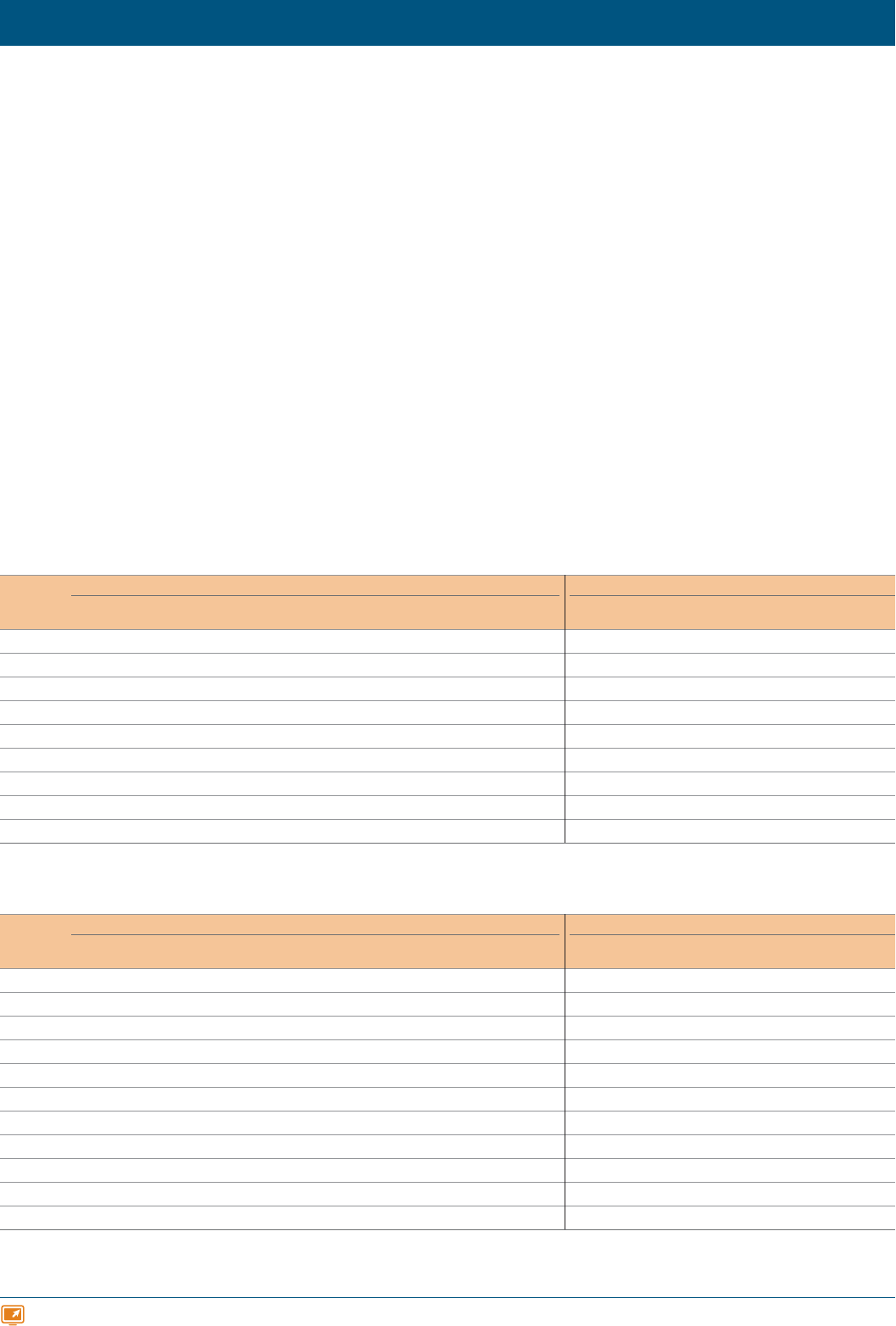
TRENDS IN STUDENT AID 2010 15TRENDS IN HIGHER EDUCATION SERIES TRENDS IN COLLEGE PRICING 2012 15
See Table 2 and Table 3 online for historical data on tuition and fee and room and board charges.
Tuition and Fee and Room and Board Charges
over Time
TABLE 2A Average Tuition and Fee and Room and Board Charges in 2012 Dollars, 1972-73 to 2012-13, Selected Years
Tuition and Fees in 2012 Dollars Tuition, Fees, and Room and Board in 2012 Dollars
Private Nonprot
Four-Year
5-Year
% Change
Public
Four-Year
5-Year
% Change
Public
Two-Year
5-Year
% Change
Private Nonprot
Four-Year
5-Year
% Change
Public
Four-Year
5-Year
% Change
72-73 $10,378 — $2,225 — $1,274 — $16,611 — $7,972 —
77-78 $10,141 -2% $2,460 11% $1,149 -10% $15,925 -4% $7,654 -4%
82-83 $10,901 7% $2,423 -2% $1,111 -3% $16,745 5% $7,510 -2%
87-88 $14,189 30% $2,990 23% $1,488 34% $21,048 26% $8,453 13%
92-93 $17,037 20% $3,806 27% $1,820 22% $24,504 16% $9,513 13%
97-98 $19,677 15% $4,441 17% $2,237 23% $27,635 13% $10,662 12%
02-03 $22,974 17% $5,213 17% $2,129 -5% $31,633 14% $12,304 15%
07-08 $25,759 12% $6,809 31% $2,523 18% $35,188 11% $14,912 21%
12-13 $29,056 13% $8,655 27% $3,131 24% $39,518 12% $17,860 20%
The annual increase in ination‑adjusted average tuition and fees at public four‑year colleges and
universities has declined in each of the past four years, from 9.3% in 2009‑10 to 3.4% in 2012‑13.
•Average published tuition and fees at public four-year colleges
and universities increased by 31% beyond the rate of ination
over the ve years from 2002-03 to 2007-08, and by another
27% between 2007-08 and 2012-13.
•The 13% real increase in average published tuition and fees at
private nonprot four-year institutions from 2007-08 to 2012-13
was similar to that in the previous ve years.
•The annual increase in ination-adjusted average published
tuition and fees at public two-year colleges declined from
10.2% in 2009-10 to 5.3% in 2010-11 and 4.7% in 2011-12, and
was 4.3% in 2012-13.
•Average published tuition and fees at public two-year colleges
increased by 18% in ination-adjusted dollars, from $2,129 (in
2012 dollars) in 2002-03 to $2,523 in 2007-08, and by another
24%, to $3,131 in 2012-13.
•In both the public four-year and the private nonprot four-
year sectors, the largest one-year percentage increase in
the constant dollar published price for tuition, fees, room
and board over the decade from 2002-03 to 2012-13 was
in2009-10.
TABLE 2B Average Tuition and Fee and Room and Board Charges in 2012 Dollars, 2002-03 to 2012-13
Tuition and Fees in 2012 Dollars Tuition, Fees, and Room and Board in 2012 Dollars
Private Nonprot
Four-Year
1-Year
% Change
Public
Four-Year
1-Year
% Change
Public
Two-Year
1-Year
% Change
Private Nonprot
Four-Year
1-Year
% Change
Public
Four-Year
1-Year
% Change
02-03 $22,974 — $5,213 — $2,129 — $31,633 — $12,304 —
03-04 $23,608 2.8% $5,787 11.0% $2,378 11.7% $32,462 2.6% $13,118 6.6%
04-05 $24,247 2.7% $6,201 7.2% $2,515 5.7% $33,222 2.3% $13,761 4.9%
05-06 $24,599 1.5% $6,439 3.9% $2,558 1.7% $33,701 1.4% $14,205 3.2%
06-07 $25,115 2.1% $6,534 1.5% $2,551 -0.3% $34,334 1.9% $14,452 1.7%
07-08 $25,759 2.6% $6,809 4.2% $2,523 -1.1% $35,188 2.5% $14,912 3.2%
08-09 $25,849 0.3% $6,865 0.8% $2,471 -2.1% $35,204 0.0% $14,961 0.3%
09-10 $27,383 5.9% $7,500 9.3% $2,721 10.2% $37,310 6.0% $16,183 8.2%
10-11 $28,128 2.7% $8,000 6.7% $2,866 5.3% $38,320 2.7% $16,984 5.0%
11-12 $28,276 0.5% $8,372 4.6% $3,001 4.7% $38,506 0.5% $17,377 2.3%
12-13 $29,056 2.8% $8,655 3.4% $3,131 4.3% $39,518 2.6% $17,860 2.8%
SOURCES: The College Board, Annual Survey of Colleges; NCES, IPEDS.
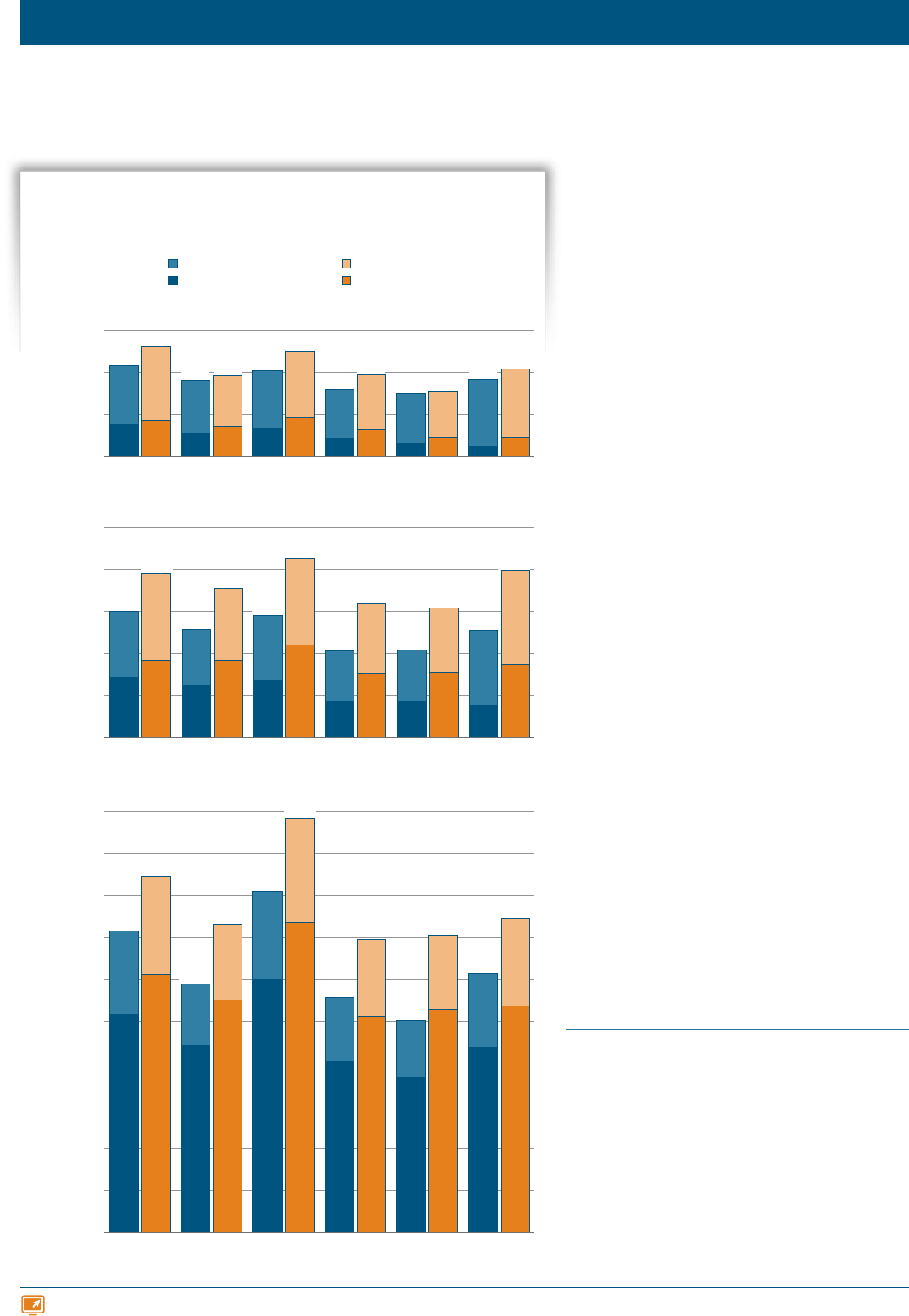
16 TRENDS IN COLLEGE PRICING 2012 trends.collegeboard.org
See Table 4 online for historical data on tuition and fees by region.
Regional Variation in Charges
In 2012‑13, average published tuition
and fees for in‑state students at public
four‑year colleges range from $7,621 in
the South to $11,019 in New England.
•Average published tuition and fees for full-time
students at public two-year colleges range from
$2,241 in the West to $4,619 in New England
in2012-13.
•Over the decade from 2002-03 to 2012-13, dollar
increases in average public four-year tuition and
fees ranged from $2,100 (in 2012 dollars) in the
Middle States region to $4,874 in the West.
Percentage increases ranged from 30% in the
Middle States region to 126% in the West.
•The percentage increase in public four-year
college tuition and fees over the decade beginning
in 2002-03 was over twice as large in the West as
in New England, but the average published tuition
and fee price in the West in 2012-13 is $2,289
lower than the price in New England.
•The largest percentage increase in public
two-year college tuition and fees over the decade
beginning in 2002-03 was 82% in the West,
which still has a lower published tuition and fee
price than any other region in 2012-13.
•Room and board charges at public four-year
institutions are higher in the West than in other
regions. The Middle States region had the
highest average tuition, fees, and room and board
combined in 2002-03, but the highest charges in
2012-13 are in New England.
•The largest dollar gap between average 2012-13
tuition and fees at public two-year and public
four-year institutions is $6,489 in the West,
where the published price at two-year colleges
is 26% of the price at public four-year colleges
and universities. The smallest gap is $4,415 in the
South, where the ratio is 42%.
FIGURE 6
Average Tuition and Fee and Room and Board Charges by College Board
Region and Sector, in 2012 Dollars, 2002-03 and 2012-13 (Enrollment-Weighted)
The blue bars report 2002-03 prices and the orange
bars report 2012-13 prices. In each bar, the darker
segment corresponds to published tuition and fees
and the lighter segment corresponds to room and
board charges. The height of the entire bar reects
total tuition and fee and room and board charges.
NOTE: Public two-year room and board charges are based
on commuter housing and food costs. States and territories
included in the regions are as follows: Middle States: DC, DE,
MD, NJ, NY, PA, and PR; Midwest: IA, IL, IN, KS, MI, MN, MO,
NE, ND, OH, SD, WI, and WV; New England: CT, MA, ME, NH,
RI, and VT; South: AL, FL, GA, KY, LA, MS, NC, SC, TN, and VA;
Southwest: AR, NM, OK, and TX; West: AK, AZ, CA, CO, HI, ID,
MT, NV, OR, UT, WA, and WY.
SOURCE: The College Board, Annual Survey of Colleges.
$0
$5,000
$10,000
$15,000
$20,000
$25,000
$30,000
$35,000
$40,000
$45,000
$50,000
WestSouthwestSouthNew England
Region
Private Nonprot Four-Year
Public Four-Year In-State
Public Two-Year In-State
MidwestMiddle States
$0
$5,000
$10,000
$15,000
$20,000
WestSouthwestSouthNew EnglandMidwestMiddle States
$0
$5,000
$10,000
$15,000
WestSouthwestSouthNew EnglandMidwestMiddle States
2002-03 Room and Board
2002-03 Tuition and Fees
2012-13 Room and Board
2012-13 Tuition and Fees
Tuition and Fees and Room and Board in 2012 Dollars Tuition and Fees and Room and Board
in 2012 Dollars
Tuition and Fees and Room
and Board in 2012 Dollars
$25,000
$10,789
$13,054
$9,001
$9,591
$10,225
$12,516
$7,951
$9,713
$7,459
$7,693
$9,083
$10,416
$7,041
$8,780
$6,272
$6,010
$6,892
$7,897
$5,874
$6,507
$5,905
$5,444
$7,853
$8,175
$3,748
$4,274
$2,729
$3,581
$3,333
$4,619
$2,077
$3,206
$1,554
$2,249
$1,230
$2,241
$15,017
$19,554
$12,813
$17,745
$14,496
$21,302
$10,366
$15,898
$10,424
$15,383
$12,703
$19,786
$7,912
$10,349
$6,596
$8,478
$7,686
$10,283
$6,070
$8,277
$6,096
$7,662
$8,847
$11,056
$7,105
$9,205
$6,217
$9,267
$6,810
$11,019
$4,296
$7,621
$4,328
$7,721
$3,856
$8,730
$35,808
$42,316
$29,493
$36,556
$40,475
$49,166
$27,891
$34,826
$25,208
$35,289
$30,762
$37,322
$9,912
$11,769
$7,326
$9,010
$10,374
$12,400
$7,617
$9,216
$6,845
$8,803
$8,813
$10,474
$25,896
$30,547
$22,167
$27,546 $30,102
$36,766
$20,273
$25,610
$18,363
$26,486
$21,949
$26,848
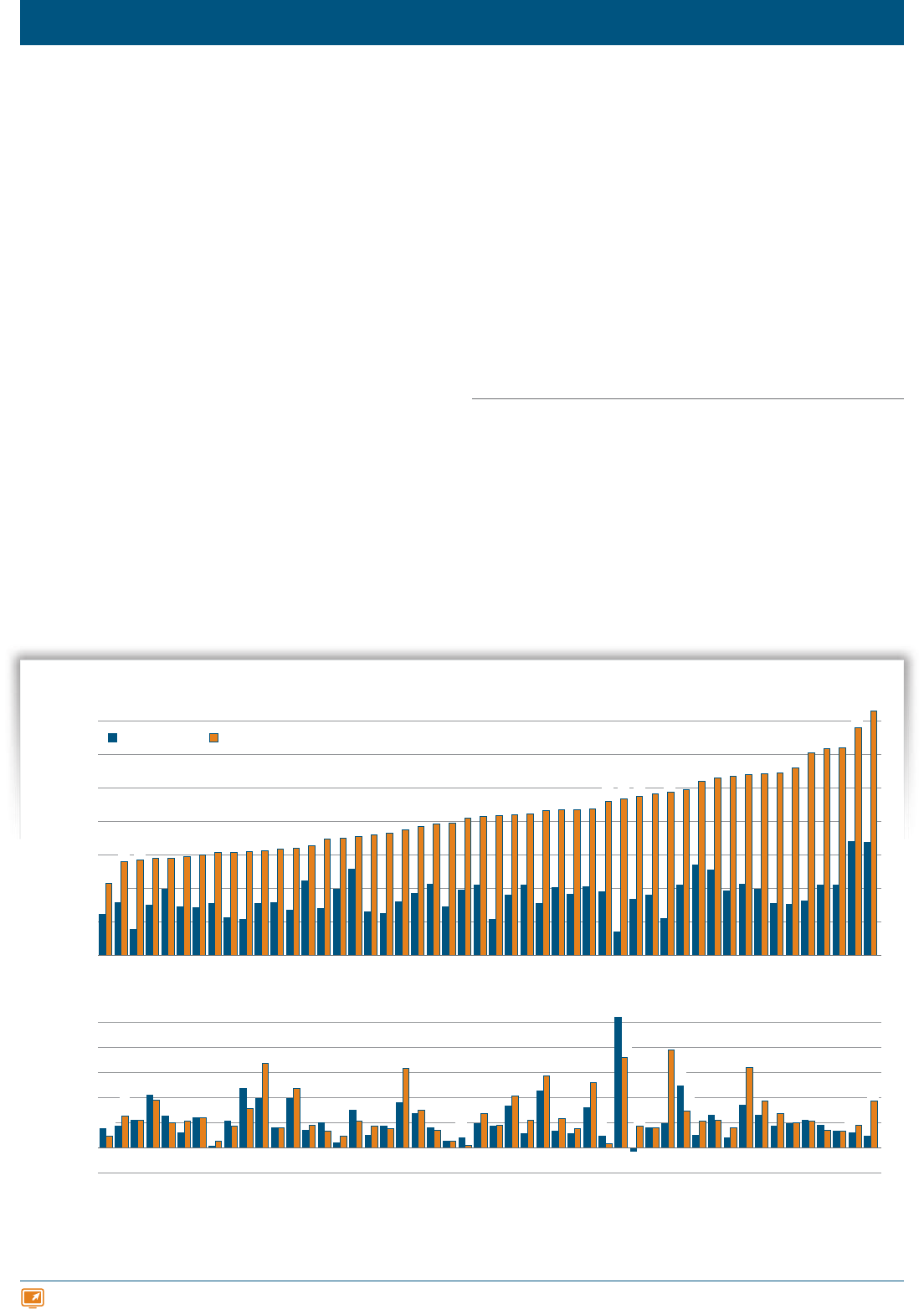
TRENDS IN STUDENT AID 2010 17TRENDS IN HIGHER EDUCATION SERIES TRENDS IN COLLEGE PRICING 2012 17
See Table 5 online for additional data on tuition and fees by state.
SOURCE: The College Board, Annual Survey of Colleges.
FIGURE 7 Average In-State Tuition and Fees at Public Four-Year and Two-Year Institutions, by State,
2012-13 and 5-Year Percentage Change in Ination-Adjusted Tuition and Fees, 2007-08 to 2012-13
Tuition and Fees by State: Public Institutions
In 2012‑13, the highest published tuition and fee prices in both public four‑year and public two‑year
institutions are in New Hampshire and Vermont. Tuition and fees average $14,576 and $6,752 for
public four‑year and public two‑year institutions, respectively, in New Hampshire and $13,582 and
$6,790 in Vermont. For the nation as a whole, average tuition and fee prices are $8,655 for public
four‑year and $3,131 for public two‑year institutions.
•The lowest published tuition and fee prices for public four-year
colleges and universities in 2012-13 are $4,278 in Wyoming
and $5,595 in Utah.
•The lowest published tuition and fee prices for public two-year
colleges in 2012-13 are $1,418 in California and $1,537 in
NewMexico.
•Over the ve years from 2007-08 to 2012-13, percentage
increases in public four-year tuition and fees ranged from 2% in
Maryland ($176 in 2012 dollars) and 3% in Ohio ($250) to 72%
in California ($3,923) and 78% ($4,275) in Arizona. Prices in
Maryland and Ohio remain above the national average.
•Over the ve years from 2007-08 to 2012-13, percentage
changes in public two-year tuition and fees ranged from a
decline of 3% (-$103 in 2012 dollars) in Maine and an increase
of 1% in Montana ($32) to increases of 49% in Virginia
($1,367) and 104% in California ($722), which still has the
lowest prices in the country.
ALSO IMPORTANT:
•As Figure 12B indicates, New Hampshire had the lowest
appropriations per $1,000 of personal income of any state in 2011-12,
and Vermont had the fourth lowest. Wyoming had the highest
appropriations per $1,000 of personal income and New Mexico had
the third highest.
•As Figure 12B indicates, Arizona, which had the largest percentage
increase in public four-year tuition and fees over the past ve years,
also faced the second largest percentage decline in appropriations per
$1,000 of personal income (39%) from 2006-07 to 2011-12. In contrast,
Maryland faced only a 7% decline over these years.
$0
$2
$4
$6
$8
$10
$12
$14
Tuition and Fees (in Thousands)
60%
-20%
0%
20%
40%
80%
100%
5-Year % Change
in Tuition and Fees
State
Public Four-YearPublic Two-Year
NH
VT
NJ
PA
IL
MI
DE
RI
WA
SC
MA
MN
VA
AZ
CT
ME
CA
OH
AL
IN
WI
HI
KY
CO
TX
OR
MD
MO
IA
TN
GA
KS
NE
SD
ND
AR
NY
NV
OK
FL
NC
MS
MT
ID
WV
AK
LA
NM
UT
WY
New Hampshire
Vermont
New Jersey
Pennsylvania
Illinois
Michigan
Delaware
Rhode Island
Washington
South Carolina
Massachusetts
Minnesota
Virginia
Arizona
Connecticut
Maine
California
Ohio
Alabama
Indiana
Wisconsin
Hawaii
Kentucky
Colorado
Texas
Oregon
Maryland
Missouri
Iowa
Tennessee
Georgia
Kansas
Nebraska
South Dakota
North Dakota
Arkansas
New York
Nevada
Oklahoma
Florida
North Carolina
Mississippi
Montana
Idaho
West Virginia
Alaska
Louisiana
New Mexico
Utah
Wyoming
$14,576
$6,752
$9,471
$3,329
$9,190
$3,816
$8,220
$3,875
$2,432
$4,278
37%
9%
18%
9%
3%
2%
8%
15%
9%
$6,139
$3,079
5%
1%
$9,729
$2,209
78%
19%
17%
-3%
12%
$13,582
$6,790
$3,149
$5,595
17%
25%
$1,537
$5,687
22%
22%
$9,368
$1,418
104%
72%
$9,907
$4,184
29%
49%
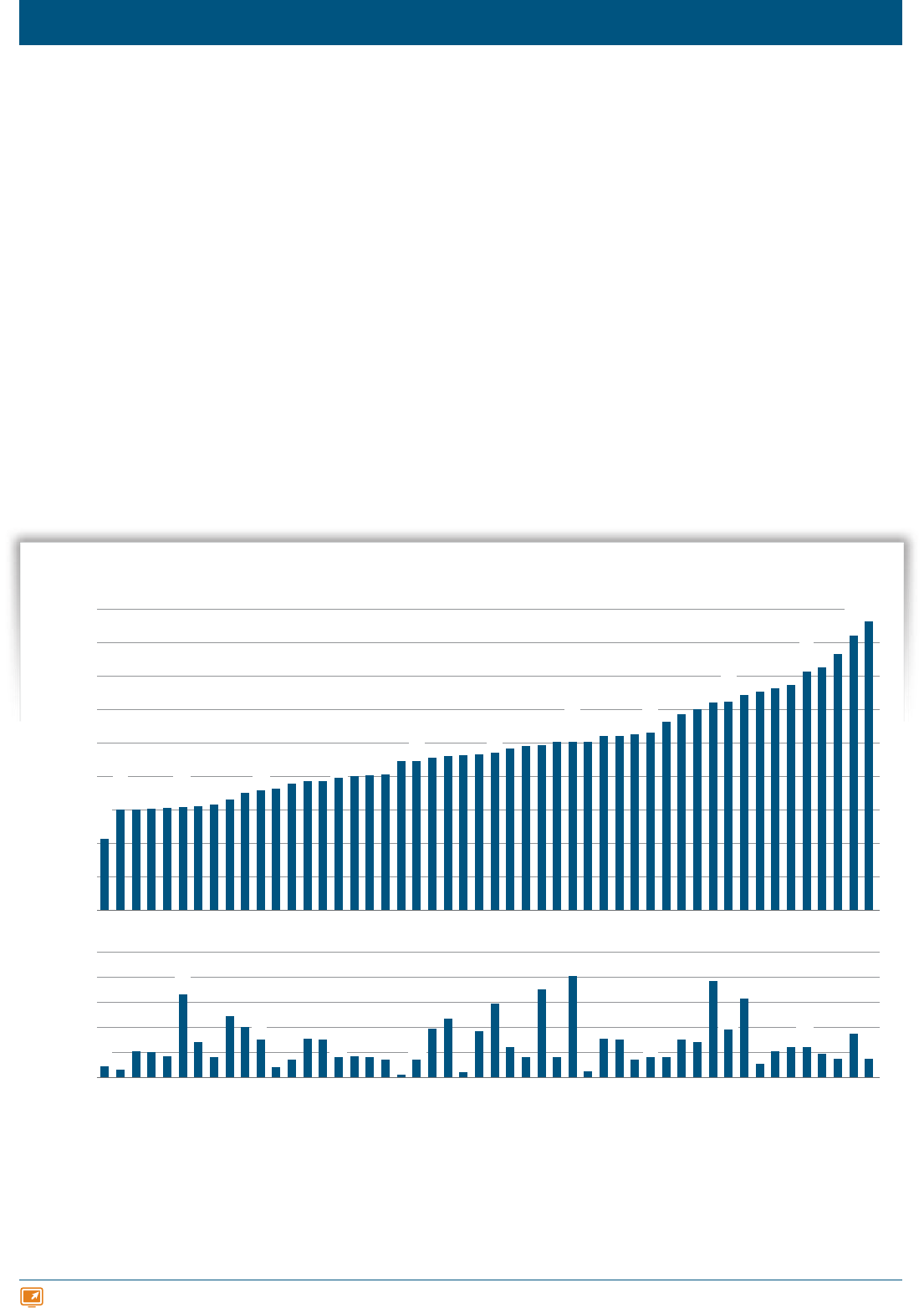
18 TRENDS IN COLLEGE PRICING 2012 trends.collegeboard.org
See Table 6 online for additional data on tuition and fees at agship universities.
Tuition and Fees by State: Flagship Universities
In 2012‑13, published tuition and fees for in‑state students at agship universities range from $4,278 at
the University of Wyoming and $5,985 at the University of Montana to $16,422 at the University of New
Hampshire and $17,266 at Penn State.
•Changes in published tuition and fees for in-state students at
agship universities over the ve years from 2007-08 to 2012-13
range from a 2% real increase at the University of Maryland,
College Park, to an increase of 81% at the University of Arizona.
•At four agship universities, in-state tuition and fees declined
in ination-adjusted dollars in 2012-13. The largest increase was
13% at the University of Washington (online Table 6).
•In 2012-13, published tuition and fees for out-of-state students
at agship universities range from $9,650 at the University
of South Dakota and $13,428 at the University of Wyoming
SOURCE: The College Board, Annual Survey of Colleges.
FIGURE 8 In-State Tuition and Fees at Flagship Universities, by State, 2012-13 and 5-Year Percentage Change in
Ination-Adjusted Tuition and Fees, 2007-08 to 2012-13
to $37,336 at the University of Virginia and $39,122 at the
University of Michigan (online Table 6).
•In three states, the price for out-of-state students declined in
ination-adjusted dollars in 2012-13. The largest increase was
13% at Louisiana State University (online Table 6).
•Changes in published prices for out-of-state students at
agship universities over the ve years from 2007-08 to
2012-13 range from a 21% decline in ination-adjusted dollars
at the University of Minnesota–Twin Cities, to a 59% increase
at the University of Hawaii at Manoa (online Table 6).
$0
$2
$4
$6
$8
$10
$12
$14
$16
$18
In-State Tuition and Fees (in Thousands)
60%
0%
20%
40%
80%
100%
5-Year % Change
in Tuition and Fees
Institution
PA
NH
VT
IL
MI
MN
MA
NJ
CA
RI
WA
VA
DE
CT
ME
SC
CO
WI
OH
AZ
IN
GA
TX
KY
HI
OR
MO
AL
TN
KS
MD
OK
IA
NY
NE
SD
NC
AR
ND
UT
LA
NV
MS
ID
FL
WV
NM
AK
MT
WY
Penn State Univ.−University Park
Univ. of NH
Univ. of VT
Univ. of IL−Urbana-Champaign
Univ. of MI
Univ. of MN−Twin Cities
Univ. of MA−Amherst
Rutgers, State Univ. of NJ−Pisca.
Univ. of CA−Berkeley
Univ. of RI
Univ. of WA
Univ. of VA
Univ. of DE
Univ. of CT
Univ. of ME
Univ. of SC
Univ. of CO−Boulder
Univ. of WI−Madison
OH State Univ.−Columbus
Univ. of AZ
IN Univ.−Bloomington
Univ. of GA
Univ. of TX−Austin
Univ. of KY
Univ. of HI−Manoa
Univ. of OR
Univ. of MO−Columbia
Univ. of AL
Univ. of TN−Knoxville
Univ. of KS
Univ. of MD−College Park
Univ. of OK
Univ. of IA
State Univ. of NY−Buffalo
Univ. of NE−Lincoln
Univ. of SD
Univ. of NC−Chapel Hill
Univ. of AR
Univ. of ND
Univ. of UT
LA State Univ. & A&M College
Univ. of NV−Reno
Univ. of MS
Univ. of ID
Univ. of FL
West VA Univ.
Univ. of NM
Univ. of AK Fairbanks
Univ. of MT
Univ. of WY
81% $10,035
59% $9,404
16%
$7,897
16%
$10,594
14%
$8,926
9% $4,278
30%
$7,139
38%
$12,450
66% $6,143
24%
$14,263
15% $17,266
$5,985
$16,422
2%
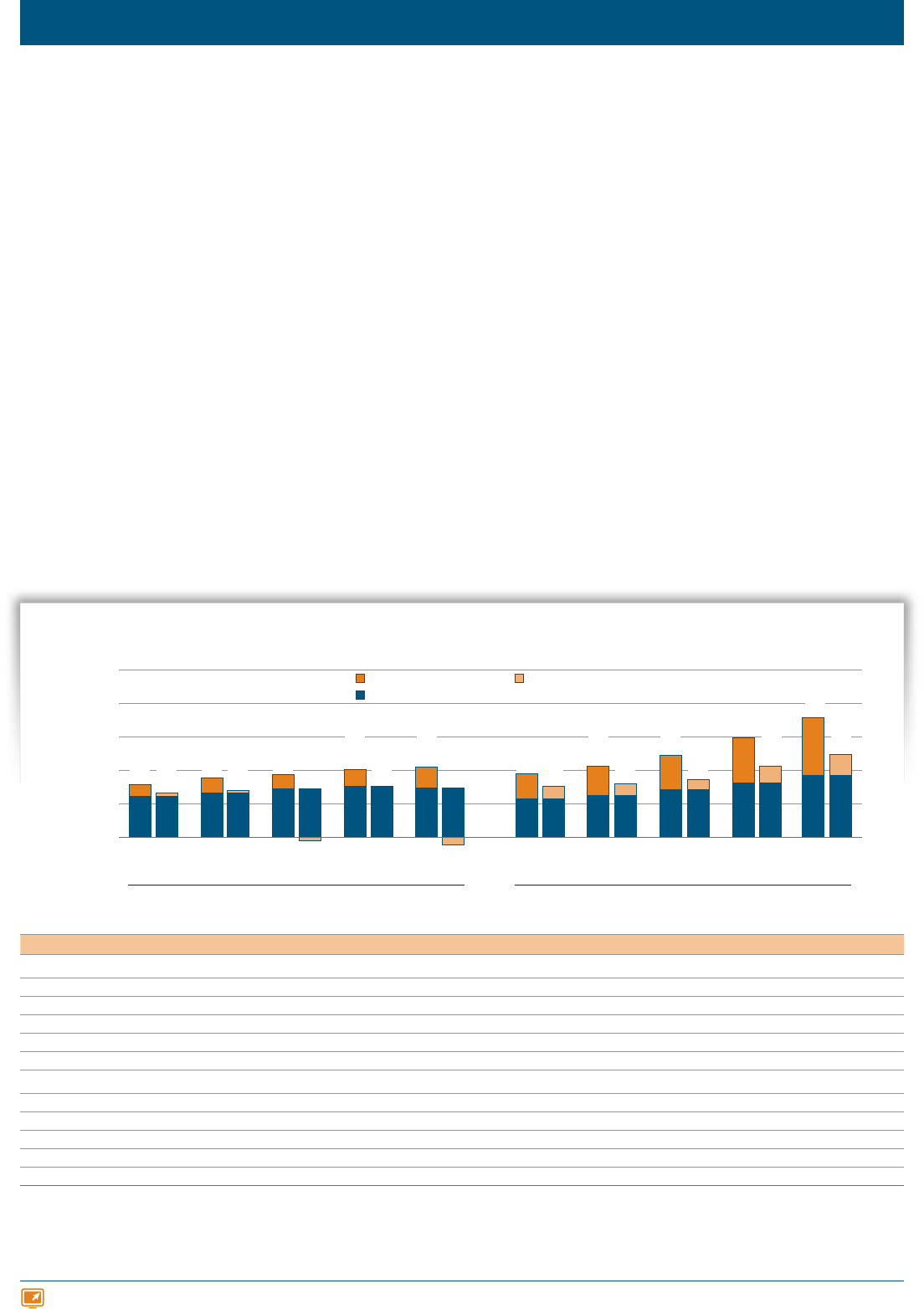
TRENDS IN STUDENT AID 2010 19TRENDS IN HIGHER EDUCATION SERIES TRENDS IN COLLEGE PRICING 2012 19
See Table 7, Figures 2009_8, 2010_8A, 2010_8B, 2011_8A, and 2011_8B online for additional data on net price at public institutions.
Average Net Price — Public Institutions
Between 2007‑08 and 2012‑13, average published tuition and fees at public four‑year colleges and
universities increased by about $1,850 (in 2012 dollars) from $6,810 to $8,660. About $1,410 of this
$1,850 increase was covered by increases in grant aid from all sources and federal education tax
credits and deductions, with the student share increasing by about $440.
FIGURE 9 Published Tuition and Fees, Net Tuition and Fees, and Room and Board in 2012 Dollars, Full-Time
Undergraduate Students at Public Institutions, 1992-93, 1997-98, 2002-03, 2007-08, and 2012-13 (Estimated)
Because data for 2012-13 are not yet available, nancial aid and the resulting net prices for 2012-13 are preliminary estimates.
NOTE: Prices have been rounded to the nearest $10.
SOURCES: The College Board, Annual Survey of Colleges; Trends in Student Aid 2012; calculations by the authors.
•The average net tuition and fees that
in-state undergraduates pay after
taking grant aid and tax benets into
consideration increased from $2,470 to
$2,910 over this time period.
•In 2012-13, undergraduates enrolled
full-time in public four-year institutions
receive an estimated average $5,750
in grant aid and tax benets to help
them pay for college. This aid averages
about $4,350 for those enrolled in public
two-year institutions.
•Because of unusually large increases
in grant aid and tax credits, the average
net tuition and fees paid by full-time
in-state undergraduates at public four-
year institutions declined in real terms
between 2007-08 and 2009-10, falling
from $2,470 (in 2012 dollars) to $1,950
— the lowest level since 2003-04. Over
the three years since, the average net
tuition and fees have increased by an
estimated $960.
•The average full-time undergraduate
enrolled in a public four-year college
receives enough grant aid to cover a
signicant portion of tuition and fees,
but not to cover any other expenses.
As a result, total net price — including
tuition and fees as well as room and
board — equals the $2,910 in net tuition
and fees plus the full $9,200 for room
and board, yielding an estimated total
net price of $12,110 in 2012-13.
•In 2012-13, the average student enrolled
full-time in a public two-year college
receives enough funding through federal
tax benets and grant aid from all
sources to cover tuition and fees plus
about $1,220 in other expenses.
Price in 2012 Dollars
$5,000
$10,000
$15,000
$20,000
$25,000
Public Two-Year
07-0802-0397-9892-93
Net Tuition and FeesPublished Tuition and Fees
Room and Board
$0
12-13
Public Four-Year
07-0802-0397-9892-93 12-13
$6,100
$6,640
$7,250
$7,610
$7,420
$5,700
$6,220
$7,090
$8,100
$9,200
$1,820
$490
$2,240
–$570
$2,130
$300
$2,520
–$1,220
$3,130
$10
$3,810
$1,920
$4,440
$1,780
$5,210
$1,490
$6,810
$2,470
$8,660
$2,910
$6,100
$6,640
$7,250
$7,610
$7,420
$5,700
$6,220
$7,090
$8,100
$9,200
92-93 97-98 02-03 03-04 04-05 05-06 06-07 07-08 08-09 09-10 10-11 11-12 12-13
Public Two-Year Institutions
Published Tuition and Fees $1,820 $2,240 $2,130 $2,380 $2,510 $2,560 $2,550 $2,520 $2,470 $2,720 $2,870 $3,000 $3,130
Total Grant Aid and Tax Benets $1,330 $1,940 $2,700 $2,780 $2,730 $2,620 $2,520 $2,510 $2,920 $3,610 $4,330 $4,350 $4,350
Net Tuition and Fees $490 $300 -$570 -$400 -$220 -$60 $30 $10 -$450 -$890 -$1,460 -$1,350 -$1,220
Published Tuition, Fees, Room, and Board $7,920 $8,880 $9,380 $9,390 $9,570 $9,560 $9,920 $10,130 $9,880 $10,320 $10,620 $10,440 $10,550
Net Tuition, Fees, Room, and Board $6,590 $6,940 $6,680 $6,610 $6,840 $6,940 $7,400 $7,620 $6,960 $6,710 $6,290 $6,090 $6,200
Public Four-Year Institutions
Published Tuition and Fees $3,810 $4,440 $5,210 $5,790 $6,200 $6,440 $6,530 $6,810 $6,860 $7,500 $8,000 $8,370 $8,660
Total Grant Aid and Tax Benets $1,890 $2,660 $3,720 $3,900 $4,050 $4,070 $4,180 $4,340 $4,520 $5,550 $5,880 $5,750 $5,750
Net Tuition and Fees $1,920 $1,780 $1,490 $1,890 $2,150 $2,370 $2,350 $2,470 $2,340 $1,950 $2,120 $2,620 $2,910
Published Tuition, Fees, Room, and Board $9,510 $10,660 $12,300 $13,120 $13,760 $14,200 $14,450 $14,910 $14,960 $16,180 $16,980 $17,380 $17,860
Net Tuition, Fees, Room, and Board $7,620 $8,000 $8,580 $9,220 $9,710 $10,130 $10,270 $10,570 $10,440 $10,630 $11,100 $11,630 $12,110
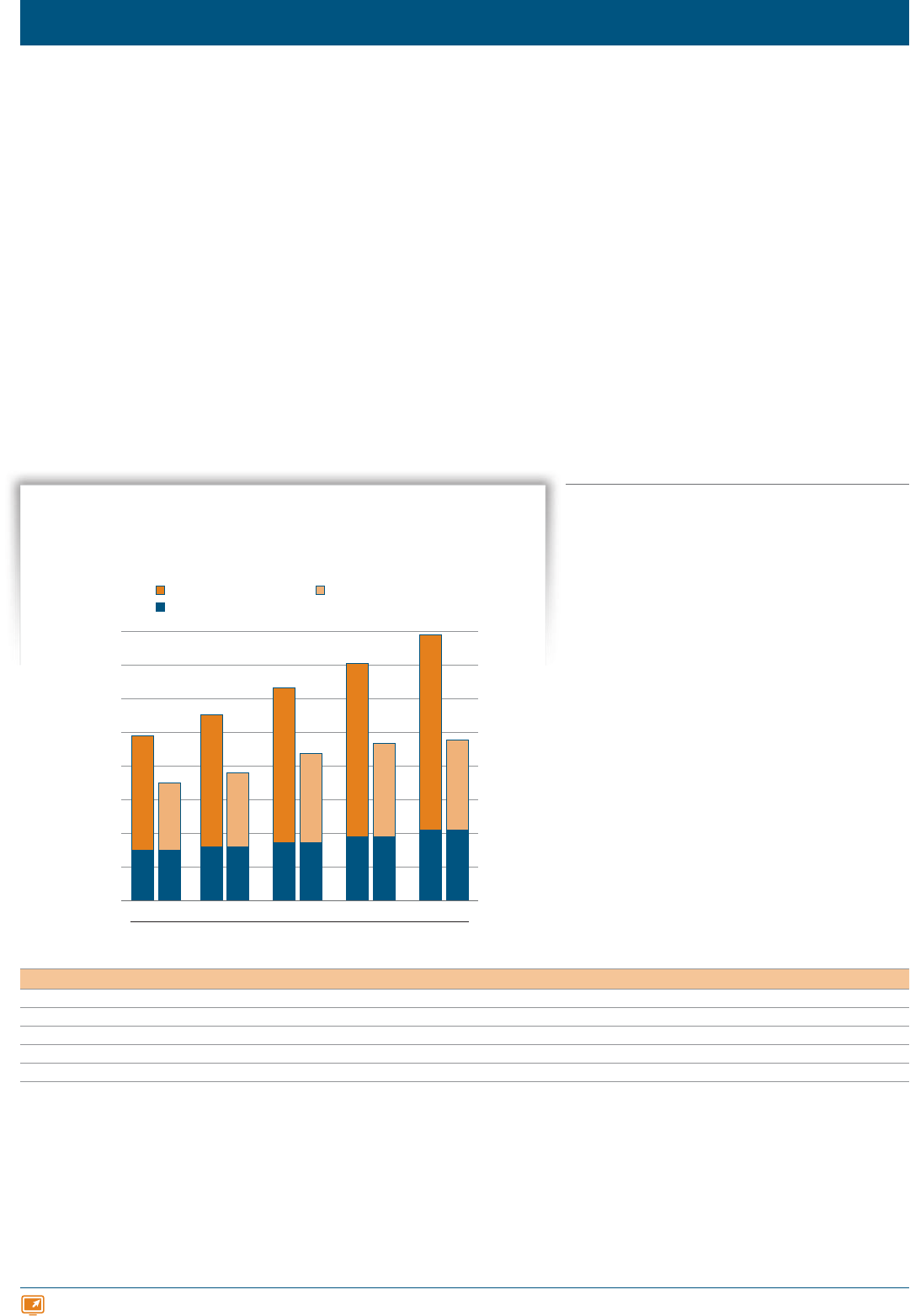
20 TRENDS IN COLLEGE PRICING 2012 trends.collegeboard.org
See Table 8, Figures 2009_9, 2010_9A, 2010_9B, 2011_9A, and 2011_9B online for additional data on net price at private institutions.
Average Net Price — Private Institutions
FIGURE 10
Published Tuition and Fees, Net Tuition and Fees, and Room and Board in 2012
Dollars, Full-Time Undergraduate Students at Private Nonprot Four-Year
Institutions, 1992-93, 1997-98, 2002-03, 2007-08, and 2012-13 (Estimated)
Because data for 2012-13 are not yet available, nancial aid and the resulting net prices for 2012-13 are preliminary estimates.
NOTE: Prices have been rounded to the nearest $10.
SOURCES: The College Board, Annual Survey of Colleges; Trends in Student Aid 2012; calculations by the authors.
92-93 97-98 02-03 03-04 04-05 05-06 06-07 07-08 08-09 09-10 10-11 11-12 12-13
Published Tuition and Fees $17,040 $19,680 $22,970 $23,610 $24,250 $24,600 $25,110 $25,760 $25,850 $27,380 $28,130 $28,280 $29,060
Total Grant Aid and Tax Benets $7,030 $8,670 $9,820 $10,270 $10,690 $11,030 $11,410 $11,890 $12,410 $14,730 $15,590 $15,680 $15,680
Net Tuition and Fees $10,010 $11,010 $13,150 $13,340 $13,560 $13,570 $13,700 $13,870 $13,440 $12,650 $12,540 $12,600 $13,380
Published Tuition, Fees, Room, and Board $24,500 $27,640 $31,630 $32,460 $33,220 $33,700 $34,330 $35,190 $35,200 $37,310 $38,320 $38,510 $39,520
Net Tuition, Fees, Room, and Board $17,470 $18,970 $21,810 $22,190 $22,530 $22,670 $22,920 $23,300 $22,790 $22,580 $22,730 $22,830 $23,840
Price in 2012 Dollars
Private Nonprot Four-Year
07-0802-0397-9892-93
Net Tuition and FeesPublished Tuition and Fees
Room and Board
12-13
$5,000
$10,000
$15,000
$20,000
$25,000
$0
$30,000
$35,000
$40,000
$7,460
$7,960
$8,660
$9,430
$10,460
$17,040
$10,010
$19,680
$22,970
$11,010
$25,760
$29,060
$13,870
$7,460
$7,960
$8,660
$9,430
$10,460
$13,150
$13,380
Average net tuition and fees for full‑time undergraduates at private nonprot four‑year institutions rose
from $12,600 (in 2012 dollars) in 2011‑12 to an estimated $13,380 in 2012‑13. This increase comes after
three consecutive years of decline between 2007‑08 and 2010‑11 and a small increase of $60 between
2010‑11 and 2011‑12.
•The average private nonprot four-year net tuition and fee
price of $12,540 in 2010-11 was the lowest since 2000-01
inination-adjusted dollars.
•In 2012-13, on average, undergraduates enrolled full-time in
private nonprot four-year colleges receive an estimated $15,680
in grant aid and tax benets to help them pay forcollege.
•The average full-time undergraduate enrolled in a private
nonprot four-year college receives enough grant aid to cover
a signicant portion of tuition and fees, but not to cover any
other expenses. As a result, total net price — including tuition
and fees as well as room and board — equals the $13,380 in
net tuition and fees plus the full $10,460 for room and board,
yielding an estimated total net price of $23,840 in 2012-13.
ALSO IMPORTANT:
•Large increases in federal Pell Grants and veterans
benets in 2009-10, combined with the 2009
implementation of the American Opportunity Tax Credit,
had a signicant impact on the net prices paid by
students who benet from these programs.
•Net prices vary considerably across students within
institutions and within sectors. For those who do not
receive grant aid or tax benets, the net price is equal
to the published price.
•In 2012-13, net tuition and fees for full-time students
at private for-prot institutions, after considering grant
aid from all sources and federal education tax credits
and deductions, average about $4,950, compared to
published tuition and fees of about $15,170.
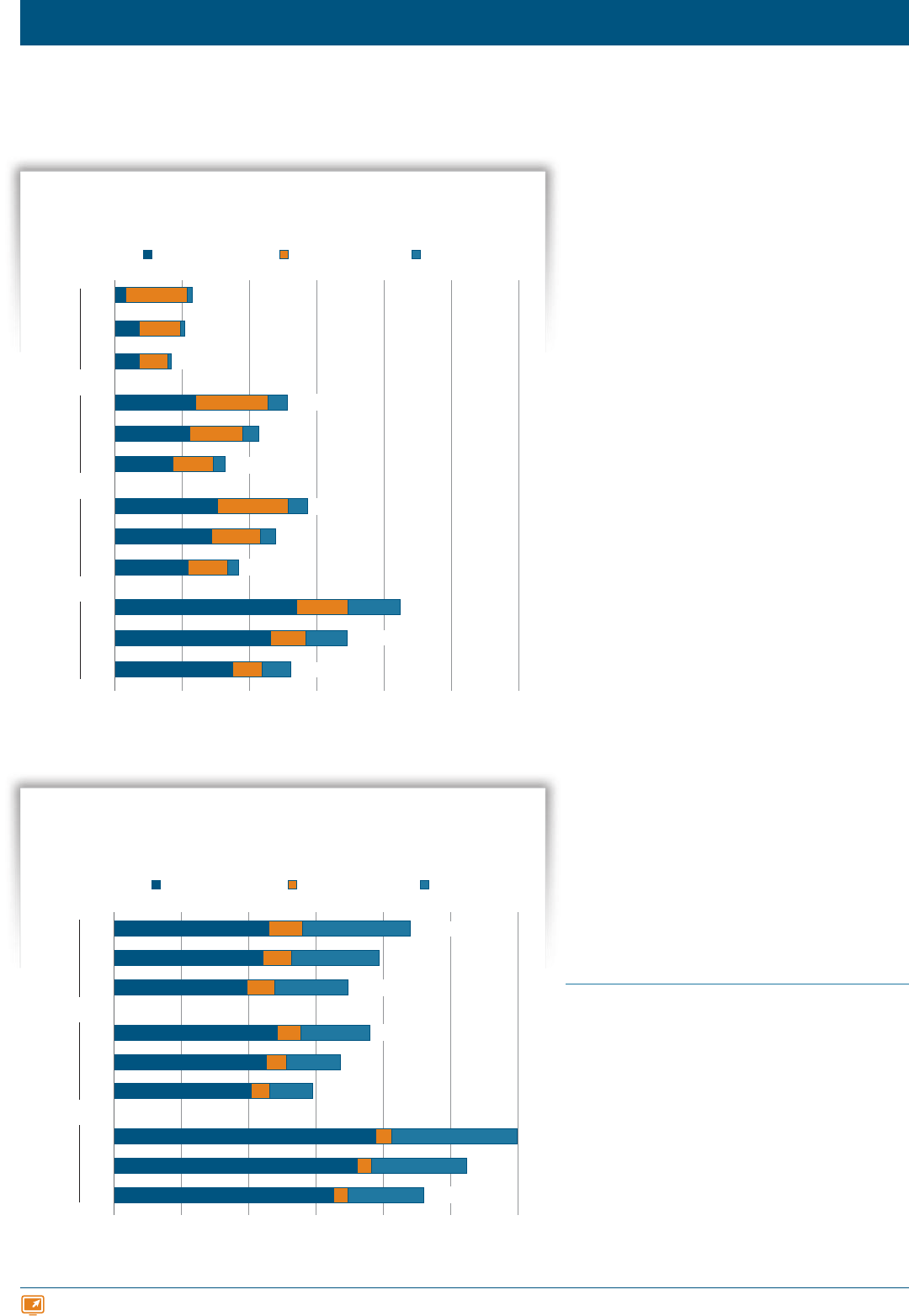
TRENDS IN HIGHER EDUCATION SERIES TRENDS IN COLLEGE PRICING 2012 21
For detailed data behind the graphs and additional information, please visit: trends.collegeboard.org.
Net Price
Between 1999‑2000 and 2009‑10, the
net tuition revenue per FTE student
received by public doctoral universities
increased from $5,480 to $8,660.
Payments from students increased from
$4,390 to $6,750, and the share of gross
tuition covered by state and federal
grant aid increased from 17% to 18%.
•The tuition paid by public two-year college
students, net of institutional, federal, and state
grant aid, declined from $920 per FTE student
(in2010 dollars) in 1999-2000 to $420 in 2009-10.
•At private doctoral universities, net tuition
revenue of institutions, which does not include
institutional grant aid, declined from 76% of
gross tuition revenue in 1999-2000 to 69% in
2009-10. The decline was from 78% to 73% at
private master’s universities and from 69% to
64% at private bachelor’s colleges.
•Over the decade from 1999-2000 to 2009-10,
increases in gross tuition revenues — the
amounts students would have paid in the
absence of federal, state, and institutional grant
aid — ranged from 27% at private bachelor’s
colleges (from $17,360 in 2010 dollars to $21,990)
to 62% at public doctoral universities (from
$6,540 in 2010 dollars to $10,590).
•Over the decade, increases in net tuition
revenues — funds institutions received from
students and from federal and state grant aid
— ranged from 17% in ination-adjusted dollars
at private bachelor’s colleges to 58% at public
doctoral universities.
The total length of the bars in Figures 11A and 11B
represents gross tuition revenue per FTE student —
the amount institutions would receive if they gave
no discounts (institutional grant aid). The sum of the
net tuition received directly from students and the
portion of tuition paid on behalf of students through
federal and state grant aid programs represents the
net tuition revenues of institutions.
NOTE: Based on 12-month FTE enrollment. Both published
tuition and net prices reported elsewhere in Trends in College
Pricing apply to full-time students only. Percentages may not
sum to 100 because of rounding.
SOURCES: The Delta Cost Project; calculations by the authors.
FIGURE 11B
Sources of Gross Tuition Revenue per Full-Time Equivalent (FTE) Student at
Private Nonprot Institutions by Carnegie Classication, 1999-2000, 2004-05,
and 2009-10
FIGURE 11A
Sources of Gross Tuition Revenue per Full-Time Equivalent (FTE) Student at
Public Institutions by Carnegie Classication, 1999-2000, 2004-05, and 2009-10
Sources of Gross Tuition Revenue
Public
Two-Year
Public
Bachelor’s
Academic Year and Institution Type
Public
Doctoral
$12,500$0
$2,500
$5,000 $7,500 $10,000 $15,000
Public
Master’s
99-00
04-05
09-10
99-00
04-05
09-10
99-00
04-05
09-10
99-00
04-05
09-10
Institutional
Grant Aid
Federal and State
Grant Aid
Net Tuition and Fees
from Student
$6,540
$8,640
$10,590
$4,610
$5,970
$7,160
$4,110
$5,350
$6,420
$2,090
$2,600
$2,890
67%
67%
64%
59%
60%
53%
53%
52%
47%
44%
35%
15%
17%
15%
18%
32%
30%
37%
36%
37%
42%
50%
58%
78%
16%
18%
18%
9%
9%
10%
11%
11%
6%
7%
7%
11%
Sources of Gross Tuition Revenue
Private
Bachelor’s
Academic Year and Institution Type
Private
Doctoral
Private
Master’s
99-00
04-05
09-10
99-00
04-05
09-10
99-00
04-05
09-10
$25,000$0
$5,000
$10,000 $15,000 $20,000 $30,000
Institutional
Grant Aid
Federal and State
Grant Aid
Net Tuition and Fees
from Student
$22,980
$26,180
$29,890
$14,730
$16,760
$18,980
$17,360
$19,680
$21,990
71%
69%
65%
69%
67%
64%
57%
56%
52%
5%
4%
4%
9%
9%
9%
12%
11%
11%
25%
27%
31%
22%
24%
27%
31%
33%
36%
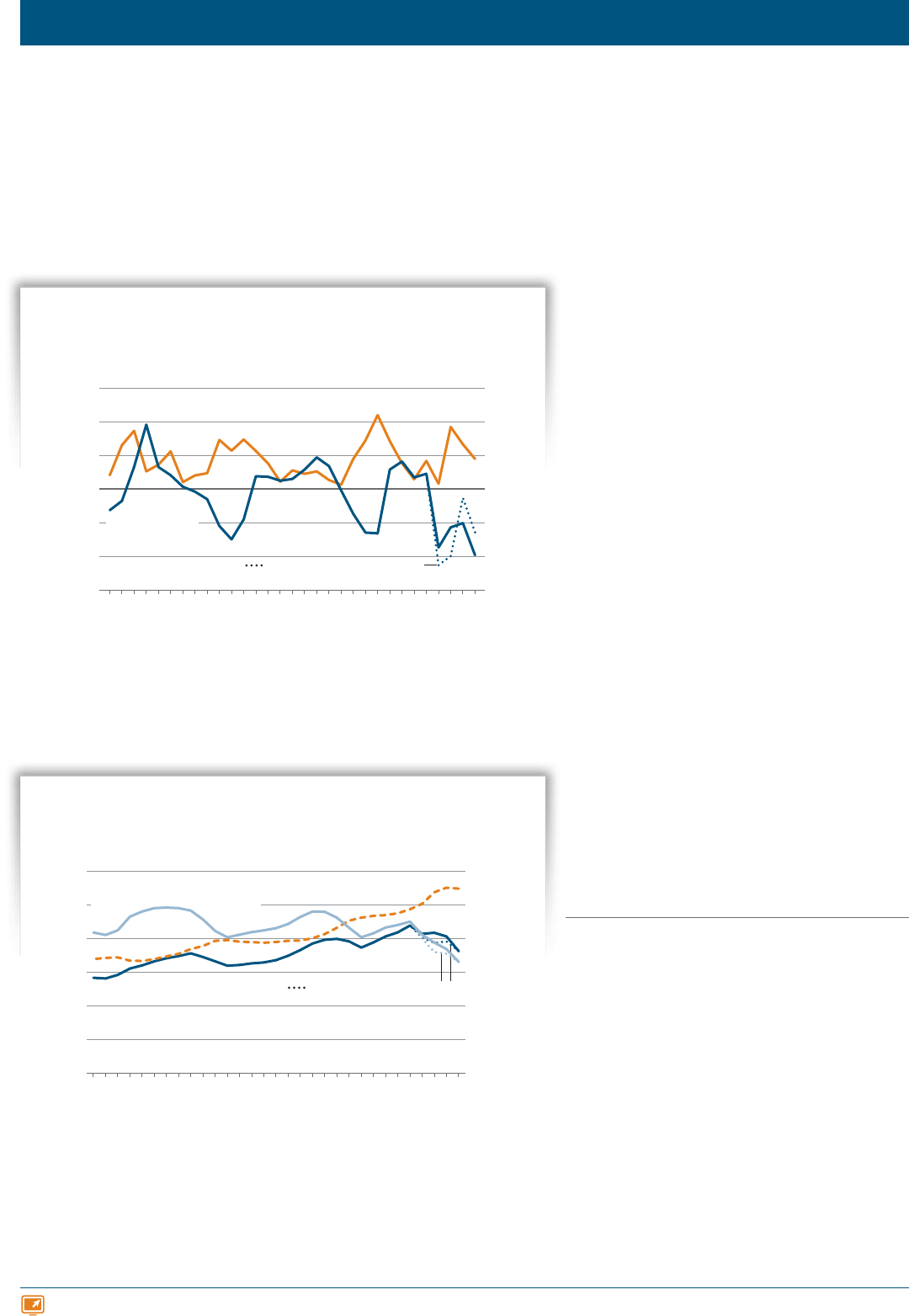
22 TRENDS IN COLLEGE PRICING 2012 trends.collegeboard.org
For detailed data behind the graphs and additional information, please visit: trends.collegeboard.org.
Institutional Revenues — Public Appropriations
•Three consecutive declines in ination-adjusted
appropriations per public FTE student from
2001-02 through 2003-04 were followed by three
years of increases in published tuition and fees,
averaging 8.5% and peaking in 2003-04.
•Total state appropriations to public colleges
and universities declined by 3% in 2010-11 and
by another 11% in 2011-12, after adjusting for
ination.
•State appropriations per public FTE student
increased by 1% from 1981-82 to 1991-92 and
by 9% from 1991-92 to 2001-02 after adjusting
for ination, but declined by 5% from 2001-02
to 2006-07, and by another 25% from 2006-07
to 2011-12, including a 10% decline in the most
recent year.
•Federal funds from the American Recovery and
Reinvestment Act supplemented state funds over
three scal years, increasing state appropriations
(in 2011 dollars) by $2.4 billion in 2008-09, $6.1
billion in 2009-10, and $2.9 billion in 2010-11.
•Total FTE enrollment in public two-year and four-
year colleges and universities grew by 16% from
1981-82 to 1991-92 and by 10% from 1991-92
to 2001-02. Enrollment growth was much
more rapid over the most recent decade, with
increases of 10% from 2001-02 to 2006-07 and
15% from 2006-07 to 2011-12.
ALSO IMPORTANT:
•From fall 2000 to fall 2010, total FTE enrollment in
public institutions in the United States increased by
33%. Enrollment growth ranged from 15% in Louisiana
and 16% in Illinois to 55% in Nevada and 69% in
Georgia. (Figure 23)
•Between 2006-07 and 2011-12, total state
appropriations for higher education, including federal
stimulus funds, increased by 60% in North Dakota and
by 21% in Wyoming. Appropriations declined by 33% in
New Hampshire, by 32% in Arizona, and by more than
10% in 14 additional states. (Illinois State University,
Grapevine, www.grapevine.ilstu.edu/fty_state_
summary.htm)
FIGURE 12A
Annual Percentage Change in State Appropriations for Higher Education
per Full-Time Equivalent (FTE) Student and Percentage Change in Ination-
Adjusted Tuition and Fees at Public Four-Year Institutions, 1981-82 to 2011-12
FIGURE 12B
State Appropriations for Higher Education: Total Appropriations in 2011 Dollars
(in Billions), Appropriations per Public FTE Student in 2011 Dollars, and Public
FTE Enrollment (in Millions), 1981-82 to 2011-12
NOTE: Enrollment gures are fall FTE enrollments for public two-year and four-year institutions.
Enrollment for fall 2011 was estimated based on preliminary IPEDS numbers. Appropriations
reported here are for institutional operating expenses, not for capital expenditures. Funding
includes both tax revenues and other state funds allocated to higher education.
SOURCES: The College Board, Annual Survey of Colleges; Illinois State University, Grapevine
reports; NCES, Digest of Education Statistics 2011, Table 227; calculations by the authors.
The 0% line corresponds to changes in appropriations per FTE student that
compensate only for the overall rate of ination in consumer prices. Negative
percentage changes indicate declines in ination-adjusted appropriations per
FTE student amounts. The blue dotted line represents the percentage change that
would have occurred were federal stimulus funds not appropriated in 2008-09
through 2010-11.
-15%
-10%
-5%
0%
5%
10%
15%
11-1205-0699-0093-9487-88 08-0902-0396-9790-9184-8581-82
Percentage Change
Academic Year
Excluding Federal Stimulus Funds
Public Four-Year
Tuition and Fees
Appropriations per
Public FTE Student
11-1205-0699-0093-9487-88 08-0902-0396-9790-9184-8581-82
Total Appropriations (Billions)
Public FTE Enrollment (Millions)
Excluding Federal Stimulus Funds
$0
$20
$40
$60
$80
$100
($)0
($)2
($)4
($)6
($)8
($)10
$120 ($)12
Public FTE Enrollment (in Millions)
and Appropriations per FTE
(in Thousands of 2011 Dollars)
Total Appropriations
(in Billions of 2011 Dollars)
Academic Year
Appropriations per FTE (Thousands)
Ination‑adjusted state appropriations per public full‑time equivalent (FTE) student fell sharply for
a fourth consecutive year in 2011‑12. The 10% decrease followed declines of 9% in 2008‑09, 6% in
2009‑10, and 5% in 2010‑11. The average annual real increase in published tuition and fees at public
four‑year institutions in the four years succeeding each of these declines was 6.0%.
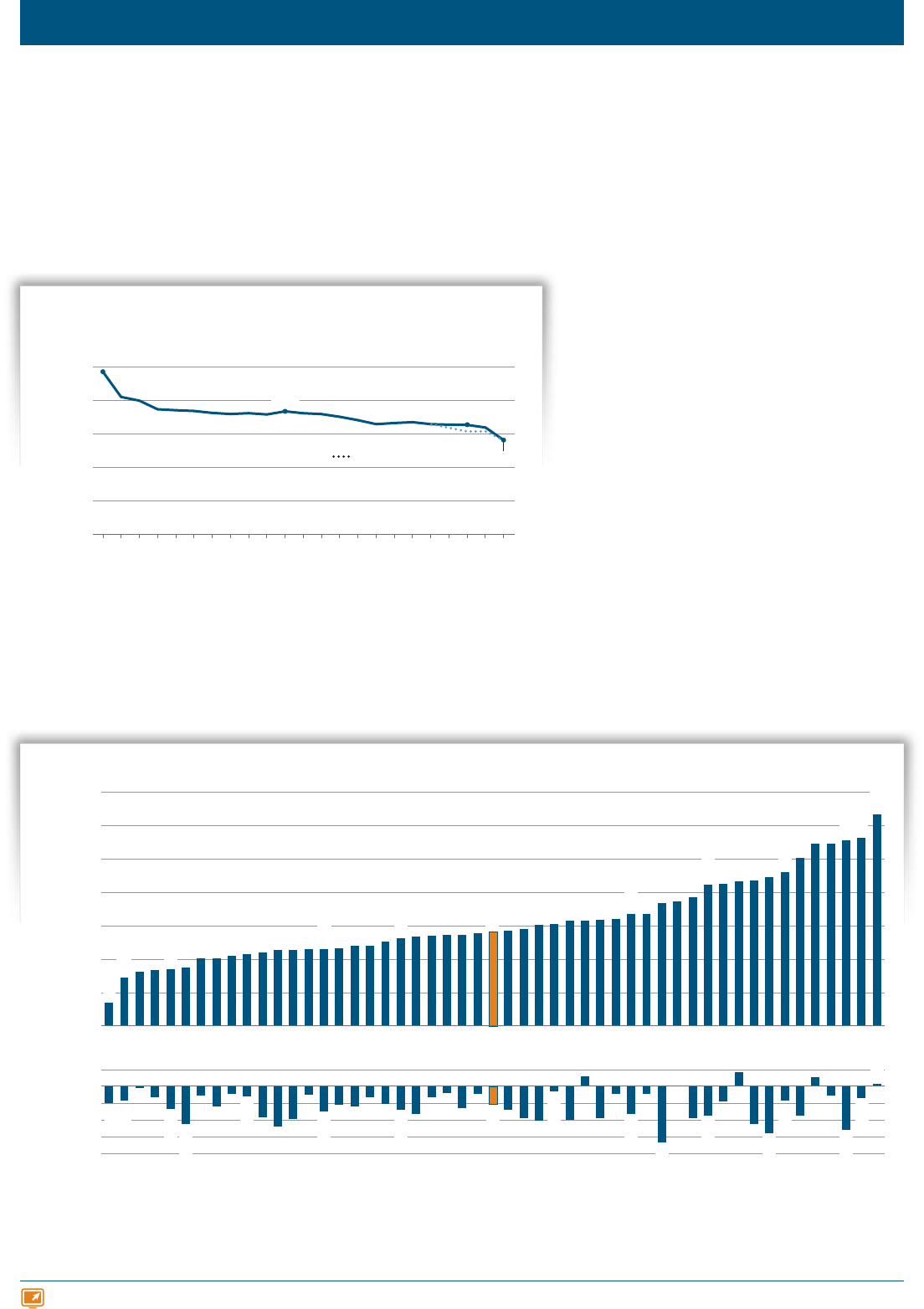
TRENDS IN HIGHER EDUCATION SERIES TRENDS IN COLLEGE PRICING 2012 23
For detailed data behind the graphs and additional information, please visit: trends.collegeboard.org.
Institutional Revenues — Public Appropriations
FIGURE 13A
Average State Appropriations for Higher Education per $1,000 in Personal
Income, 1989-90 to 2011-12
NOTE: The ratios of dollars of appropriations to dollars of personal income illustrated in Figure 13A
and Figure 13B are the same whether they are based on current dollars or ination-adjusted dollars.
SOURCES: Illinois State University, Grapevine reports; calculations by the authors.
SOURCE: Illinois State University, 2011-12 Grapevine data, Table 5.
State appropriations per $1,000 in personal income declined from $9.74 in 1989‑90 to $7.36 in
1999‑2000, to $6.55 in 2009‑10, and to $5.63 in 2011‑12 as the allocation of public resources moved
away from higher education toward other private and social goods and services.
•Average per capita personal income grew by 18%
from $32,400 in 1990 to $38,300 in 2000 (in 2010
dollars), and by another 6% to $40,600 in 2010.
(Statistical Abstract of the United States 2012,
Table 681; calculations by the authors)
•In 2011-12, when average state appropriations per
$1,000 in personal income were $5.63 for the nation
as a whole, New Hampshire provided $1.39 and
Colorado provided $2.88 per $1,000. At the other
end of the spectrum, appropriations per $1,000
in personal income were $11.09 in New Mexico,
$11.24 in North Carolina, and $12.63 in Wyoming.
•From 2006-07 to 2011-12, appropriations per
$1,000 in personal income fell by $1.08 (16%) for
the nation as a whole. The largest dollar declines
were $3.38 in Louisiana (32%) and $2.80 in
Alabama (24%). New Hampshire’s decline was
$1.01 (42%) and Arizona’s was $2.25 (39%).
•In ve states, state appropriations per $1,000
in personal income increased between 2006-07
and 2011-12. The largest increases were in West
Virginia, Illinois, and North Dakota.
FIGURE 13B State Appropriations for Higher Education per $1,000 in Personal Income, 2011-12 and 5-Year Change
from 2006-07 to 2011-12
$0
$2
$4
$6
$8
$10
Academic Year
Appropriations per
$1,000 in Personal Income
Excluding Federal Stimulus Funds
11-1209-1007-0805-0603-0401-0299-0097-9895-9693-9491-9289-90
$9.74
$7.36
$6.55
$5.63
$0
$2
$4
$6
$8
$10
$12
$14
State Appropriations
per $1,000 in Personal Income, 2011-12
$0
-$4
-$3
-$2
-$1
$1
Wyoming
North Carolina
New Mexico
Alaska
North Dakota
Mississippi
Arkansas
Alabama
Hawaii
West Virginia
Nebraska
Kentucky
Utah
Georgia
Louisiana
Indiana
Oklahoma
Texas
Kansas
Illinois
Idaho
Tennessee
Iowa
California
Delaware
United States
Montana
South Carolina
Maryland
Maine
Minnesota
South Dakota
Wisconsin
Florida
New York
Ohio
Michigan
Connecticut
Nevada
Washington
Virginia
New Jersey
Rhode Island
Oregon
Missouri
Arizona
Pennsylvania
Vermont
Massachusetts
Colorado
New Hampshire
5-Year Change
from 2006-07 to 2011-12
State
WY
NC
NM
AK
ND
MS
AR
AL
HI
WV
NE
KY
UT
GA
LA
IN
OK
TX
KS
IL
ID
TN
IA
CA
DE
US
MT
SC
MD
ME
MN
SD
WI
FL
NY
OH
MI
CT
NV
WA
VA
NJ
RI
OR
MO
AZ
PA
VT
MA
CO
NH
$12.63
$11.24
$9.17
$6.70
$6.08
$5.63
$4.58
$5.25
$3.39
$1.39
$2.88
$0.12
-$0.72
-$0.87
-$1.67
-$0.30
-$1.08
-$1.52
-$1.40
-$1.37
-$1.01
-$0.84
$4.28-$0.61
$8.42-$1.75
$11.09-$2.60
-$2.25
-$3.38
-$2.80
The Bureau of Economic Analysis (BEA) measure of personal income is the sum of
income from all sources received by individuals. It includes earnings (net of social
insurance taxes but not income taxes) plus interest, dividends, rental income, and
transfer payments received by individuals. Personal income is a measure of the
scal capacity of the state.
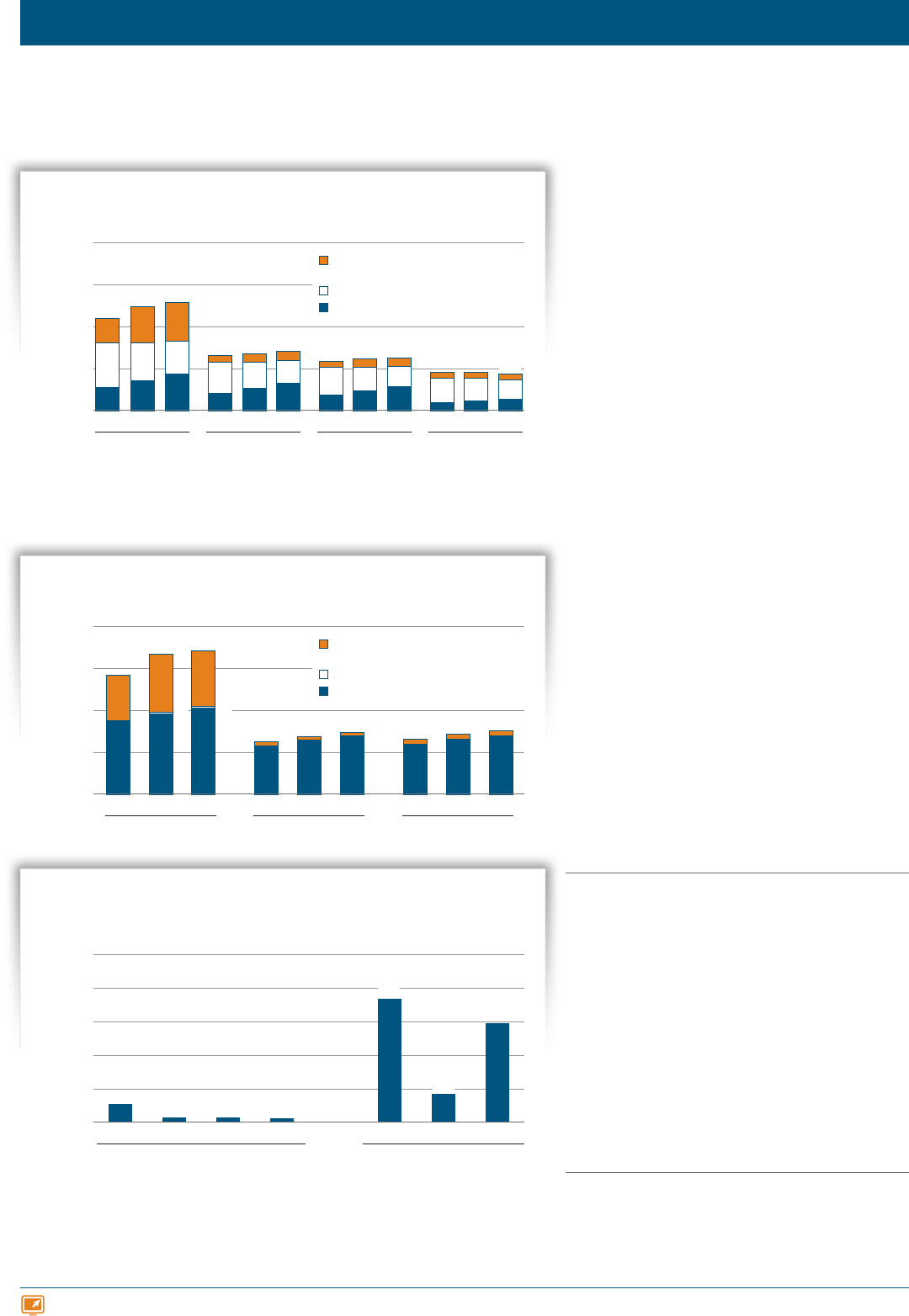
24 TRENDS IN COLLEGE PRICING 2012 trends.collegeboard.org
For detailed data behind the graphs and additional information, please visit: trends.collegeboard.org.
Institutional Revenues
At all types of public institutions, the
average share of revenues coming from
net tuition increased between 1999‑2000
and 2009‑10, while the share coming from
state and local appropriations decreased.
•Among public doctoral institutions, net tuition as
a percentage of total revenues from net tuition
and federal, state, and local appropriations,
grants, and contracts increased from 25% in
1999-2000 to 34% in 2009-10, while state and
local appropriations decreased from 49% to 31%.
•In 2009-10, tuition contributed 60% of revenues
from the combination of the categories included
in Figure 14B for private doctoral universities,
95% for private master’s universities, and 93%
for private bachelor’s colleges.
•Revenue from private gifts, investment returns,
and endowment income supplements the revenue
sources shown in Figures 14A and 14B. For private
doctoral universities, this additional revenue was
approximately 74% as large as the sum of the
revenue sources included in Figure 14B over the
1999-2000 to 2009-10 decade. The corresponding
percentage was 59% for private bachelor’s colleges,
but only 17% for private master’s institutions.
•At private doctoral universities, revenue from
gifts, investment income, and endowment
earnings fell, on average, from 185% of the total
revenues from the sources included in Figure
14B in 1999-2000 to 30% in 2000-01 and was
more than 50% higher than the total from the
other revenue sources in 2006-07. Losses from
this source exceeded combined revenues from
the other sources in 2008-09.
ALSO IMPORTANT:
•Changes in accrued asset value are not a reliable measure
of the resources available for annual institutional budgets.
It is common practice for institutions to spend a xed
percentage of their endowment values each year, but to
smooth spending by using a three-year moving average
of the endowment value.
•Colleges and universities also receive revenues from
auxiliary enterprises, hospitals, and independent
operations. Revenues from enterprises such as
dormitories and dining halls are usually dedicated to
running those operations. In 2009-10, average revenue per
FTE student from these sources ranged from $20,940 at
private doctoral universities (many of which have hospitals)
to $5,260 at private bachelor’s colleges, and to $580 at
public two-year colleges, which rarely have dormitories.
Revenue from private gifts, investment income, and endowment returns is measured
by the change in asset value from one year to the next. Figure 14C shows the ratio of
the sum of revenue received from these sources across all years from 1999-2000 to
2009-10 to the sum of revenue received from net tuition and fees and federal, state,
and local appropriations, grants, and contracts over these 11 years. In some years,
investment income was negative.
$0
$10,000
$20,000
$30,000
$40,000
Revenue in 2010 Dollars
Academic Year and Institution Type
Public Two-YearPublic Bachelor’sPublic Master’sPublic Doctoral
09-1004-0599-00
09-10
04-0599-0009-10
04-05
99-0009-1004-0599-00
31%26%
22%
45%39%31%46%40%32%34%29%25%
54%
58%
64%
38%
46%
56%
39%
46%
56%
31%
36%
49%
15%
15%
14%
17%
16%
13%
15%
14%
12%
35%
35%
26%
State and Local Appropriations
Federal Appropriations and Federal,
State, and Local Grants and Contracts
Net Tuition and Fee Revenue
$0
$10,000
$20,000
$30,000
$40,000
Revenue in 2010 Dollars
Academic Year and Institution Type
Private Bachelor’sPrivate Master’sPrivate Doctoral
09-1004-0599-0009-1004-0599-0009-1004-0599-00
93%92%91%95%93%92%60%57%61%
0%
0%
0%
0%
0%
1%
1%
1%
1%
7%
8%
9%
5%
6%
7%
39%
42%
38%
State and Local Appropriations
Federal Appropriations and Federal,
State, and Local Grants and Contracts
Net Tuition and Fee Revenue
0%
20%
40%
80%
60%
100%
Percentage
Institution Type
PrivatePublic
Bachelor’sMaster’sDoctoralTwo-YearBachelor’sMaster’sDoctoral
59%
17%
74%
3%3%3%
11%
FIGURE 14C
Aggregate Total Revenue from Private Gifts, Investment Returns, and
Endowment Income as a Percentage of Aggregate Revenue from Other
Sources, 1999-2000 to 2009-10
FIGURE 14B
Institutional Revenues per FTE Student in 2010 Dollars at Private Nonprot
Institutions, by Revenue Source, 1999-2000 to 2009-10, Selected Years
FIGURE 14A
Institutional Revenues per FTE Student in 2010 Dollars at Public Institutions,
byRevenue Source, 1999-2000 to 2009-10, Selected Years
NOTE: The institutional averages reported in Figures 14A
and 14B are weighted by 12-month FTE enrollments. The
averages reported by the Delta Cost Project are unweighted
averages across institutions. Percentages may not sum to 100
because of rounding.
SOURCES: The Delta Cost Project; calculations by the authors.
Net tuition revenue is the amount of revenue an institution takes in from tuition
and fees, net of all institutional grant aid provided to students. Some of this
revenue comes in the form of nancial aid to students from federal and state
governments and other sources.

TRENDS IN HIGHER EDUCATION SERIES TRENDS IN COLLEGE PRICING 2012 25
For detailed data behind the graphs and additional information, please visit: trends.collegeboard.org.
Institutional Revenues and Expenditures
The percentages on the horizontal axis of the graph correspond to the percentages
of education and related expenses covered by net tuition and fees. For example,
53% of the $16,230 in average expenditures per FTE student at public doctoral
universities in 2009-10 was covered by net tuition and fee revenue, and the other
47% was covered by state and local appropriations and other revenue sources.
Net tuition revenue is the amount of revenue an institution takes in from tuition
and fees, net of all institutional grant aid provided to students. Some of this
revenue comes in the form of nancial aid to students from federal and state
governments and other sources.
Education and related expenditures include spending on instruction, student services,
and the education share of spending on central academic and administrative
support as well as operations and maintenance. Expenditures for both
undergraduate students and graduate students are included in these estimates.
NOTE: Averages represent FTE enrollment-weighted averages of education and related
expenses per FTE student. Averages reported by the Delta Cost Project are unweighted
averages across institutions. Because of differences in undergraduate and graduate tuition,
tuition paid by part-time, out-of-state, and international students; and accounting conventions,
these net tuition-per-student gures are not comparable to either the published prices or the
net prices faced by students reported elsewhere in Trends in College Pricing.
SOURCES: The Delta Cost Project; calculations by the authors.
In all sectors, with the exception
of private doctoral universities, net
tuition and fee revenue grew more
rapidly than education and related
expenditures between 1999‑2000 and
2009‑10, while subsidies per full‑time
equivalent (FTE) student declined.
•After adjusting for ination, net tuition and fee
revenue per FTE student at public two-year
colleges increased at an average annual rate of
about 3.1% between 1999-2000 and 2009-10.
The growth rate was between 4.4% and 4.7% at
all types of public four-year institutions.
•Net tuition and fee revenue per FTE student
increased at a slower rate in the private sector
than in the public sector between 1999-2000 and
2009-10. After adjusting for ination, the average
annual rate of increase was between 1.6% and
1.9% for each category of private nonprot
institutions.
•In 2009-10, average net tuition and fee revenue
per FTE student ranged from $2,680 at public
two-year colleges to $20,600 at private doctoral
universities.
•In 2009-10, education and related expenditures
per FTE student ranged from $7,650 at public
two-year colleges to $37,860 at private doctoral
universities, where about one-third of all students
are graduate students.
•Education and related expenditures grew most
rapidly at private doctoral universities between
1999-2000 and 2009-10 — at an average annual
rate of 2.4% in ination-adjusted dollars. At public
two-year colleges, these expenditures declined
from $8,640 per FTE student (in 2010 dollars) to
$7,650 over this 10-year period.
•Subsidies per FTE student — the difference
between education expenditures and net tuition
revenues — increased by $4,680 in 2010 dollars
(37%) between 1999-2000 and 2009-10 at private
doctoral universities. Subsidies declined in all
other sectors, including a $1,700 (25%) decline
at public two-year colleges.
•In 2009-10, average subsidies per FTE student
ranged from $980 at private master’s universities
to $17,260 at private doctoral universities.
FIGURE 15A
Net Tuition Revenues, Subsidies, and Education and Related Expenditures
per Full-Time Equivalent (FTE) Student in 2010 Dollars at Public Institutions
(and Percentage of Expenditures Covered by Net Tuition), 1999-2000, 2004-05,
and 2009-10
FIGURE 15B
Net Tuition Revenues, Subsidies, and Education and Related Expenditures
per Full-Time Equivalent (FTE) Student in 2010 Dollars at Private Nonprot
Institutions (and Percentage of Expenditures Covered by Net Tuition),
1999-2000, 2004-05, and 2009-10
$0
$10,000
$20,000
$30,000
Net Tuition Revenue and Subsidy
Subsidy
Net Tuition Revenue
Academic Year and Institution Type
Public Two-YearPublic Bachelor’sPublic Master’sPublic Doctoral
09-10
(35%)
04-05
(30%)
99-00
(23%)
09-10
(51%)
04-05
(45%)
99-00
(35%)
09-10
(54%)
04-05
(48%)
99-00
(37%)
09-10
(53%)
04-05
(48%)
99-00
(37%)
$9,390
$7,750
$7,570
$7,200
$5,780
$5,480
$6,900
$5,740
$5,530
$6,670
$5,640
$4,970
$14,870
$14,850
$16,230
$11,380
$11,190
$11,920
$10,550
$10,500
$11,220
$8,640
$8,070
$7,650
$5,480 $7,100 $8,660 $4,180 $5,410 $6,440 $3,650 $4,760 $5,690
$1,970 $2,680$2,430
$0
$10,000
$20,000
$30,000
$40,000
Net Tuition Revenue and Subsidy
Subsidy
Net Tuition Revenue
Academic Year and Institution Type
Private Bachelor’sPrivate Master’sPrivate Doctoral
09-10
(70%)
04-05
(67%)
99-00
(64%)
09-10
(93%)
04-05
(90%)
99-00
(85%)
09-10
(54%)
04-05
(56%)
99-00
(58%)
$29,910
$34,210
$37,860
$13,490
$14,240
$14,850
$18,580
$19,620
$19,970
$12,580
$15,080
$17,260
$1,970 $1,460 $980
$6,670
$6,460
$5,980
$17,330 $19,130 $20,600 $11,520 $12,780 $13,870 $11,910 $13,160 $13,990
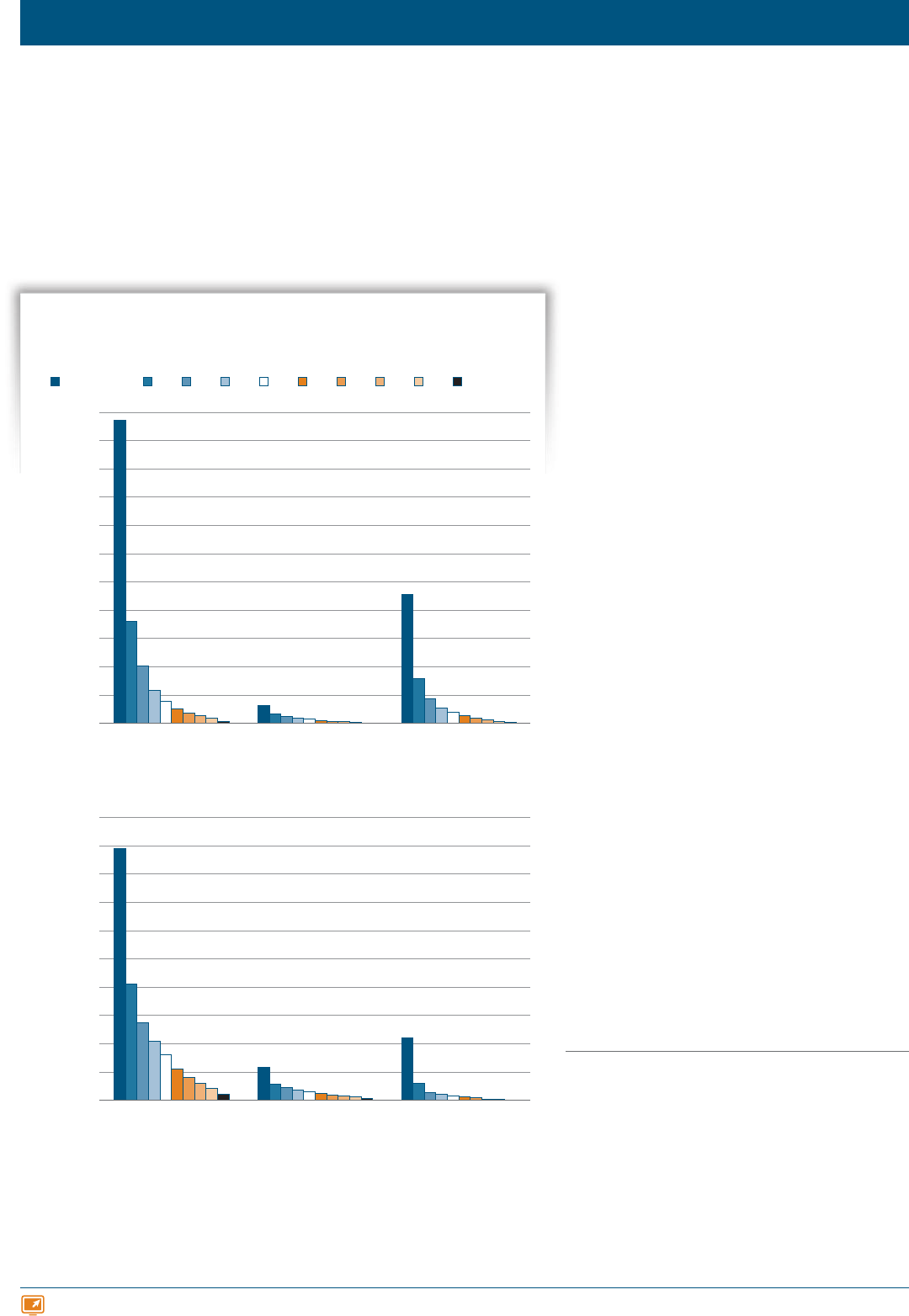
26 TRENDS IN COLLEGE PRICING 2012 trends.collegeboard.org
For detailed data behind the graphs and additional information, please visit: trends.collegeboard.org.
Endowments
•Average endowment per student is about nine
times as high in private doctoral institutions as in
public doctoral institutions. The private-to-public
ratio is about 5 to 1 for master’s universities and
about 23 to 1 for bachelor’s colleges.
•Assuming a spending rate of about 5% of the
endowment value, the 5% of students in the
18 private bachelor’s colleges with the highest
endowment assets per student beneted
from about $31,000 per year in income from
the endowment in 2010-11. The second 5% of
students beneted from about $15,000 per year
from their institutions’ endowments.
•Among private doctoral universities, the four
institutions with the highest endowment assets
per student enroll 6% of the students in that
sector. These students beneted from an average
of $72,000 of annual endowment income per
student in 2010-11 — more than twice as much
as the average of $32,000 per student at the
other institutions in the top decile.
•The 5% of students enrolled at the seven
public doctoral universities with the highest
endowments per student beneted from about
$5,900 of annual endowment income per student
in 2010-11 — more than twice as much as the
$2,700 per student for the second 5%.
FIGURE 16
Endowment Assets per Full-Time Equivalent (FTE) Student at Four-Year
Colleges and Universities by Decile and Carnegie Classication, 2010-11
Endowment assets are highly concentrated among a small number of institutions within each sector.
Ten private doctoral universities hold about 43% of the total endowment assets of all private nonprot
doctoral, master’s, and bachelor’s institutions combined, and 10 public doctoral universities hold about
34% of the total endowment assets of public doctoral, master’s, and bachelor’s institutions combined.
NOTE: The value of endowment assets was as of the end
of scal year 2011. Endowment assets were based on data
for 105 private doctoral, 342 private master’s, 463 private
bachelor’s, 170 public doctoral, 258 public master’s, and
94 public bachelor’s institutions. Average endowment per
FTE for each decile of institutions is calculated by ordering
the institutions in the sector by assets per FTE and dividing
the students in the sector into deciles. Total assets in the
institutions enrolling 10% of students in the sector are
divided by the number of students in those institutions.
SOURCES: National Association of College and University
Business Ofcers (NACUBO) Endowment Study;
Commonfund Institute; NCES, IPEDS; calculations by the
authors. Data are from NACUBO where available.
Endowment Assets per FTE Student
$0
$100,000
$200,000
$300,000
$400,000
$500,000
$600,000
$700,000
$800,000
$900,000
$1,000,000
Carnegie Classication
Bachelor’s
(Median = $33,100)
(Mean = $87,500)
Master’s
(Median = $11,800)
(Mean = $18,300)
Doctoral
(Median = $67,200)
(Mean = $204,300)
Endowment Assets per FTE Student
Carnegie Classication
$0
$10,000
$20,000
$30,000
$40,000
$50,000
$60,000
$70,000
$80,000
$90,000
$100,000
Bachelor’s
(Median = $1,400)
(Mean = $3,900)
Master’s
(Median = $2,600)
(Mean = $3,600)
Doctoral
(Median = $14,300)
(Mean = $22,700)
Private Nonprot Four-Year
Public Four-Year
$1,100,000
Highest Decile 2nd 3rd 4th 5th 6th 7th 8th 9th Lowest Decile
Endowments consist of funds that have been donated to colleges and universities
and returns that have accumulated over time on those funds. Attached to some of
these funds is a requirement that the principal be preserved in perpetuity. Restricted
endowment funds can only be used to support purposes specied by the donor.
Institutions have more exibility over the use of unrestricted endowment funds.
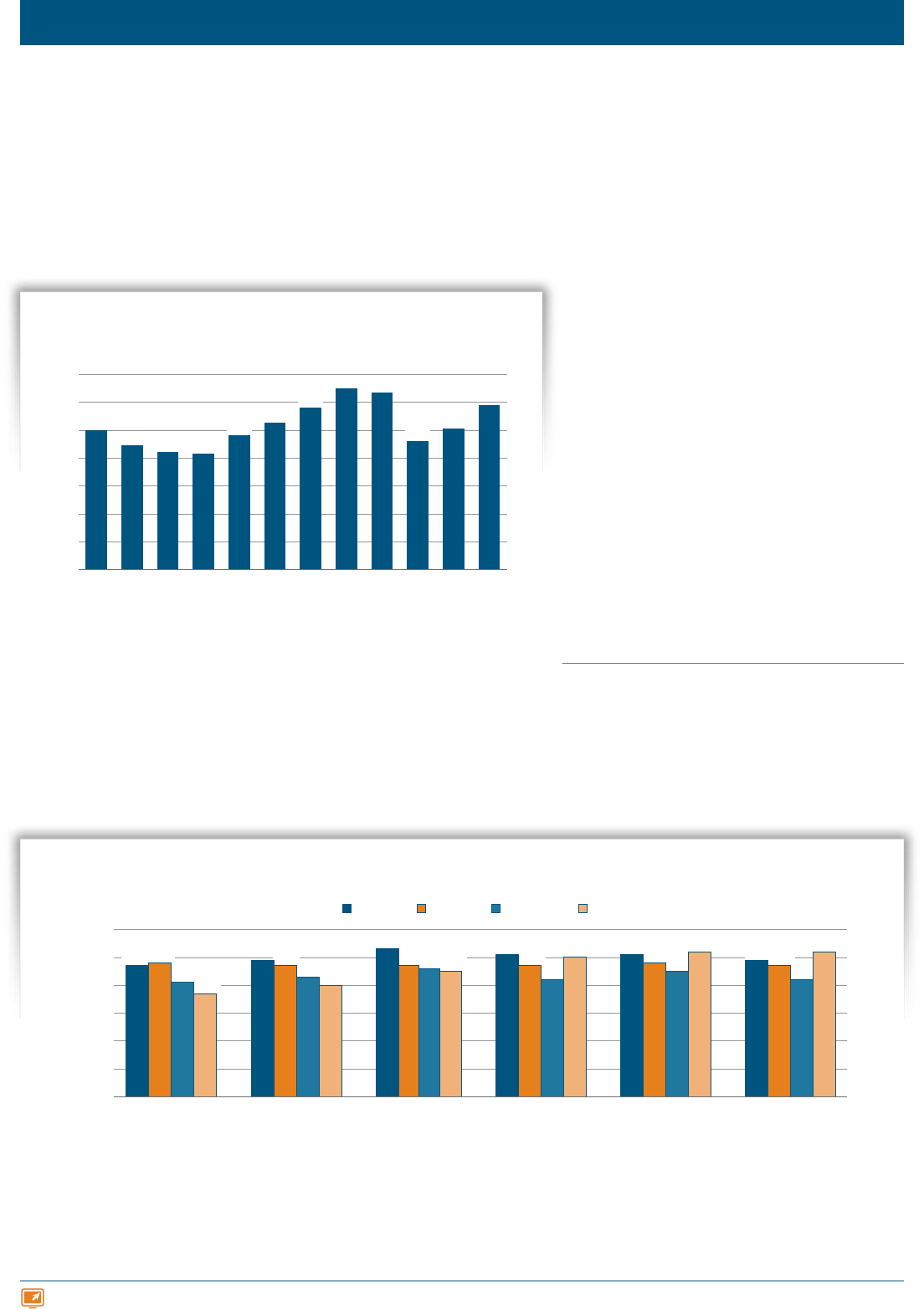
TRENDS IN HIGHER EDUCATION SERIES TRENDS IN COLLEGE PRICING 2012 27
For detailed data behind the graphs and additional information, please visit: trends.collegeboard.org.
Endowments
NOTE: Reported spending rates are simple averages of spending rates reported by individual institutions and are not weighted by enrollments.
SOURCES: NACUBO, Endowment Study; Commonfund Institute.
The spending rate is dened as the percentage of the beginning market value of the endowment that is withdrawn to support institutional
expenditures. The rate is calculated net of any investment fees or other expenses related to managing and administering the endowment.
FIGURE 17A
Ination-Adjusted Endowment Assets at Private Nonprot Four-Year Colleges
and Universities Relative to 1999-2000, 1999-2000 to 2010-11
FIGURE 17B
Average Reported Spending Rates for College and University Endowments and Afliated Foundations, 2001-02 to 2010-11, Selected Years
NOTE: The value of endowment assets was as of the end of June (i.e., June 2011 for 2010-11).
Because IPEDS endowment data are available for only a limited number of institutions before
2002-03, the analysis is based on 140 private nonprot four-year institutions that reported data
for each year from 1999-2000 to 2002-03 and 1,021 institutions that reported data for each year
from 2003-04 to 2010-11.
SOURCES: NACUBO, Endowment Study; Commonfund Institute; NCES, IPEDS; calculations
by the authors. Data are from NACUBO and Commonfund Institute where available.
0.0
0.2
0.4
0.6
0.8
1.0
1.2
Ratio
Academic Year
1.4
10-1109-1008-0907-0806-0705-0604-0503-0402-0301-0200-0199-00
1.00
0.89
0.84
0.83
0.96
1.05
1.16
1.30
1.27
1.01
0.92
1.18
•On average, the value of endowment assets in
the private nonprot four-year sector declined
almost 30% in 2008-09 to a level slightly below
their 2003-04 value (in 2011 dollars). The 2010-11
increase brought assets back to approximately
their 2005-06 value.
•Since 2007-08, the wealthiest institutions have
increased their draw from endowments, while
the spending rates have continued to decline
for those with endowments below $100 million.
For example, the average spending rate rose
from 4.2% in 2007-08 to 5.2% in 2010-11
for institutions with assets of $1 billion or
higher, and from 4.2% to 5.0% for those with
assets between $101 million and $500 million.
Institutions with endowments of $50 million or
less lowered their spending rates after 2007-08.
ALSO IMPORTANT:
•According to NACUBO, the overall average endowment
spending rate for public institutions was 4.5% in
2010-11, higher than in the previous two years.
•The overall average endowment spending rate for
private colleges and universities fell from 5.0% in
2001-02 to 4.3% in 2007-08. It was 4.6% in 2010-11.
In 2010‑11, average endowment assets at private nonprot four‑year colleges and universities
increased in value by about 17% after adjusting for ination, following a 10% increase in 2009‑10.
Average Spending Rate
0.0%
1.0%
2.0%
3.0%
4.0%
5.0%
6.0%
Endowment Size
Over
$1 Billion
$501 Million
to
$1 Billion
$101 Million
to
$500 Million
$51 Million
to
$100 Million
$25 Million
to
$50 Million
Under
$25 Million
2010-112007-082004-052001-02
4.7%
4.9%
5.3%
5.1%
5.1%
4.9%
4.8%
4.7%
4.7%
4.7%
4.8%
4.7%
3.7%
4.0%
4.5%
5.0%
5.2% 5.2%
4.1%
4.3%
4.6%
4.2%
4.5%
4.2%

28 TRENDS IN COLLEGE PRICING 2012 trends.collegeboard.org
For detailed data behind the graphs and additional information, please visit: trends.collegeboard.org.
Family Income
Over the entire income distribution
in the United States, average family
incomes in 2011 were lower in
ination‑adjusted dollars than they
were a decade earlier. The largest
declines were for the families in the
lowest 20% of the population.
•Average ination-adjusted income declined for
all income groups every year from 2007 to 2010.
It fell again in 2011 — by 1% to 2% — for each
of the four lower income groups, but increased
by 3% for the 20% of families with the highest
incomes and by 7% for the top 5%.
•Over the three decades from 1981 to 2011,
average family income declined by 5% ($860 in
2011 dollars) for the poorest 20% of families.
Average income rose by 14% ($7,342) for the
middle 20% of families and by 95% ($167,797)
for the wealthiest 5% of families.
•In 2011, when median family income for all
families was $60,974, the median income for
families headed by individuals ages 45 to 54 —
the age bracket of most parents of traditional-age
college students — was $76,551 (26% higher
than the overall median).
•In 2011, the median income for black and
Hispanic families was less than 60% of the
median income for white families.
•In 2011, the $100,096 median family income for
families headed by a four-year college graduate
was more than twice the median income for
families headed by a high school graduate.
ALSO IMPORTANT:
•The share of all income going to the 20% of families
with the lowest incomes has steadily declined, from
5.3% in 1981 to 4.5% in 1991, 4.2% in 2001, and 3.8%
in 2011. The share of income going to the top 5% of
families rose from 14.4% to 21.3% over this 30-year
period. (U.S. Census Bureau, Current Population
Survey, Table F-2)
•Average published tuition and fees at public four-year
colleges rose by about $6,100 (in 2011 dollars) over this
30-year period — about 83% of the increase in income
($7,342) of the middle 20% of families and about 9% of
the increase in income ($71,452) of the 20% of families
in the highest income bracket.
FIGURE 18A
Percentage Change in Ination-Adjusted Mean Family Income by Quintile,
1981–1991, 1991–2001, and 2001–2011
FIGURE 18B
Median Family Income by Selected Characteristics, 2011
Years
Percentage Change
2001–20111991–20011981–1991
-10%
0%
10%
20%
30%
40%
50%
-20%
Top 5%Highest 20%Fourth 20%Third 20%Second 20%Lowest 20%
-3%
14%
-14%
6%
11%
-9%
8%
13%
-7%
11%
16%
-4%
22%
32%
-2%
35%
50%
-3%
Bachelor’s or Higher
Associate
Some College
High School
Less Than High School
65 and over
55–64
45–54
35–44
25–34
15–24
Black
Hispanic
White, Non-Hispanic
Asian
West
South
Midwest
Northeast
Education
Age
Race/Ethnicity
Region
Characteristic
Median Family Income
$0 $20,000 $40,000 $60,000 $80,000 $100,000 $120,000
$68,084
$61,824
$56,869
$62,458
$72,996
$69,829
$40,061
$40,495
$30,286
$50,643
$66,259
$76,551
$72,757
$48,538
$30,103
$48,460
$57,005
$66,252
$100,096
SOURCES: U.S. Census Bureau, Current Population Survey,
Table F-1, Table F-3, Table F-5, and FINC-01; calculations by the
authors.
Lowest 20% Second 20% Third 20% Fourth 20% Highest 20% Top 5%
$ Change 1981–2011 -$860 $2,452 $7,342 $17,851 $71,452 $167,797
% Change 1981–2011 -5% 7% 14% 24% 56% 95%
2011 Income Bracket
$27,218
or less
$27,219
to $48,502
$48,503
to $75,000
$75,001
to $115,866
$115,867
or more
$205,200
or more
2011 Mean Income $15,282 $37,556 $61,032 $93,232 $197,932 $344,531

TRENDS IN STUDENT AID 2010 29TRENDS IN HIGHER EDUCATION SERIES TRENDS IN COLLEGE PRICING 2012 29
For detailed data behind the graphs and additional information, please visit: trends.collegeboard.org.
Enrollment Patterns over Time
NOTE: Percentages on the y-axis represent the enrollment in
each sector as a percentage of total enrollment. Non-degree
students reported here are those enrolled in institutions that
do not award associate, baccalaureate, or graduate degrees.
Percentages may not sum to 100 because of rounding.
SOURCE: NCES, IPEDS unpublished data.
In the decade between 1990 and 2000,
the number of full‑time undergraduate
students increased by 14%, from 6.9
million to 7.9 million. In the following
decade, the number increased by 44%,
from 7.9 million to 11.4 million.
•In the most recent decade, 35% of the increase in
enrollment of full-time undergraduate students was
in the public four-year sector. About a quarter of the
new students were in public two-year colleges and
a similar number enrolled in for-prot institutions.
•The number of part-time undergraduate students
increased by 6%, from 4.9 million to 5.2 million,
between fall 1990 and fall 2000. The number
increased by 27%, from 5.2 million to 6.6 million,
between fall 2000 and fall 2010.
•In the most recent decade, 41% of the increase in
enrollment of part-time undergraduate students was
in the public two-year sector. About 28% of the new
students were in public four-year institutions and a
similar number enrolled in for-prot institutions.
•In fall 2010, graduate students constituted
31%of the students in private nonprot four-year
institutions, compared to 18% in public four-year
colleges and universities.
•In fall 2010, about 17% of students in the for-prot
sector attended institutions that award certicates,
but not associate, bachelor’s, or graduate degrees.
ALSO IMPORTANT:
•Most non-degree-granting institutions offer programs of
study that are less than two years in duration. Some of
them, however, do offer graduate or rst-professional
certicates, postbaccalaureate certicates, or other
certicates that require two or more years of study.
•Students enrolled in non-degree-granting institutions
may be eligible for federal student aid if they are
working toward certicates at accredited institutions.
•All of the students reported in Figure 19 were enrolled
in institutions that participate in federal student aid
programs. Additionally, about 600,000–800,000 students
were enrolled in the late 2000s in for-prot institutions
that do not participate in these programs and are not
included in the Department of Education’s data. (S.Cellini
and C.Goldin, “Does Federal Student Aid Raise Tuition?
New Evidence on For-Prot Colleges,” NBER Working
Paper 17827, www.nber.org/papers/w17827)
FIGURE 19
Distribution of Students by Attendance Status and Level of Enrollment (with
Percentage of All Students Enrolled in Each Sector), Fall 1990 Through Fall 2010,
Selected Years
Non-Degree-
Granting Institutions
All
Graduate
Undergraduate
Part-Time
Undergraduate
Full-Time
Total Enrollment (Millions)
0 1 2 3 4 5 6 7 8
Public Four-YearPublic Two-YearPrivate Nonprot Four-YearFor-Prot
1990 (43%)
1995 (41%)
2000 (39%)
2005 (38%)
2010 (37%)
1990 (36%)
1995 (37%)
2000 (37%)
2005 (35%)
2010 (34%)
1990 (19%)
1995 (20%)
2000 (20%)
2005 (19%)
2010 (18%)
1990 (2%)
1995 (2%)
2000 (4%)
2005 (7%)
2010 (11%)
0.0 0.1 0.2 0.3 0.4 0.5 0.6 0.7
Total Enrollment (Millions)
For-Prot Detail
66%
61%
49%
18%
19%
11%
4%
7%
7%
12%
14%
33%
673,000
240,000
214,000
61%
61%
63%
64%
64%
20%
19%
17%
17%
18%
19%
20%
20%
19%
18%
34%
35%
35%
38%
41%
66%
65%
64%
61%
59%
1%
1%
1%
53%
52%
11%
19%
12%
12%
24%
17%
56%
55%
57%
58%
57%
17%
16%
13%
12%
12%
27%
29%
29%
30%
31%
7,925,000
6,838,000
6,056,000
5,815,000
5,848,000
7,285,000
6,235,000
5,759,000
5,277,000
4,996,000
3,822,000
3,411,000
3,052,000
2,854,000
2,671,000
2,426,000
1,323,000
3,052,000
2,854,000
2,671,000
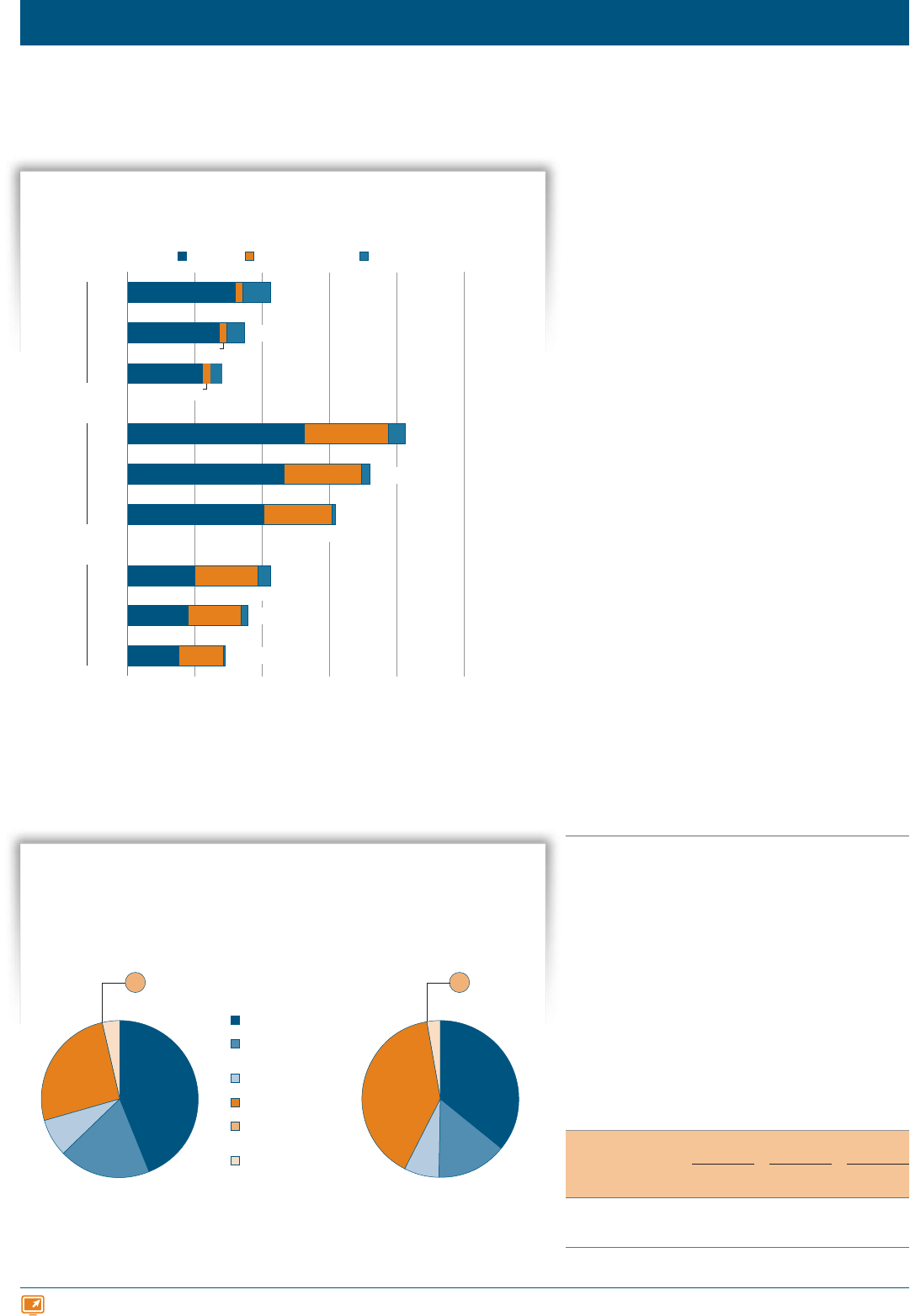
30 TRENDS IN COLLEGE PRICING 2012 trends.collegeboard.org
See Figure 2010_20B online for data on online course participation over time.
Enrollment and Degrees Granted
The share of degrees awarded by
for‑prot institutions increased from
4% to 10% between 1999‑2000 and
2009‑10. In contrast, the percentage of
degrees awarded by public and private
nonprot institutions during this
10‑year period declined from 66% to
62% and from 30% to 28%, respectively.
•Over the decade from 1999-2000 to 2009-10, the
percentage of all associate degrees awarded by
for-prot institutions increased from 12% to 19%,
the percentage of all bachelor’s degrees awarded by
for-prot institutions increased from 2% to 6%, and
the percentage of all graduate degrees awarded by
this sector increased from 2% to 9%.
•Bachelor’s degrees declined from 52% of all degrees
conferred in 1999-2000 to 49% in 2009-10. Both
associate degrees and graduate degrees increased
from 24% to 25% of the total over the decade.
•Because 59% of public two-year college
students were enrolled part-time in fall 2010,
students in this sector represented 40% of all
undergraduate students, but only 26% of full-
time undergraduate students.
•In fall 2010, 44% of full-time undergraduates —
and 36% of all undergraduates — were enrolled
in public four-year institutions.
ALSO IMPORTANT:
•In addition to the 18.1 million undergraduate students
enrolled in degree-granting institutions in fall 2010,
there were 572,000 undergraduates enrolled in
non-degree-granting institutions. Fifty-six percent of
these students attended for-prot less-than-two-year
institutions. Another 16% attended for-prot two-year
institutions; 12% attended public less-than-two-
year institutions; and 12% attended public two-year
institutions. Many non-degree-seeking students are
working toward vocational certicates. (NCES, IPEDS
unpublished data)
Percentage of Undergraduate Students Enrolled
Part-Time in Fall 2010, by Sector
All
Degree-
Granting
Public
Private
Nonprot For-Prot
Four-
Year
Two-
Year
Four-
Year
Two-
Year
Four-
Year
Two-
Year
Percentage
Enrolled
Part-Time
37% 22% 59% 17% 29% 33% 9%
FIGURE 20
Distribution of Degrees Granted by Type of Degree and Sector, 1999-2000,
2004-05, and 2009-10
FIGURE 21
Percentage Distribution of Enrollment of Full-Time Undergraduates and
AllUndergraduates in Degree-Granting Institutions by Sector, Fall 2010
Degrees Granted
AssociateBachelor’s
Type of Degree
Graduate
2,000,0000 400,000 800,000 1,200,000 1,600,000
99-00
04-05
09-10
99-00
04-05
09-10
99-00
04-05
09-10
For-ProtPrivate NonprotPublic
52%
50%
47%
66%
65%
64%
79%
79%
75%
46%
45%
44%
33%
32%
30%
8%
7%
5%
2%
5%
9%
2%
3%
6%
12%
15%
19% 849,000
697,000
565,000
1,650,000
1,439,000
1,238,000
852,000
715,000
582,000
NOTE: Percentages may not sum to 100 because of rounding. Graduate degrees include
master’s, rst-professional, and doctoral degrees.
SOURCES: NCES, The Condition of Education 2011, Indicator 42; Digest of Education
Statistics2011, Table 291.
NOTE: Percentages may not sum to 100 because of rounding.
SOURCE: NCES, IPEDS unpublished data.
2%
14%
40%
7%
<1%
3%
19%
26%
8%
For-Prot Four-Year
Private Nonprot
Four-Year
Public Four-Year
For-Prot Two-Year
Private Nonprot
Two-Year
Public Two-Year
44%
36%
All UndergraduatesFull-Time Undergraduates
<1%
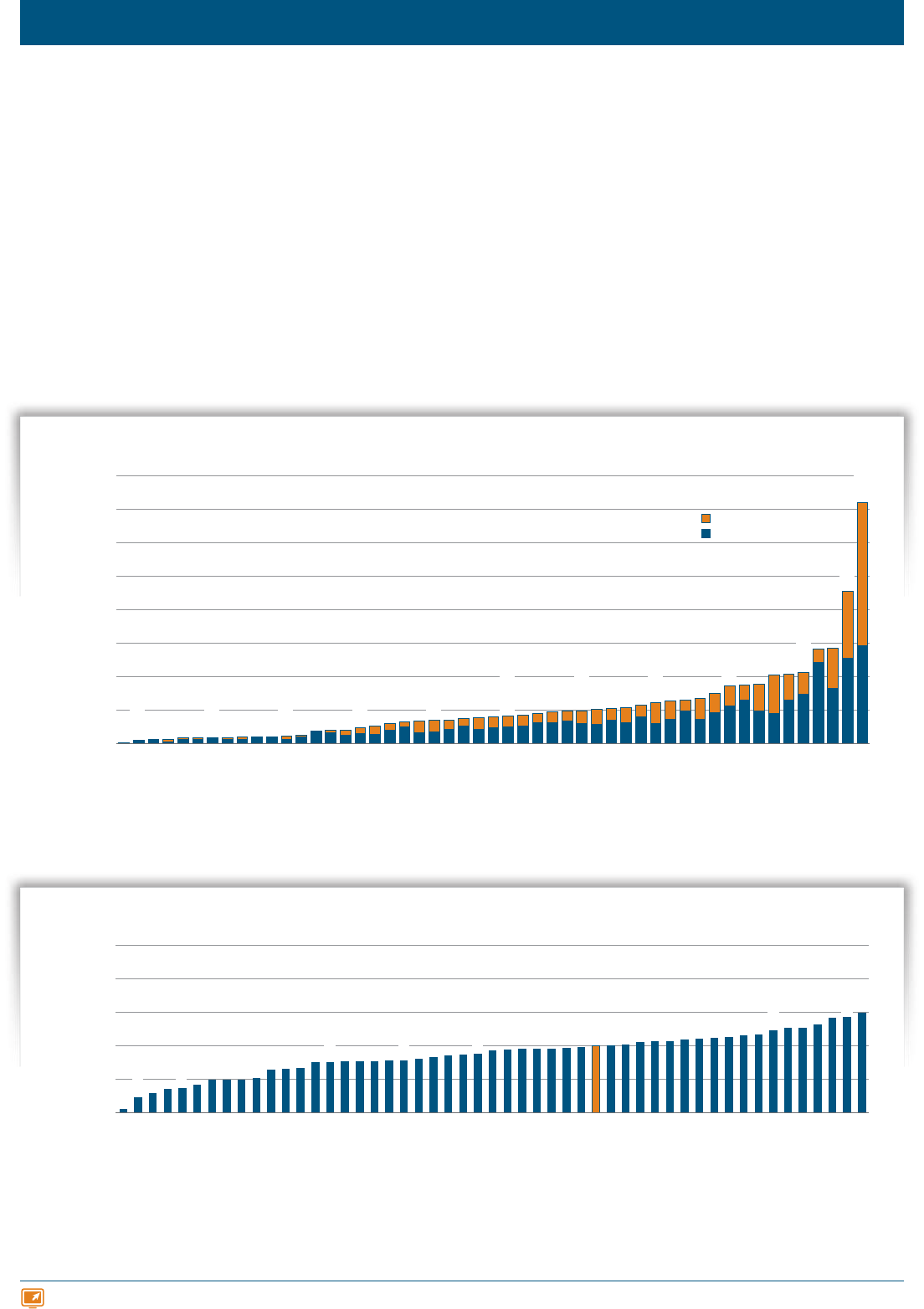
TRENDS IN HIGHER EDUCATION SERIES TRENDS IN COLLEGE PRICING 2012 31
For detailed data behind the graphs and additional information, please visit: trends.collegeboard.org.
Enrollment by State
NOTE: All of the students not included in the percentages reported in Figure 22B are enrolled in public four-year colleges and universities.
SOURCE: NCES, Digest of Education Statistics 2011, Table 224.
In fall 2010, 13% of all full‑time equivalent (FTE) enrollment in degree‑granting public institutions in
the U.S. was in California colleges and universities. This included 9% of students in public four‑year
institutions and 20% of those in public two‑year colleges.
•Four states — California, Texas, Florida,
and New York — enrolled one-third
of all FTE students attending public
institutions in the United States in fall
2010. These states enrolled 29% of
four-year and 36% of two-year public
students in the nation.
•Some state public higher education
systems rely almost exclusively on four-
year institutions, while in other states,
many students enroll in community
colleges. In fall 2010, 60% of California’s
public FTE enrollments, but only 2% of
Alaska’s, were in community colleges.
•In six states, over 50% of public FTE
enrollments were in public two-year
colleges in 2010. In nine states, that
percentage was below 20%.
FIGURE 22B Percentage of All Public Full-Time Equivalent (FTE) Enrollment in Two-Year Colleges, byState, Fall2010
FIGURE 22A Full-Time Equivalent (FTE) Enrollment in Public Degree-Granting Institutions by State, Fall 2010
Fall Enrollment
State
0
200,000
400,000
600,000
800,000
1,000,000
1,200,000
1,400,000
1,600,000
Two-Year
Four-Year
California
Texas
New York
Florida
Ohio
Michigan
Illinois
North Carolina
Pennsylvania
Georgia
Virginia
New Jersey
Indiana
Washington
Arizona
Wisconsin
Maryland
Alabama
Minnesota
Missouri
Colorado
Tennessee
Louisiana
Kentucky
Massachusetts
South Carolina
Oregon
Oklahoma
Kansas
Mississippi
Iowa
Utah
Arkansas
New Mexico
Connecticut
Nebraska
West Virginia
Nevada
Idaho
Hawaii
Montana
North Dakota
Maine
New Hampshire
South Dakota
Delaware
Rhode Island
Wyoming
Vermont
Alaska
District of Columbia
3,964
34,976
92,445
162,426
195,384
242,986
423,768
1,441,175
20,975
911,180
41,922
136,857
342,835
0%
20%
40%
60%
80%
100%
Percentage
State
Ohio
California
Wyoming
Illinois
Iowa
Arizona
Mississippi
New Mexico
New Jersey
Oregon
North Carolina
Texas
Minnesota
Washington
Hawaii
New York
South Carolina
Maryland
Massachusetts
United States
Kansas
Kentucky
Missouri
Nebraska
Virginia
Michigan
Connecticut
Arkansas
Georgia
Tennessee
Alabama
Rhode Island
Colorado
Maine
Oklahoma
Delaware
Wisconsin
Louisiana
Pennsylvania
New Hampshire
Indiana
Utah
West Virginia
Idaho
Montana
South Dakota
Vermont
Florida
North Dakota
Nevada
Alaska
2%
14%
21%
31%
38%
40%
41%
49%
60%
9%
57%
30%
35%
44%
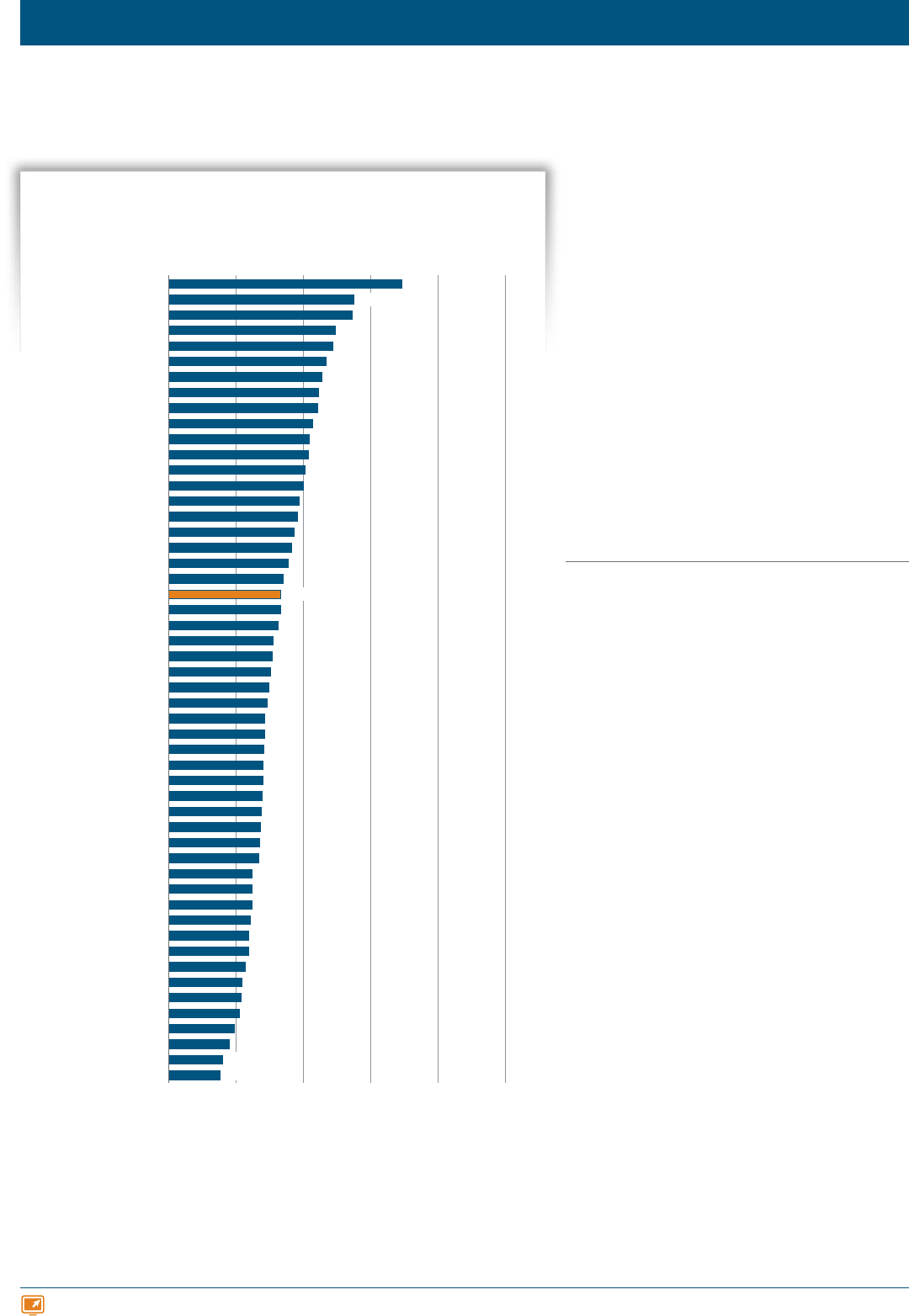
32 TRENDS IN COLLEGE PRICING 2012 trends.collegeboard.org
For detailed data behind the graphs and additional information, please visit: trends.collegeboard.org.
Changes in Enrollment by State
SOURCE: NCES, Digest of Education Statistics 2011, Table 228.
Over the decade from fall 2000 to fall
2010, total full‑time equivalent (FTE)
enrollment in public two‑year and four‑
year institutions grew by 69% (from
202,600 to 342,800) in Georgia and by
55% (from 48,100 to 74,600) in Nevada.
The lowest growth rates were 15% in
Louisiana (from 153,500 to 176,700) and
16% in Illinois (from 351,100 to 406,700).
•Of the 2.75 million new FTE enrollments in
public institutions in the United States between
2000 and 2010, 19% were in Texas, 9% were in
California, and 7% were in Florida. Georgia and
New York each contributed 5%.
ALSO IMPORTANT:
•The balance between two-year and four-year college
enrollments changed markedly over the decade
in some states. In Indiana, Kentucky, Maine, and
West Virginia, where enrollment in public two-year
institutions more than doubled over the decade, growth
in public four-year enrollment was below the national
average. In Maine and West Virginia, growth in the
four-year sector was slow enough that the total public
enrollment grew more slowly than the national average.
•FTE enrollments in public two-year colleges declined
over the decade in Alaska, Florida, Nevada, North
Dakota, and Washington, all of which had higher than
average growth in the public four-year sector. With
the exception of Alaska, all of these states saw some
public two-year institutions being reclassied as public
four-year institutions between 2000 and 2010.
FIGURE 23
Percentage Increases in Total Full-Time Equivalent (FTE) Enrollment in Public
Degree-Granting Institutions Between Fall 2000 and Fall 2010, by State
0% 20% 40% 60% 80% 100%
State
Percentage Increase
Louisiana
Illinois
District of Columbia
Rhode Island
Kansas
Delaware
California
Wisconsin
Nebraska
Idaho
Tennessee
South Dakota
Alaska
Montana
Michigan
Washington
Wyoming
Iowa
Minnesota
Maine
North Dakota
Colorado
Oklahoma
Massachusetts
West Virginia
Pennsylvania
New York
Alabama
Hawaii
Mississippi
New Hampshire
United States
Missouri
Virginia
Connecticut
Ohio
South Carolina
Maryland
Vermont
Arizona
New Jersey
Indiana
Utah
Kentucky
Oregon
Texas
New Mexico
North Carolina
Arkansas
Florida
Nevada
Georgia
69%
49%
39%
33%
31%
28%
27%
23%
15%
55%
16%
43%
25%

TRENDS IN HIGHER EDUCATION SERIES TRENDS IN COLLEGE PRICING 2012 33
For detailed data behind the graphs and additional information, please visit: trends.collegeboard.org.
Migration
FIGURE 24A
Percentage of First-Time First-Year Students in U.S. Degree-Granting
Institutions Who Were from the State Where They Enrolled, Fall 2000 to
Fall2010
SOURCES: NCES, Digest of Education Statistics 2011, Table 232; 2009, Table 222; 2008, Table
223; 2005, Table 202; 2004, Table 203; 2003, Table 206.
NOTE: Includes rst-time undergraduate students enrolled in all degree-granting institutions.
SOURCE: NCES, Digest of Education Statistics 2011, Table 232.
The percentage of rst‑time undergraduate students (including international students) who were
enrolled in institutions in their state of residence declined from 82.2% in fall 2000 to 81.1% in 2004 and
79.9% in 2008. The percentage rose to 81.4% in 2010.
•In fall 2010, when 81% of U.S. students were
enrolled in their state of residence, the same was
true for only 36% of students enrolled in Vermont
and 44% in Rhode Island. In contrast, 92% of
students enrolled in California, Texas, and New
Jersey were state residents.
ALSO IMPORTANT:
•Some states have high levels of net in-migration of
students. For example, in fall 2010, 39,500 out-of-state
residents came to Pennsylvania to begin college and
about half of that number of state residents (19,300)
went elsewhere to study. In West Virginia, 9,300 out-of-
state residents enrolled and only 22% as many (2,000)
left the state.
•Other states have high levels of net out-migration of
students. For example, in fall 2010, 35,000 New Jersey
residents left the state to begin college — over six
times as many as the 5,500 who came to New Jersey
to study.
•Only 53% of Vermont residents beginning college in fall
2010 stayed in Vermont for college, compared to 93%
of Utah residents.
FIGURE 24B Percentage of First-Time First-Year Students in Degree-Granting Institutions Who Were from the State
Where They Enrolled, by State, Fall 2010
The gap between the percentages reported in Figure 24B and 100% corresponds to the percentage of students enrolled in the state who are
residents of other states or other countries. These gures do not necessarily correspond to the percentage of state residents who stay in the
state to study.
0%
20%
40%
60%
80%
100%
Percentage of Students Enrolled
State
New Jersey
Texas
California
Nevada
Michigan
Louisiana
Ohio
Mississippi
Florida
Tennessee
Washington
Georgia
North Carolina
Illinois
Alaska
Kentucky
New Mexico
Arkansas
Nebraska
United States
Wisconsin
Maryland
Hawaii
New York
Missouri
Indiana
Oklahoma
Kansas
Minnesota
South Carolina
Colorado
Utah
Virginia
Oregon
Alabama
Maine
Montana
Pennsylvania
Arizona
Connecticut
Idaho
South Dakota
Massachusetts
Wyoming
Iowa
Delaware
West Virginia
New Hampshire
North Dakota
Rhode Island
Vermont
District of Columbia
8%
63%
73%
76%
81%
81%
83%
85%
92%
36%
92%
44%
55%
80%
82%
92%
Year
Percentage
0%
70%
75%
80%
85%
90%
81.4%
79.9%
80.5%
81.1%
81.6%
82.2%
201020082006200420022000
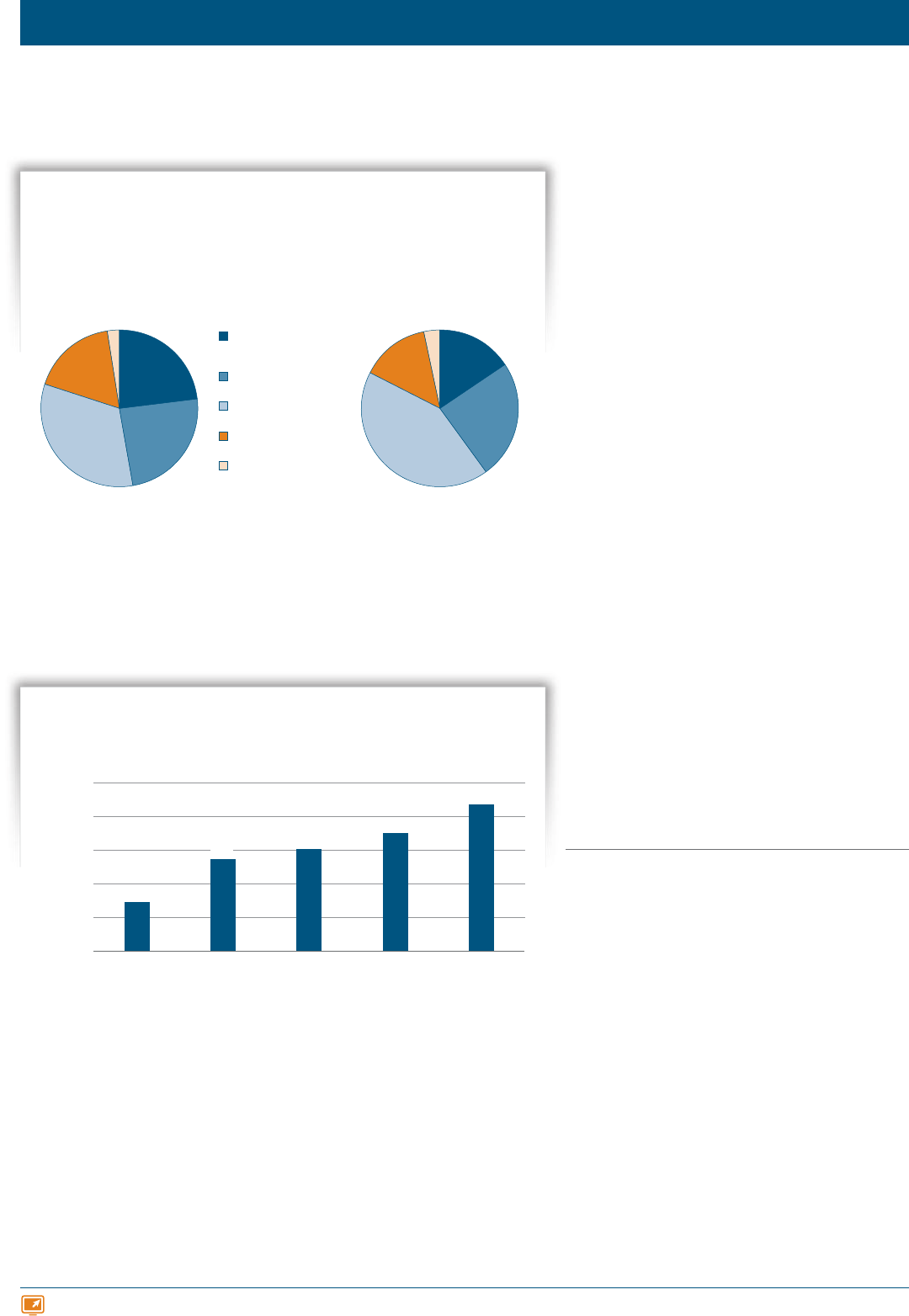
34 TRENDS IN COLLEGE PRICING 2012 trends.collegeboard.org
For detailed data behind the graphs and additional information, please visit: trends.collegeboard.org.
Selectivity and Completion
In 2010, only 2% of four‑year degree‑
granting colleges and universities in
the U.S. (60 out of 2,421) accepted less
than 25% of their applicants. Three
percent of FTE undergraduate students
were enrolled at these institutions. The
47% of four‑year institutions that were
open admission or accepted at least
75% of their applicants accounted for
40% of all FTE enrollments.
•Part-time students are disproportionately enrolled
in open-admission institutions, which enrolled
35% of all part-time undergraduates in four-year
institutions in fall 2010, compared to 16% of
full-time students.
•Institutional selectivity is highly correlated with
graduation rates. Only 29% of full-time students
who began at open-admission institutions in
2004 and 55% of those who began at institutions
accepting at least 75% of their applicants earned
degrees at their rst institution within six years.
•At the most selective four-year institutions,
where students have strong academic
preparation, 87% of full-time students who
began their studies in 2004 had completed four-
year degrees at their rst institution by fall 2010.
ALSO IMPORTANT:
•The graduation rates reported here are from the IPEDS
data, which measure degree completion of only rst-
time full-time students at the institution in which they
rst enrolled. Part-time and returning students are
excluded. Students who transfer to other institutions
are not counted as graduates.
•In fall 2010, there were 1,628 two-year degree-granting
institutions in the U.S., including 977 in the public two-
year sector, 80 in the private nonprot sector, and 571
in the for-prot sector. Among full-time students who
began their studies at these institutions in fall 2007,
20%, 51%, and 60% had earned associate degrees
or short-term certicates by 2010 at their original
institution in the three sectors, respectively. (NCES,
TheCondition of Education 2012, Table A-36-2)
FIGURE 25A
Percentage Distribution of Four-Year
Degree-Granting Undergraduate
Institutions by Acceptance Rate,
Fall2010
FIGURE 25B
Percentage Distribution of Full-Time
Equivalent (FTE) Undergraduate
Enrollment at Four-Year Degree-
Granting Institutions by Acceptance
Rate, Fall2010
FIGURE 25C
Overall 6-Year Graduation Rate (by Fall 2010) of 2004 Cohort at Four-Year
Institutions by Acceptance Rate of Institution
50 to 74.9% Accepted
75% or More Accepted
Open Admission
(No Application Criteria)
Less than 25% Accepted
25 to 49.9% Accepted
3%
24%
14%
42%
16%
2%
24%
17%
33%
23%
Acceptance Rate
Graduation Rate
0%
20%
40%
60%
80%
100%
Less than 25%
Accepted
25 to 49.9%
Accepted
50 to 74.9%
Accepted
75% or More
Accepted
Open
Admission
(No Application
Criteria)
55%
29%
70%
61%
87%
SOURCE: NCES, The Condition of Education 2012, Indicator A-36-2.
SOURCE: NCES, The Condition of Education
2012, Indicator A-36-2.
SOURCES: NCES, IPEDS Enrollment Data,
Fall2010; calculations by the authors.

TRENDS IN HIGHER EDUCATION SERIES TRENDS IN COLLEGE PRICING 2012 35
For detailed data behind the graphs and additional information, please visit: trends.collegeboard.org.
Faculty and Staff
In both public and private colleges
and universities, the percentage of
employees who were instructional staff
members was slightly higher in 2011
than in 1976, 1999, and 2009.
•The numbers of both instructional and other staff
per 100 FTE students declined between 1999
and 2009 in both public and private colleges and
universities. Between 2009 and 2011, the staff-
to-student ratio increased in the private sector,
but not in the public sector.
•Between 1976 and 1999, the staff-to-student
ratios increased in both public and private
institutions and the percentage of all staff
devoted to instruction decreased, but these
trends did not continue in the following decade.
•The percentage of FTE staff classied as
nonprofessional, noninstructional declined from
45% in 1976 to 29% in 2011 in public institutions,
and from 46% to 25% in private institutions. The
percentage classied as “other” professional
staff increased commensurately, without major
changes in the share of employees who were in
either the executive/administrative/managerial or
instructional categories.
•The growing “other professionals” category
includes student, academic, and institutional
support functions that require a bachelor’s
degree or comparable experience. Examples
of the many job titles in this category include
human resources specialists, accountants and
auditors, computer specialists, counselors,
librarians, and coaches.
•Graduate assistants constituted 6% of the FTE
instructional staff in private institutions in 2011
(2% of total staff, with faculty at 35%) compared
to 13% of the FTE instructional staff in public
institutions (5% of total staff, with faculty at
35%). In both sectors, the number of graduate
assistants is low by historical standards.
FIGURE 26A
Number of Full-Time Equivalent (FTE) Staff per 100 FTE Students in Degree-
Granting Institutions (with Instructional Staff as a Percentage of Total Staff),
Fall1976, Fall1999, Fall2009, and Fall2011
FIGURE 26B
Composition of FTE Staff in Degree-Granting Institutions, Fall1976, Fall1999,
Fall2009, and Fall2011
NOTE: Percentages may not sum to 100 because of rounding.
SOURCES: NCES, Digest of Education Statistics 2011, Table 258; NCES, Employees in
Postsecondary Institutions, Fall 2011 and Student Financial Aid, Academic Year 2010-11, Table 1.
NOTE: Public sector numbers comprise two-year and four-year institutions; private sector
numbers include nonprot and for-prot institutions. Numbers in parentheses on the
horizontal axis indicate instructional staff as a percentage of total staff. Instructional staff
includes faculty and graduate assistants.
SOURCES: NCES, Digest of Education Statistics 2011, Table 258; NCES, Employees in
Postsecondary Institutions, Fall 2011 and Student Financial Aid, Academic Year 2010-11, Table 1.
Staff per 100 FTE Students
Sector
PrivatePublic
5
15
25
0
10
20
30
Other
Instructional
2011
(38%)
2009
(37%)
1999
(34%)
1976
(36%)
2011
(40%)
2009
(39%)
1999
(38%)
1976
(39%)
6.6
7.3
6.8
8.3
8.4
7.9
10.6
12.0
10.6
14.6
16.7
13.5
7.0
10.3
8.7
14.5
Sector and Year
Percentage of Staff
0% 20% 40% 60% 80%
100%
Public Private
Nonprofessional
Staff
Other
Professionals
Executive/
Administrative/
Managerial
Graduate
Assistants
Faculty
1976
1999
2009
2011
1976
1999
2009
2011
33%
33%
33%
35%
32%
31%
34%
35%
6%
5%
6%
5%
4%
2%
3%
2%
5%
5%
6%
6%
9%
10%
11%
12%
11%
21%
25%
25%
9%
21%
24%
25%
45%
36%
30%
29%
46%
36%
27%
25%
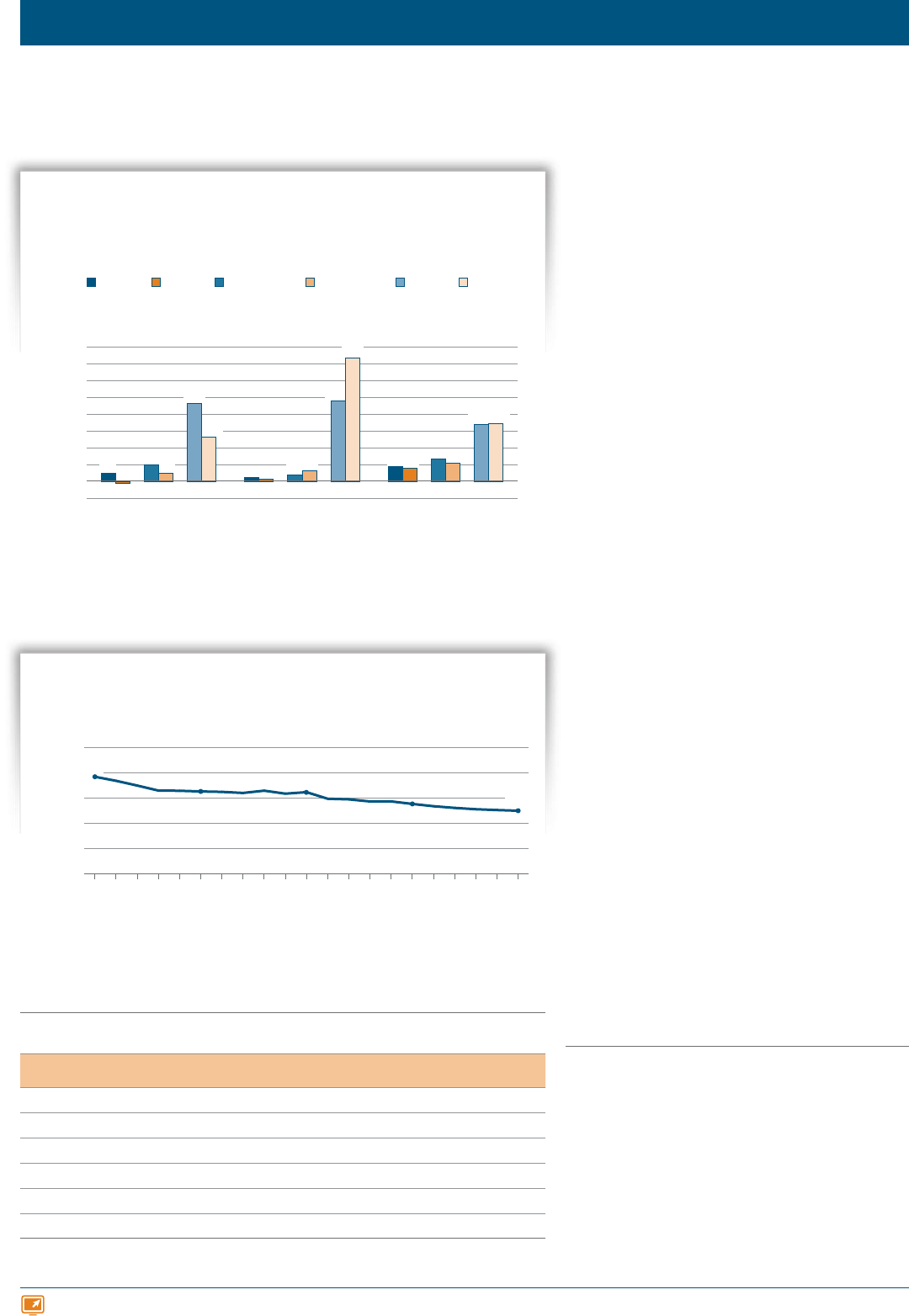
36 TRENDS IN COLLEGE PRICING 2012 trends.collegeboard.org
For detailed data behind the graphs and additional information, please visit: trends.collegeboard.org.
Faculty and Staff
Between 1999‑2000 and 2010‑11, while
published tuition and fees rose rapidly,
average salaries for full‑time faculty
at public two‑year colleges declined
by 1% in constant dollars. Average
salaries rose by 2% at public four‑year
institutions and by 8% (a rate of 0.8%
per year) at private nonprot four‑year
institutions.
•Because the cost of fringe benets such as
health insurance, retirement plans, medical/
dental plans, and group life insurance has grown
much more rapidly than salaries, average total
compensation increased more than average
salaries in each sector over the time periods
shown in Figure 27A.
•The percentage of instructional faculty in degree-
granting institutions employed full-time declined
from 77% in 1971 to 65% in 1981 (a decade
of considerable growth in the public two-year
sector) and remained at about the same level
through 1991. By 2001, the percentage of faculty
employed full-time had declined to 56% and by
2011, it was down to 50%.
•In 2011-12, 50% of faculty in all degree-granting
institutions were employed full-time, with the
percentage ranging from 14% in for-prot four-
year institutions to 30% in public two-year
colleges and 66% in public four-year universities.
•Because all graduate assistants are part-time,
including graduate assistants reduces the
percentage of instructors employed full-time
from 66% to 45% in public four-year institutions
and from 56% to 48% in private nonprot four-
year institutions.
ALSO IMPORTANT:
•In 2009-10, instructional salaries and wages accounted
for 17% of total expenditures at public four-year
universities and 25% of total expenditures at public
two-year colleges. (NCES, Digest of Education
Statistics 2011, Table 377)
FIGURE 27A
Percentage Changes in Ination-Adjusted Average Full-Time Faculty Salary,
Average Total Compensation, and Average Published Tuition and Fees, bySector,
1989-90 to 1999-2000 and 1999-2000 to 2010-11
FIGURE 27B
Percentage of Instructional Faculty in Degree-Granting Postsecondary Institutions
Employed Full-Time, Fall 1971 to Fall 2011
NOTE: Graduate student teaching assistants are not included. For years through 1995, the
denition of higher education institutions is slightly different from the denition in later years.
SOURCES: NCES, Digest of Education Statistics 2011, Table 263; NCES, Employees in
Postsecondary Institutions, Fall 2010, and Salaries of Full-time Instructional Staff, 2010-11, Table1.
SOURCES: NCES, The Condition of Education 2012, Tables A-44-1 and A-44-2; The College
Board, Trends in College Pricing 2012, Table 2; calculations by the authors.
Percentage Change
-10%
10%
30%
50%
70%
0%
20%
40%
60%
80%
Tuition
and Fees
1999-2000
to 2010-11
Tuition
and Fees
1989-90 to
1999-2000
Compensation
1999-2000
to 2010-11
Compensation
1989-90 to
1999-2000
Salary
1999-2000
to 2010-11
Salary
1989-90 to
1999-2000
Private Nonprot Four-YearPublic Four-Year
Sector
Public Two-Year
5%
2%
9%
-1%
2%
8%
10%
4%
13%
5%
6%
11%
46%
48%
34%
27%
73%
34%
Percentage
Year
0%
20%
40%
60%
80%
100%
201120092007200520032001199919971995199319911989198719851983198119791977197519731971
77%
65%
65%
56%
50%
Percentage of Instructional Faculty in Degree-Granting Postsecondary Institutions
Employed Full-Time, Fall 2011
Fall 2011
Percentage of
Faculty Full-Time
Percentage of Faculty Plus
Graduate Assistants Full-Time
All 50% 41%
Public Four-Year 66% 45%
Public Two-Year 30% 30%
Private Nonprot Four-Year 56% 48%
For-Prot Four-Year 14% 14%
For-Prot Two-Year 44% 44%
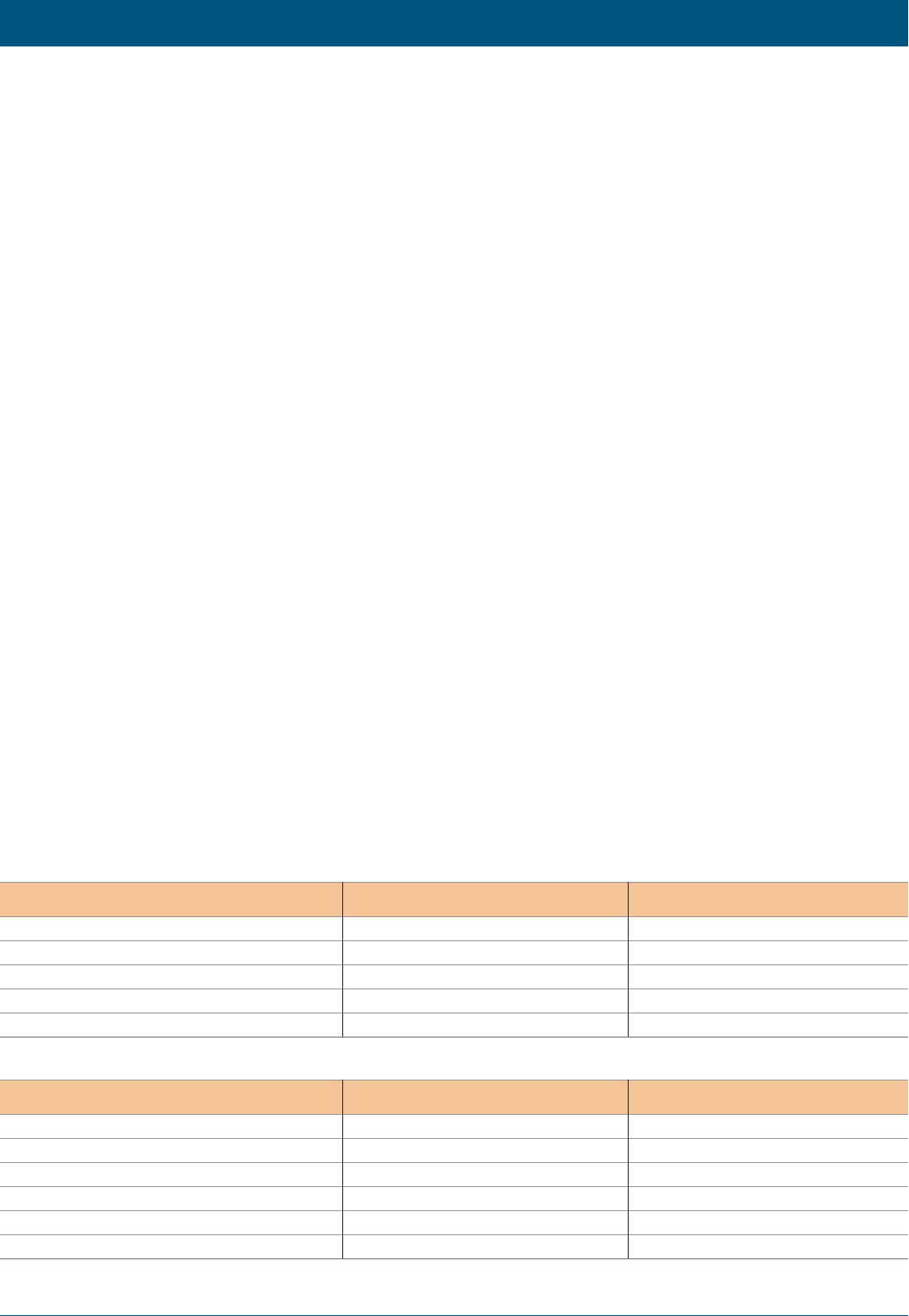
TRENDS IN HIGHER EDUCATION SERIES TRENDS IN COLLEGE PRICING 2012 37
Notes and Sources
THE ANNUAL SURVEY OF COLLEGES
Prices described in this report are based on data reported to the
College Board by colleges and universities in the Annual Survey of
Colleges. Data for 2012-13 are from an online questionnaire distributed
in October 2011, with data collected and reviewed through early
September 2012. Tuition and fee gures are based on charges to full-
time students over the course of a nine-month academic year of 30
semester hours or 45 quarter hours. For those institutions with tuition
and fees that vary by year of study, weighted average undergraduate
tuition levels are used in the analysis. We are not able to estimate
differences in tuition and fees by program, but rely on average prices
reported by institutions.
ENROLLMENT-WEIGHTED AND UNWEIGHTED
DATA
This report provides enrollment-weighted average prices. Charges
reported by colleges with larger full-time enrollments are weighted
more heavily than those of institutions with smaller enrollments.
As a snapshot, neither set of averages is more or less correct than
the other; they describe different phenomena. The weighted averages
may be more helpful to students and families in anticipating future
education expenses. Some researchers, policy analysts, and academic
administrators nd the unweighted averages useful in studying
longitudinal trends and evaluating a particular institution’s practices
against a larger set. Thus, the College Board computes both weighted
and unweighted averages. Tables reporting unweighted tuition data can
be found online at trends.collegeboard.org.
The most recent enrollment data available are for fall 2011. For 2011-12
and earlier years, prices are weighted by same-year enrollments. For
2012-13, prices are weighted by fall 2011 enrollments. In other words,
the percentage changes reported in Tables 1A and 1B reect only price
changes, not changes in enrollment patterns. In contrast, the historical
data on changes in enrollment-weighted prices reported in Tables 2A
and 2B reect changes in both prices and in the distribution of full-time
students across institutions.
Weighted averages for each price are based on relevant populations:
•In-state tuition and fees are weighted by full-time undergraduate
enrollment.
•Out-of-state tuition and fees are calculated by adding the nonresident
premium, weighted by full-time out-of-state enrollment, to average
in-state tuition and fees. Data on out-of-state students receiving a
waiver of some or all of the tuition premium are not available.
•Resident room and board are weighted by the number of
undergraduates living in campus housing at each institution.
•Out-of-district charges for public two-year college students are not
accounted for in the average prices reported here.
•Estimated other student budget components are weighted as follows:
– Books and supplies are weighted by full-time undergraduate
enrollment.
– Resident transportation and other resident costs are weighted by
the number of undergraduates living in campus housing.
– Commuter room and board, commuter transportation, and other
commuter costs are weighted by the number of commuting
undergraduates at each institution, reecting the expenses of
commuters.
INSTITUTIONS INCLUDED IN CALCULATIONS
Out of the 3,775 public two-year, public four-year, private nonprot
four-year, and for-prot institutions that were surveyed in both 2011
and 2012, 3,125 were included in this year’s analysis, including over
97%of the surveyed schools in the public and private nonprot sectors
and 39% of those in the for-prot sector. Our imputation process
allows us to include schools for which we are missing one year of
data. We exclude from our calculations military academies and other
institutions that report zero tuition. Tables A1A and A1B describe the
institutions that were included in this analysis, by sector and Carnegie
Classication, respectively.
TABLE A1A Institutions Included in Tuition and Fees (T&F) Analysis in Table 1A
Sector
Number of Institutions Surveyed
in Both 2011 and 2012 Institutions Included in T&F Analysis
Institutions in Analysis with
Projected/Imputed T&F for Either Year
Public Two-Year 1,008 997 99% 21 2%
Public Four-Year 582 571 98% 17 3%
Private Nonprot Four-Year 1,224 1,182 97% 12 1%
For-Prot 961 375 39% 31 8%
Total 3,775 3,125 83% 81 3%
TABLE A1B Institutions Included in Tuition and Fees (T&F) Analysis in Table 1B
Carnegie Classication
Number of Institutions Surveyed
in Both 2011 and 2012 Institutions Included in T&F Analysis
Institutions in Analysis with
Projected/Imputed T&F for Either Year
Public Doctoral In-State 175 175 100% 3 2%
Public Master’s In-State 266 265 100% 10 4%
Public Bachelor’s In-State 134 128 96% 1 1%
Private Doctoral 104 103 99% 0 0%
Private Master’s 360 354 98% 3 1%
Private Bachelor’s 508 498 98% 4 1%

38 TRENDS IN COLLEGE PRICING 2012 trends.collegeboard.org
REVISION OF BASE-YEAR VALUES
The prices for 2011-12 used in this analysis differ somewhat from the
2011-12 averages reported last year. One factor contributing to the
revision is the reweighting of the prices, shifting from fall 2010 to fall
2011 full-time enrollment gures. The base-year numbers also shift
because several hundred institutions submit revised tuition gures for
the previous year. The recomputed average for 2011-12 tuition and fees
at public four-year institutions is $12 higher than the level we reported
last year for in-state students and $53 higher for out-of-state students.
The recomputed average for 2011-12 tuition and fees is $4 lower than
the level we reported last year for public two-year institutions.
This year, we have included additional institutions in the private nonprot
four-year sector in our analysis. These institutions tend to be small and
charge lower-than-average tuition and fees. As a result, the recomputed
average for 2011-12 tuition and fees is $617 lower than the level we
reported last year for the private nonprot four-year sector. Our estimate
of the average 2011-12 price for for-prot students is $250 higher than it
was last year because of changes in full-time enrollment and changes in
the number of institutions included in the calculations.
LONGITUDINAL DATA
In Tables 2A and 2B, tuition averages from years prior to 1987-88 are
extracted from the Integrated Postsecondary Education Data System
(IPEDS). The two data sets, IPEDS and the College Board’s Annual
Survey of Colleges, track very closely, but IPEDS averages are weighted
by full-time equivalent enrollments, while the Annual Survey of Colleges
prices are weighted by full-time enrollments. Annual historical data are
available online at trends.collegeboard.org.
NET PRICE CALCULATIONS
The calculations of average net price in Figures 9 and 10 for full-time
undergraduate students are a best approximation and are based on the
aggregate amounts of each type of aid reported in Trends in Student
Aid 2012 and on the allocation of each type of aid across institution
types and between part-time and full-time students reported in 1993,
1996, 2000, 2004, and 2008 National Postsecondary Student Aid Study
(NPSAS) data. The distribution of aid for 2009-10 and after was modied
to account for the large increase in Pell Grants in 2009-10. Because
nancial aid data for 2012-13 are not yet available, amounts for that
year are estimated based on past years and information about changes
in grant policies. Total charges for public two-year students include an
estimate of housing and food expenses for students not living with their
parents, based on commuter room and board expenses reported by
institutions when available and derived from public four-year room and
board charges for earlier years in the analysis. The net price estimates
reported here are not exactly comparable to those that appeared in 2011
because some gures have been updated.
Net price and grant totals in Figures 9 and 10 are not comparable to
those in Figures 11A and 11B, which are based on the IPEDS Delta
Cost Data and focus on institutional revenues rather than prices. While
Figures 9 and 10 focus on full-time undergraduate students, Figures 11A
and 11B cover revenues paid by all students — full-time and part-time,
in-state and out-of-state, graduate and undergraduate. Furthermore,
Figures 9 and 10 include grants from private sources and federal tax
benets, while Figures 11A and 11B do not.
INSTITUTIONAL REVENUES AND EXPENDITURES
Figures 11A–B, 14A–C, and 15A–B are based on data from the IPEDS
Delta Cost Data. Delta data combine IPEDS data with information
from the Financial Institution Shared Assessment Program database
beginning in 1994. Further details and the entire database are available
at nces.ed.gov/ipeds/deltacostproject/.
ENDOWMENTS
Data on endowments are from the National Association of College and
University Business Ofcers (NACUBO) and Commonfund Institute,
supplemented by data from IPEDS for institutions for which NACUBO
or Commonfund data are not available. Public university foundation
endowment assets are included.
INFLATION ADJUSTMENT
The Consumer Price Index for all urban consumers (CPI-U) is used to
adjust for ination. We use the CPI-U in July of the year in which the
academic year begins. See ftp://ftp.bls.gov/pub/special.requests/cpi/
cpiai.txt for changes in the CPI-U over time. Table A2 provides CPI data
for 2002 through 2012. Additional historical data are available online. The
Factor column provides the user with a multiplication factor equal to
that of CPI (base year, say 2012) divided by CPI (current year). A simple
multiplication of a current-year gure by the associated factor will yield a
constant-dollar result.
CARNEGIE CLASSIFICATION 2010: BASIC
CLASSIFICATION
This year, we updated our Carnegie Classication with the 2010 update.
For the past few years, we had been using the 2005 edition. The number
of institutions in each Carnegie Classication changed slightly from
2005to the 2010 update, although the classication structure of the
2010 update is the same as that for the 2005 edition.
“Doctoral universities” include institutions that award at least 20doctoral
degrees per year (excluding doctoral degrees that qualify recipients for
entry into professional practice, such as the J.D., M.D., Pharm.D., DPT,
etc.); “master’s colleges and universities” include institutions that award
at least 50 master’s degrees per year; “bachelor’s colleges” include
institutions where bachelor’s degrees represent at least 10% of all
undergraduate degrees and that award fewer than 50master’s degrees
or fewer than 20 doctoral degrees per year. All of the categories above
exclude “special focus institutions” and “tribal colleges.”
TABLE A2 Consumer Price Index-All Urban Consumers, Not
Seasonally Adjusted, All Items, U.S. City Average, 1982-84=100
Academic Year
CPI (as of July at the beginning of
the Academic Year)
Factor Used to Convert
to 2012 Dollars
2002-03 180.1 1.2721
2003-04 183.9 1.2458
2004-05 189.4 1.2096
2005-06 195.4 1.1725
2006-07 203.5 1.1258
2007-08 208.3 1.0999
2008-09 220.0 1.0416
2009-10 215.4 1.0639
2010-11 218.0 1.0509
2011-12 225.9 1.0141
2012-13 229.1 1.0000
See Table A2 online for additional CPI data.

TRENDS IN HIGHER EDUCATION SERIES TRENDS IN COLLEGE PRICING 2012 39
Trends in College Pricing was authored by College Board independent policy
analysts Sandy Baum and Jennifer Ma, with invaluable assistance from
Charles Kurose.
Contact Information for the Authors
Sandy Baum, [email protected]
Jennifer Ma, [email protected]
Trends in College Pricing and its companion report, Trends in Student Aid, are
supplemented by a website that makes detailed data available for reference
and downloading. The PDF versions of these reports, along with PowerPoint
slides of all the graphs, are available on the Web: trends.collegeboard.org.
Hard copies may be ordered by contacting [email protected].
Tables, graphs, and data in this report or excerpts thereof may be reproduced
or cited, for noncommercial purposes only, provided that the following
attribution is included:
Source: Trends in College Pricing.
© 2012 The College Board.
www.collegeboard.org
ACKNOWLEDGMENTS
This publication beneted from comments by Kathleen Little, Kathleen Payea,
and Anne Sturtevant. The publication would not have been possible without
the cooperation and support of many people at the College Board, including
Stan Bernstein and the Annual Survey of Colleges staff, Marilyn Cushman,
Tara Goldman, Carly Lindauer, Annika Many, Christen Pollock, Tom Rudin, and
Leanne Snoeck. We are very grateful to Alicia Broadway, Patti Gildersleeve,
Martha Hoeper, Barbara Kridl, and Leslie Retallick at MPR Associates for their
expert graphic design work.
We thank all of those who contributed to the data collection for this
publication, including institutional research department staff and campus
administrators who provided us with invaluable data through the Annual Survey
of Colleges. We thank Samuel Barbett of the U.S. Department of Education
for providing us with unpublished IPEDS data. We also thank Kenneth Redd of
NACUBO for providing us with the NACUBO endowment data.
DEFINING TERMS
According to the 1997 National Commission on the
Cost of Higher Education, dening “cost,” “price,”
and “subsidy” is critical to clarifying the issues in
nancing postsecondary education.
“Costs” refer to the expenditures associated with
delivering instruction, including physical plant and
salaries.
“Prices” are the expenses that students and
parents face.
“Published price” is the price institutions charge
for tuition and fees as well as room and board,
in the case of students residing on campus. A
full student expense budget also includes books,
supplies, transportation, and other basic living
costs.
“Net price” is what the student and/or family must
cover after grant aid and savings from tax credits
and deductions are subtracted.
“General subsidies” make it possible for
institutions to charge less than the actual costs of
instruction. State, federal, and local appropriations,
as well as private philanthropy, reduce the prices
faced by all students — whether or not they
receive nancial aid.
